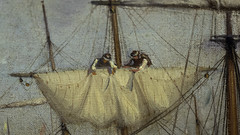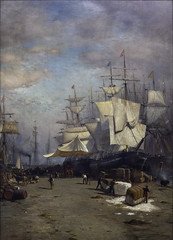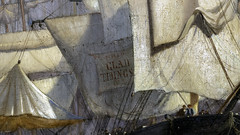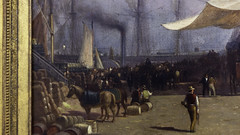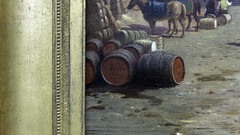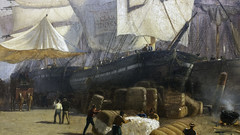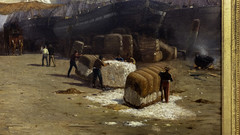11.4: North America c. 1500 - 1900 (II)
- Page ID
- 67098
British colonies and the Early Republic
Early Republic
Gilbert Stuart’s Lansdowne Portrait

A well known image
While the name Gilbert Stuart may be one unknown to most Americans, practically every American is aware of at least one of his paintings. Art historians formally call it the Athenaeum Portrait. Most everyone is familiar with it as the engraved image of George Washington that graces the front of the one-dollar bill. This is one of the dozens of portraits that Stuart painted of our first president. Another, a full-length likeness, is called the Lansdowne Portrait. Although not as famous as its bust-length counterpart, the Lansdowne Portrait retains a place of special significance within the history of American art.
Expat education

On the brink of the American Revolutionary War, Stuart decided it was time to pursue serious artistic instruction, and so, in 1775, he sailed for London and the studio of Benjamin West, whose generosity to his colonial brethren was seemingly endless.
Stuart remained in London for almost twelve years and then relocated to Ireland. He clearly had aspirations of making American versions of European Grand Manner portraits such as the likeness Hyacinthe Rigaud painted of Louis XIV in 1701. After acquiring debts sufficient to necessitate a hasty departure from the Emerald Isle, the artist told a friend about his short-term plans for Ireland and about his anticipated return to the United States:
When I can net a sum sufficient to take me to America, I shall be off to my native soil. There I expect to make a fortune by [portraits of] Washington alone. I calculate upon making a plurality of his portraits, whole lengths, what will enable me to realize; and if I should be fortunate, I will repay my English and Irish creditors. To Ireland and English I shall be adieu.
This was a task easier said than done. Stuart did not personally know the recently elected president, and the artist had been away from his homeland for 18 years.
Letter of introduction
Rather than return to Rhode Island, the state of his birth, he instead sailed for New York City, the home of John Jay, the first Chief Justice of the Supreme Court and a close political confidant to George Washington. Stuart first met Jay in 1782 when the politician was in London negotiating the Treaty of Paris, the accord that officially ended the American Revolutionary War. Stuart arrived in New York City in early May of 1793, and a visit to Jay, one of the few people the painter could have known in Manhattan, must have been amongst Stuart’s first social calls. He painted Jay several times during the months that followed and the politician provided a letter of introduction for the relatively unknown artist to meet the president. Stuart departed New York City for Philadelphia in November 1794.
Philadephia
If painting images of George Washington was the primary reason Stuart returned to the United States, then Philadelphia was certainly the place to be. Stuart wasted little time in calling on Washington, and painted three different kinds of portraits of the president (with dozens of subsequent copies) in the years that followed. In the decades immediately preceding the invention of photography, the myriad of portraits of Washington that Stuart painted created an image Americans accepted as the portrait of their first president. The “Vaughan Type” shows Washington facing slightly to his left, the “Athenaeum Type” shows the first president facing to his right, and the “Lansdowne Type” is a full-length portrait.
Stuart painted six full-length portraits of Washington. The “Lansdowne Type” acquired its name from the owner of the first full-length portrait Stuart painted, William Petty, the first Marquis of Lansdowne. The portrait was a gift from William Bingham, a wealthy Philadelphian merchant and was intended to thank Lord Lansdowne for his financial support of the colonial cause during the American Revolutionary War.
Civilian commander

Given his European training, Stuart was well suited to execute a Grand Manner portrait of America’s first president. However, whereas previous artists such as John Trumbull and Charles Willson Peale emphasized Washington’s position as an officer in the Revolutionary Army, Stuart stressed Washington’s position as a civilian commander in chief. In the Lansdowne Portrait, Washington does not hold a scepter, wear a crown, or sit on a throne. Instead, Stuart filled the eight-foot tall composition with elements symbolic to the new republic. He wears an American made black velvet suit, one similar in fabric, cut, and color to one he frequently wore on public occasions. Washington raises his right arm in a classically inspired oratorical pose, while his left hand grasps a ceremonial sword. The President stands before a portico-like space, complete with two pairs of columns and a red curtain that has been pulled aside to reveal a background of open sky.

In addition to the architectural setting and the sitter’s pose, other elements within the composition transform the Lansdowne Portrait from a simple likeness of Washington into an official state portrait. The Neo-Classical chair on the right side of the painting contains elements from the Great Seal of the United States. A small oval medallion on the top of the chair is divided in half. The top half contains thirteen white stars in a blue field, and thirteen alternating red and white stripes appear underneath. Two erect eagles are visible on top of the leg of the table, each of which grasps a bundle of arrows, symbols of readiness for war. Underneath the table are several books, titled, General Orders, American Revolution, and Constitution & Laws of the United States that indicate Washington’s past military and political accomplishments. More books, Federalist and Journal of Congress, stand upright on top of the table. A silver inkwell, quill, and several sheets of blank paper can be seen immediately underneath Washington’s outstretched right hand.
Representing the office of the presidency
Without question, Gilbert Stuart’s Lansdowne Portrait of George Washington is far more than a portrait of the first president of the United States of America. It is instead a painting that represents not only Washington’s likeness, but also the aesthetic and political trappings of the office of the presidency and of the New Republic. Utilizing all of the traditions of European Grand Manner portraiture, it became the standard full-length political likeness of Washington throughout the Federalist period.
Additional resources:
This portrait at the National Portrait Gallery
The Landsdowne Portrait on the Google Art Project
Interactive on the painting from the Smithsonian
Information and lesson plan from Picturing America
Gilbert Stuart, The Athenaeum Portrait
Thomas Jefferson, Monticello

A gentleman architect
In an undated note, Thomas Jefferson left clear instructions about what he wanted engraved upon his burial marker:
Here was buried
Thomas Jefferson
Author of the Declaration of American Independence
of the Statute of Virginia for religious freedom
Father of the University of Virginia
Jefferson explained, “because by these, as testimonials that I have lived, I wish most to be remembered.” To be certain, there are important achievements Jefferson neglected. He was also the Governor of Virginia, American minister to France, the first Secretary of State, the third president of the United States, and one of the most accomplished gentleman architects in American history. To quote William Pierson, an architectural historian, “In spite of the fact that his training and resources were those of an amateur, he was able to perform with all the insight and boldness of a high professional.”
Indeed, even had he never entered political life, Jefferson would be remembered today as one of the earliest proponents of neoclassical architecture in the United States. Jefferson believed art was a powerful tool; it could elicit social change, could inspire the public to seek education, and could bring about a general sense of enlightenment for the American public. If Cicero believed that the goals of a skilled orator were to Teach, to Delight, and To Move, Jefferson believed that the scale and public nature of architecture could fulfill these same aspirations.

Return to the classical
Jefferson arrived at the College of William and Mary in 1760 and took an immediate interest in the architecture of the college’s campus and of Williamsburg more broadly. A lifelong book lover, Jefferson began his architectural collection while a student. His first two purchases were James Leoni’s The Architecture of A. Palladio (1715-1720) and James Gibbs’ Rules for Drawing the Several Parts of Architecture (1732).
Although never formally trained as an architect, Jefferson, both while a student and then later in life, expressed dissatisfaction with the architecture that surrounded him in Williamsburg, believing that the Wren-Baroque aesthetic common in colonial Virginia was too British for a North American audience. In an oft-quoted passage from Notes on Virginia (1782), Jefferson critically wrote of the architecture of Williamsburg:
“The College and Hospital are rude, mis-shapen piles, which, but that they have roofs, would be taken for brick-kilns. There are no other public buildings but churches and court-houses, in which no attempts are made at elegance.”
Thus, when Jefferson began to design his own home, he turned not to the architecture then in vogue around the Williamsburg area, but instead to the classically inspired architecture of Antonio Palladio and James Gibbs. Rather than place his plantation house along the bank of a river—as was the norm for Virginia’s landed gentry during the eighteenth century—Jefferson decided instead to place his home, which he named Monticello (Italian for “little mountain”) atop a solitary hill just outside Charlottesville, Virginia.
French Neo-Classicism for an American audience
Construction began in 1768 when the hilltop was first cleared and leveled, and Jefferson moved into the completed South Pavilion two years later. The early phase of Monticello’s construction was largely completed by 1771. Jefferson left both Monticello and the United States in 1784 when he accepted an appointment as America Minister to France. Over the next five years, that is, until September 1789 when Jefferson returned to the United States to serve as Secretary of State under newly elected President Washington, Jefferson had the opportunity to visit Classical and Neoclassical architecture in France.

This time abroad had an enormous effect on Jefferson’s architectural designs. The Virginia State Capitol (1785-1789) is a modified version of the Maison Carrée (16 B.C.E.), a Roman temple Jefferson saw during a visit to Nîmes, France. And although Jefferson never went so far as Rome, the influence that the Pantheon (125 C.E.) had over his Rotunda (begun 1817) at the University of Virginia is so evident it hardly need be mentioned.
Politics largely consumed Jefferson from his return to the United States until the last day of 1793 when he formally resigned from Washington’s cabinet. From this year until 1809, Jefferson diligently redesigned and rebuilt his home, creating in time one of the most recognized private homes in the history of the United States. In it, Jefferson fully integrated the ideals of French neoclassical architecture for an American audience.
In this later construction period, Jefferson fundamentally changed the proportions of Monticello. If the early construction gave the impression of a Palladian two-story pavilion, Jefferson’s later remodeling, based in part on the Hôtel de Salm (1782-87) in Paris, gives the impression of a symmetrical single-story brick home under an austere Doric entablature. The west garden façade—the view that is once again featured on the American nickel—shows Monticello’s most recognized architectural features. The two-column deep extended portico contains Doric columns that support a triangular pediment that is decorated by a semicircular window. Although the short octagonal drum and shallow dome provide Monticello a sense of verticality, the wooden balustrade that circles the roofline provides a powerful sense of horizontality. From the bottom of the building to its top, Monticello is a striking example of French Neoclassical architecture in the United States.

Jefferson changed political parties and was a Democratic-Republican by the time he was elected president. He believed the young United States needed to forge a strong diplomatic relationship with France, a country Jefferson and his political brethren believed were our revolutionary brothers in arms. With this in mind, it is unsurprising that Jefferson designed his own home after the neoclassicism then popular in France, a mode of architecture that was distinct from the style then fashionable in Great Britain. This neoclassicism—with roots in the architecture of ancient Rome—was something Jefferson was able to visit while abroad.
Buildings that speak to democratic ideals
By helping to introduce classical architecture to the United States, Jefferson intended to reinforce the ideals behind the classical past: democracy, education, rationality, civic responsibility. Because he detested the English, Jefferson continually rejected British architectural precedents for those from France. In doing so, Jefferson reinforced the symbolic nature of architecture. Jefferson did not just design a building; he designed a building that eloquently spoke to the democratic ideals of the United States. This is clearly seen in the Virginia State Capitol, in the Rotunda at the University of Virginia, and especially in his own home, Monticello.
Thomas Jefferson, Rotunda, University of Virginia
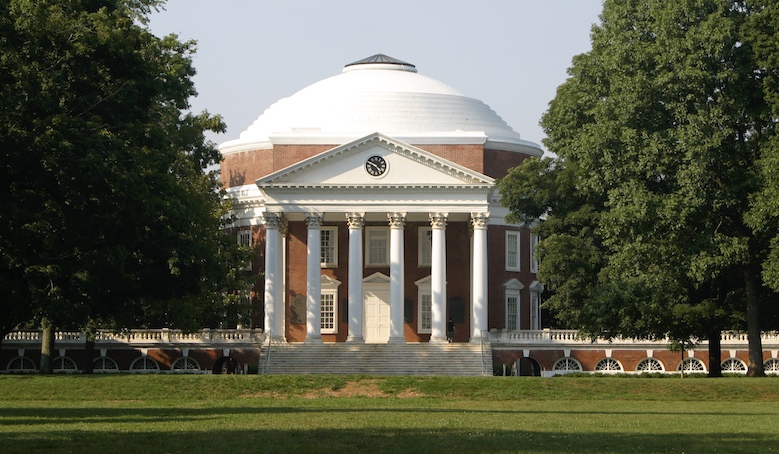
A joke with a kernel of truth
The College of William & Mary in Williamsburg, Virginia is the second oldest university in the United States and was founded in 1693 (only Harvard, founded in 1636, is older). There is a longstanding joke amongst graduates of this institution:
Question: Why did Thomas Jefferson found the University of Virginia?
Answer: His kids could not get into the College of William & Mary.
To be fair, there is some truth to this joke, and then again, there is some misdirection. Thomas Jefferson did, in fact, found the University of Virginia—an achievement of which he was so proud that it is mentioned on his tombstone (whereas he omitted the fact that he was the third president of the United States). But the other part of the joke—that his children could not have been admitted to his alma mater—is a bit misleading. Jefferson’s wife, Martha Wayles, died in 1782. During their ten years of marriage, she bore him six children, only two of whom lived to adulthood. Both of these were women, and as the College of William & Mary did not formally admit female students until 1918, it would have been impossible for Jefferson’s children (those who survived and were legitimate, at least) to enroll in the institution that had educated their father.
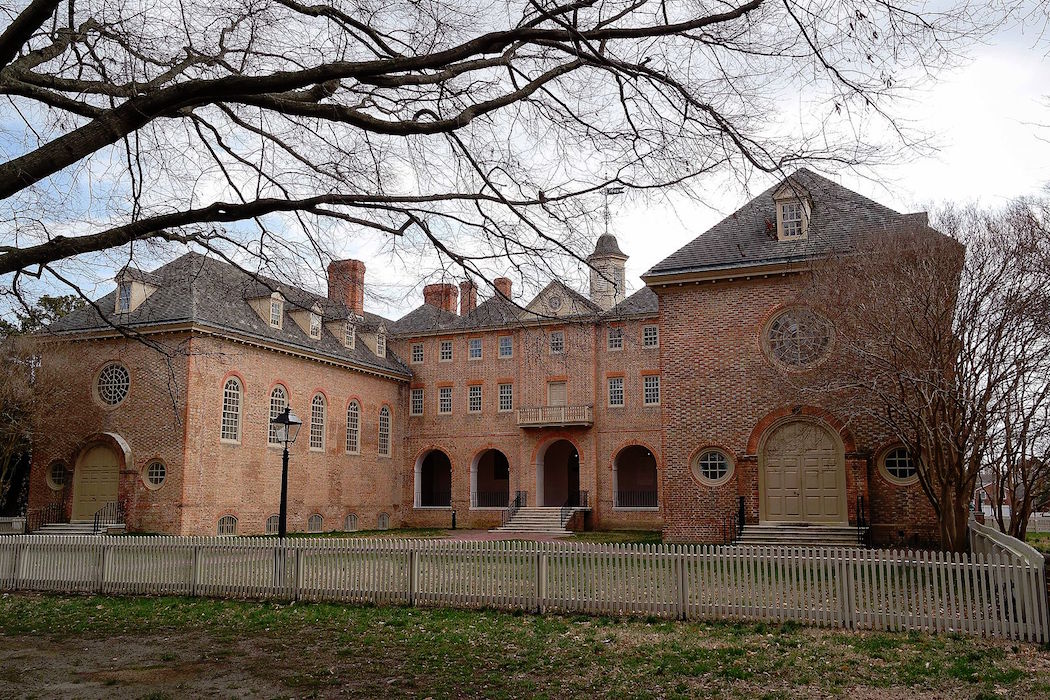
American universities have traditionally begun with a single building and then expanded over time. This was the case of the College of William & Mary; the so-called Wren Building (above) is the oldest surviving university building in the United States. Although originally called simply “The College” or “The Main Building,” it has subsequently come to be named after Sir Christopher Wren, the English baroque architect. In fact, Hugh Jones, the college’s first professor of mathematics wrote in 1722 that Wren himself was the architect: “the building is beautiful and commodious, being first modeled by Sir Christopher Wren…” However, architectural historians do not currently believe that the most accomplished architect in the English-speaking world at the end of the seventeenth century would have made time to design a building on the very fringes of the British Empire.

A preference for the French (over the English)
Although it is unlikely that Wren designed this building at William and Mary College, there can be no doubt that whoever did was strongly influenced by Wren’s Royal Hospital at Chelsea (above). Both buildings have architectural elements that are indicative of late Renaissance and Baroque architecture in England. Both are horizontal in nature with a central pediment and cupola. Moreover, they share a similar fenestration (window) arrangement, and nearly identical dormer windows (windows that project from a sloping roof). For Thomas Jefferson, the Wren Building at the College of William & Mary was a prototype example of English architecture.

And if the political history of the United States tell us anything, it is that Thomas Jefferson did not much care for the English. This is but one of the reasons why his own architectural projects—notably his ancestral home at Monticello and the Virginia State Capitol (left)—were inspired not by English architectural antecedents, but instead by buildings from the classical past. Indeed, the Virginal State Capitol looks much like the Maison Carrée in Nîmes (France), an ancient Roman building Jefferson saw while serving as the American ambassador to France. His own home has a variety of classical (and neoclassical) architectural influences. In the late eighteenth and early nineteenth centuries, the neoclassical style was strongly linked with France—and Jefferson, a Democratic-Republican and strident Francophile, therefore approved.
University of Virginia: an “academical village”
At the conclusion of his political career, Jefferson turned his considerable energies towards two related enterprises: the founding of a university for the state of Virginia, and designing buildings for that institution. Jefferson very much believed in the crucial importance of education. Although an oft-repeated quotation—“An educated citizenry is a vital requisite for our survival as a free people.”—never seems to have come from his pen, it very much encapsulates Jefferson’s views on education. When he set in planning the University of Virginia—an institution founded in 1819 and began to instruct its first class in March 1825—he did so in a revolutionary way. Rather than begin as a single building and expand as needed, Jefferson envisioned—to use his phrase—an entire “academical village” where students and professor lived and learn side by side.
Jefferson designed the initial phase of the university on a symmetrical north-south axis. The longitudinal axes on the east and west sides contain pavilions for the professors, dormitories for the students, and expansive lawns. Indeed, the word “campus”—a word so commonly used to describe the grounds and buildings of a college or university—comes from the Latin word that means field. In this way, what Jefferson designed was one of the first true college campuses, complete with buildings and intentional exterior spaces.
The Rotunda (and the Pantheon)
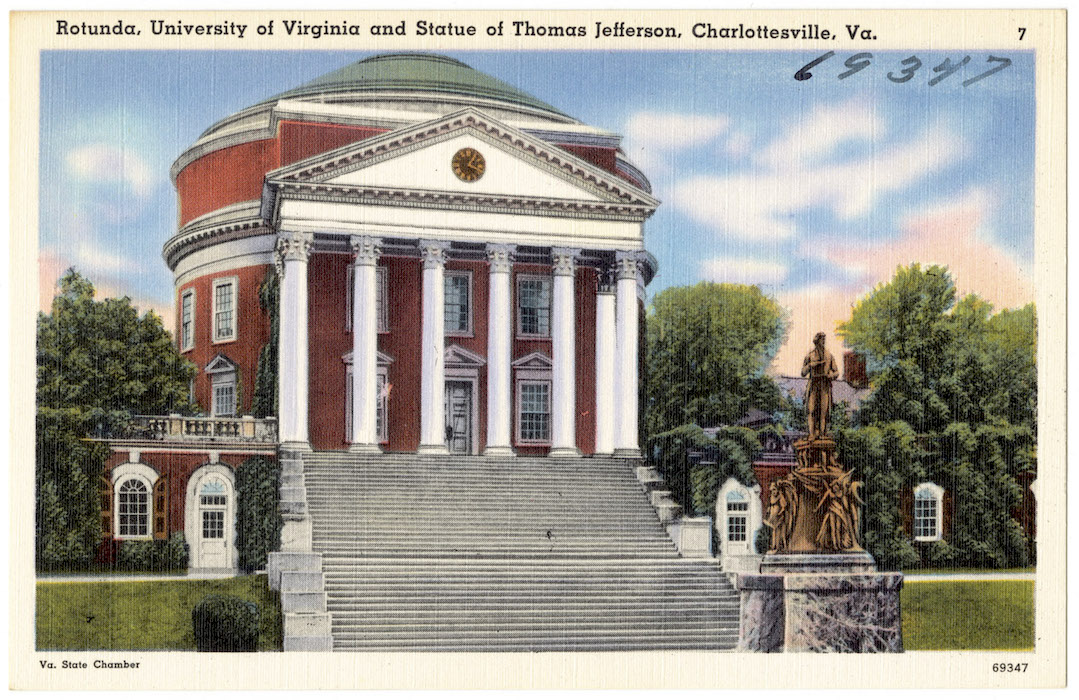
The crowing architectural achievement of the “academical village” at the University of Virginia can be seen at the north end of the campus. Called the Rotunda, it should look immediately familiar to anyone with even a passing knowledge of Western architecture, as Jefferson designed it as a half-sized version of the ancient Roman Pantheon (below). A religious building devoted to all the Roman gods, the Pantheon demonstrates the ways in which Roman architects could take a Classical Greek idea—note the Greek temple front—and combine it with elements that were so spectacularly new that it made the Pantheon architecturally unique for nearly two millennia. Indeed, that uniqueness derives from the innovative “dome on a drum” construction that is so neatly hidden—when viewed from its ideal angle—by the Greek temple front that Roman architects so admired. Moreover, this dome, which opens into a vast interior space crowned by a singular window (or oculus) was made possible through a particularly Roman invention: concrete.

Yet Jefferson knew that his Rotunda was going to serve a different function than the building on which it was based. So, although these two buildings (The Pantheon in Rome and the Rotunda at the University of Virginia) look strikingly similar if you merely look at the architectural forms, they become quite different if one moves beyond initial appearance. Whereas the Pantheon is a religious building—a temple for all the Roman gods when it was created (and subsequently a Catholic church when it was consecrated in 609), Jefferson’s Rotunda has a strictly secular nature. As a member of the Enlightenment, Jefferson’s religious views leaned towards Deism, a belief system that generally acknowledged a Divine Maker, but rejected a belief in revelation. In fact, one of the reasons why Jefferson was keen on founding the University of Virginia was to provide his home state with a secular educational option to the religiously-oriented College of William & Mary. The materials were clearly different as well. While the expansive interior space of the Pantheon was made possible through the perfection of poured concrete, Jefferson used the wood and brick that was so indicative of mid-Atlantic architecture of the eighteenth and nineteenth centuries.
Two final differences involve the plans of the building on the ways in which light works. Whereas the Pantheon is essentially one enclosed space that is illuminated by only two sources—the oculus at the peak of the dome and the door at the building’s entrance—Jefferson’s Rotunda is a multistoried building that is illuminated by windows that circle the drum of the dome.
One might wonder why an architect in nineteenth-century America would model a library after an ancient Roman temple. But Neoclassical architecture surrounds us to this day (Neoclassical means “new classicism”—this is a style that developed in Europe at the end of the 18th century). Government buildings, colleges and universities, libraries, museums, and banks have all frequently used the architecture of the classical past as a way of giving the establishments they represent a sense of gravitas. In utilizing classical (ancient Greek and Roman) architectural forms for his library, Jefferson was expressing his admiration of the ideas set forth from the classical past: democracy, learning, and permanence. And, to make it more emphatic, the Rotunda was far removed from anything that could be considered British.
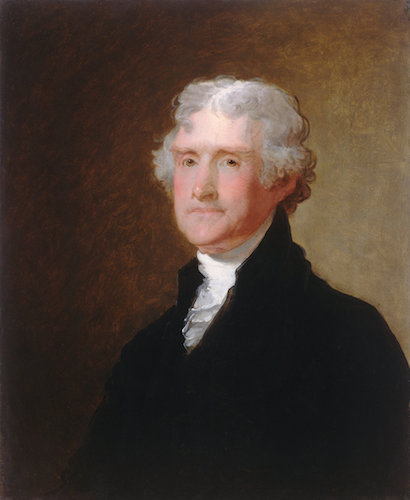
Influence
Thomas Jefferson’s resume is unmatched in the history of American politics. He was the third president of the United States (1801-09), the second vice president of the United States (1797-1801), and the first Secretary of State of the United States (1790-93). He served as the Minister to France (1785-89), a Delegate to the Congress of the Confederation (1783-84), as the governor of Virginia (1779-81), and Delegate to the Continental Congress (1775-1776). He also wrote the State of Virginia’s A Bill for Establishing Religious Freedom (1777) and was the primary author of what many believe to be one of the most perfect political documents ever written, The Declaration of Independence (1776). And yet, had Jefferson been and written none of these things, he would still be remembered today as one of the most influential architects in the history of the United States. In many ways, the Rotunda is the cardinal architectural achievement on what Jefferson thought was one of his most profound accomplishments, the founding of the University of Virginia.
Charles Willson Peale, Staircase Group (Portrait of Raphaelle Peale and Titian Ramsay Peale I)
Video \(\PageIndex{1}\): Charles Willson Peale, Staircase Group (Portrait of Raphaelle Peale and Titian Ramsay Peale), 1795, oil on canvas, 89-1/2 x 39-3/8 inches / 227.3 x 100 cm (Philadelphia Museum of Art)
Smarthistory images for teaching and learning:
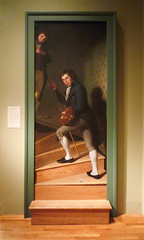
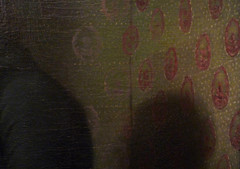
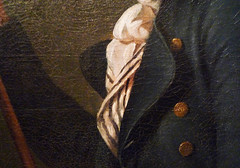
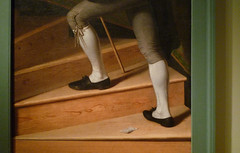
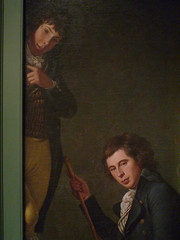
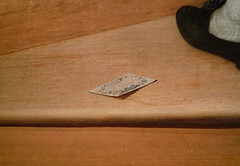


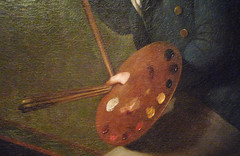
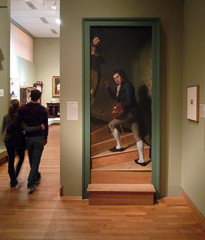
Charles Willson Peale, The Artist in His Museum

Saddle maker, officer, artist, museum founder
He began as a saddle maker, taught dancing lessons in Colonial America, completed mezzotints in London, and served as an officer in the Continental Army during the American Revolutionary War. He also became one of the most prolific artists of his era. Yet despite this background, the name Charles Willson Peale is not one immediately familiar to those outside the circles of American art history. However, it would be difficult to overstate his artistic prominence in the United States during the decades surrounding the turn of the nineteenth century. Without doubt, Peale rests in the pantheon of American portraitists. He painted the social, political, and economic elite of his day: these sitters included scientists, presidents, and prominent merchants.
Even had he never picked up a paintbrush, Peale would be remembered today for founding the first museum of natural history in the United States. This museum officially opened on 18 July 1786, and collecting, classifying, and exhibiting objects occupied nearly the entire Peale family for many a decade to follow. Without doubt, art and nature were Charles Willson Peale’s great passions in life. Peale went so far as to name children after prominent artists and famous scientists. These names include Raphaelle, Rembrandt, Rubens, Titian, Angelica Kauffmann, Linnaeus, and Franklin.

The age of Enlightenment
For Peale and other Enlightenment-era thinkers, the human mind was able to both learn and understand the world around them through observation of the natural world. In many ways, this approach was antithetical to the religious views of the day that asked followers to accept facts on faith rather than verifiable proof. Enlightenment thinkers often attempted to explain the world in a way that removed the word “God” from the equation (or, at the very least, in a way that reduced the Divine Almighty’s direct role).
One example should suffice. For millennia, the appearance of a comet in the night sky—something both easily noticeable in the pre-streetlight world and something of uncommon occurrence—was cause for great concern and wonderment, and people often had a variety of explanations for these celestial events. For example, in 1378, a comet appeared at the moment a great pestilence swept through Germany. That same year, the Great Schism ripped the Roman Catholic Church in two, creating a papacy in Avignon, France in addition to the one at St. Peter’s in Rome. The appearance of this unknown object in the nighttime sky was seen as an indication that God was not happy, and the disastrous events that followed reaffirmed this belief.

Interestingly, 312 years earlier, a similar object appeared in the nighttime sky. The year was 1066, a date in history that is most well known for the year when William the Conqueror of Normandy crossed the English Channel and successfully seized the English throne. To commemorate his great victory, William commissioned the great Bayeux Tapestry, a 230-foot-long embroidered cloth that chronicled his army’s campaign.
One of the more famous scenes from this immense work of art shows a comet flying overhead of the soon-to-be deposed King Harold (image left). The Latin inscription above the six men who point heavenward reads, “They find the star.” This star means bad news for Harold, but, more importantly, it means good news—and a kind of Divine favor—for William.
Science tells us now that this was no star. Moreover, it was not a sign that God was angry (pestilence upon you!), or that God was happy (I would be pleased if you were to sail across the English Channel and take over the English throne!). Instead, this was the same hunk of cosmic ice that returned to Earth every 76 years (give or take). We call it Halley’s Comet after Sir Edmund Halley, the man who correctly predicted its return. Rather than believe the comet was a sign of divine approval or reproach, Halley instead applied the celestial mechanics of another Enlightenment thinker, Sir Isaac Newton, to predict the comet’s reappearance. Alas, Halley died in 1742 and the comet that would be named for him did not make its way back to Earth until 1759.
The Artist in his Museum

Although a three-paragraph digression, it is through this lens that we must consider Charles Willson Peale’s most famous—and some might suggest, his most ambitious—work, The Artist in His Museum. Painted towards the end of his life—Peale turned 81 years old the year it was completed—this monumental canvas is a kind of life story for the artist, and identifies him not only as the artist who made the painting, but, as importantly, the scientist who founded the museum that bears his name. Like most artist’s self portraits, this likeness speaks for what Peale believes was important about himself and what was important about his life’s work.
Peale stands in the foreground, smartly dressed in a black velvet suit and white cravat. A dusting of powder from his hair—he does not wear a wig—can be seen on his left shoulder. He alertly stares at the viewer and with his right arm he lifts up the red Grand Manner drapery to reveal the museum behind him. What was the “Grand Manner”?
With his left hand he seemingly gestures to the objects in the foreground. These objects tell us much about Peale himself. They include a stuffed turkey—which Benjamin Franklin believed should be the national bird of the United States—and the taxidermist tools used to preserve it. Atop the table on the right side of the painting rests a painter’s palette and several paintbrushes. Large fossilized bones from a mastodon (a jawbone, and a femur, perhaps) can also be seen on the right side. These objects—stuffed bird, painting tools, and excavated mastodon—serve as a kind of visual representation of Peale himself.

The room behind Peale is no ordinary room in Philadelphia. It is, in fact, the famous Long Room of what we now call Independence Hall, and it is filled with elements that announce Peale’s commitment to the Enlightenment. The left hand wall and that in the back of the room are filled with stuffed birds that Peale has organized according to the Linnaean classification system. Portraits of eminent men—many of whom were Peale’s friends and correspondents—can be seen near the ceiling. Clearly, this natural history museum provides an opportunity for learning about nature. A top-hat wearing gentleman walks with his young son and gestures to a display in front of them. Another man stands towards the back of the room with crossed arms and thoughtfully examines a specimen.

The fifth person in this painting—a woman who wears a dress and a Quaker bonnet—stands in the left middle ground. She faces the right side of the painting and her facial expression and gesture reveal a sense of wonderment. What has caught her amazement is not immediately apparent, as Peale has concealed it behind the curtain. On closer inspection, however, it is clear that in the middle of the room is the mastodon skeleton Peale and his family excavated and reconstructed earlier in the nineteenth century. Her reaction indicates that nature can not only teach, it can also provide awe.
There is no doubt that Peale was an artist, but he believed that his artistic endeavors were only one part of his long professional life. His The Artist in His Museum, painted near the end of his life, is a kind of visual epitaph for his life. The Baroque architect Sir Christopher Wren is buried in St. Paul’s Cathedral in London, his most famous project. His epitaph reads, “Si monumentum requires, circumspice”—If you seek his monument, look around. The same is true of Peale’s most famous painting. At the end of his life, he used this painting to announce his position as portraitist, naturalist, museum curator, and an important member of the American Enlightenment. It is, in a fashion, a monument not only to the man, but to an outlook that was shaped by the Enlightenment.
John Vanderlyn, Ariadne Asleep on the Island of Naxos

An unusual training for an American
John Vanderlyn is different from most of his American-art peers.
For more than forty years, nearly every American who aspired to be an artist sailed eastward across the Atlantic Ocean to study in the London studio of the Pennsylvania-born painter Benjamin West. Indeed, the artists who West either taught or professionally advised comprises a ‘who’s who’ of colonial and early Federal art, and includes famous names such as John Singleton Copley, Charles Willson Peale, Gilbert Stuart, John Trumbull, and Thomas Sully. The reason for this need for transatlantic travel was simple; whereas London had the Royal Academy of Art and Paris had the Ecole des Beaux-Arts, North America had little other than a few undistinguished art academies and even fewer public collections of art. Aspiring artist had to go where the art and artist were. For those from North America, that had meant London.
But Vanderlyn did not go to London to search out West’s advice or instruction. While a teenager, Vanderlyn moved from his home in Kingston, New York to New York City, and then later studied with Gilbert Stuart, the portraitist, who had recently returned to American shores after 18 years in London and Dublin. Stuart provided art lessons and allowed his pupil to copy portraits.
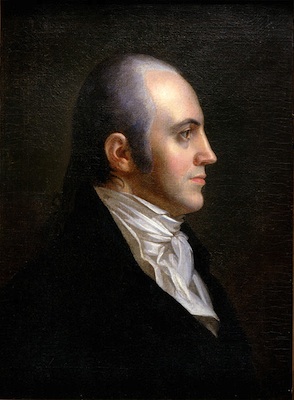
One such image Vanderlyn copied was Stuart’s portrait of Aaron Burr, New York’s Democratic-Republican Senator (and later Vice President under Thomas Jefferson).
This brought the younger artist to the attention of the ambitious politician, and Vanderlyn became a kind of protégé to Burr, living for a spell of time in his residence just outside New York City, Richmond Hill.
There can be no doubt that Stuart would have encouraged Vanderlyn to study with his former teacher, Benjamin West. When considering Burr’s strong anti-English and Francophile sentiments, however, he instead paid for Vanderlyn to study and train in Paris, thus breaking West’s near monopoly in the instruction of American artists.
Paris and Neo-Classicism
When in Paris, Vanderlyn was the first American to study at the Académie de Peinture at the Ecole des Beaux-Arts in Paris, and studied with François-André Vincent, a winner of the prestigious Prix de Rome and somewhat of an artistic rival to the more famous Jacques-Louis David. In doing so and over time, Vanderlyn fully embraced and absorbed the Neo-Classical style that was then flourishing on the continent.
No painting better demonstrates Vanderlyn’s commitment to French Neo-Classicism in regards to form and content better than his masterwork Ariadne Asleep on the Island of Naxos.
Ariadne abandoned
Painted in Paris and shown at the 1812 annual Salon (the name of the official exhibitions), Vanderlyn depicts a narrative from the classical past. Princess Ariadne, the daughter of King Minos of Crete, assisted Theseus in slaying the Minotaur that lived under the palace. As a reward for his victory, Ariadne and Theseus eloped and sailed for Athens, Theseus’s home. After a sexual encounter on the island of Naxos, Theseus abandoned his new bride. Lest we feel sorry for her, she is later rescued by Dionysius who marries her and places her crown in the heavens as the constellation Corona Borealis.
The moment Vanderlyn depicted in his monumental canvas was the point when Theseus was reaching his boat to make his getaway. Ariadne, nude, and in what appears to be a post-coital slumber, lies upon a red drapery, her arms raised to her head. In a painting largely filled with muted earth tones, this red blanket gathers the visual attention of the viewer. A white sheet wraps around upper thigh. It both conceals and at the same time brings attention to her nudity.

Her body—which Vanderlyn has painted a pale milky-white value—contrasts with the North American-like landscape in which she reclines. In the right middle ground one can see the minutely painted boat Theseus boards in order to abandon Ariadne.
Neo-Classicism
Certainly, this image depicts a narrative taken from the classical past, and as such, it fits well under the broad umbrella of Neo-Classicism in regards to subject. However, it is also Neo-Classical in form when compared to the romantic works painted about at about the same time.

Indeed, one need only compare Ariadne with, for example, Goya’s The Third of May, 1808 (1814), painted just two years later, to appreciate the differences between these two different styles. Whereas Vanderlyn’s composition is linear, concise, and has a somewhat muted palette, Goya’s painting is painterly, loosely composed, with an energetic use of color.
Vanderlyn’s composition was favorably received when he exhibited it in Paris. This can be partially explained by the still popular Neo-Classical style and the ways in which it referenced back to the great reclining nudes of the Renaissance—Titian’s famous Venus of Urbino, is but one example. Moreover, Vanderlyn’s painting also anticipates many famous examples that would come later in the nineteenth century.

Indeed, one can see echoes of Vanderlyn’s Ariadne in many paintings to follow. Jean-Auguste-Dominique Ingres’ Grande Odalisque (1814), Édouard Manet’s Olympia (1863) and Alexandre Cabanel’s Birth of Venus (1863) are but three well-known examples. Clearly, the Old World had an appetite for paintings of the reclining female nude.
An unpopular image at home
But the audience in Europe was very different from the one Vanderlyn found when he returned to New York to exhibit Ariadne in the United States. Although he had found encouragement in Paris, the more puritanical mindset of his home country combined with the lack of tradition of the female nude in American art made this an unpopular image. Vanderlyn had hoped to return to the United States and paint large-scale neoclassical history paintings. Instead, he placed his Neo-Classical efforts into portrait painting, a genre he had hoped to avoid (in the hierarchy of subject matter determined by the academies, portrait painting ranked lower than history paintings). He died at the age of 76 in near poverty. It was not until after his death that his French training or his Neo-Classical style were recognized as being key contributions to the very beginnings of art in the United States.
Thomas Birch, Perry’s Victory on Lake Erie
Video \(\PageIndex{2}\): Thomas Birch, Perry’s Victory on Lake Erie, c. 1814, oil on canvas, 167.64 x 245.11 cm (Pennsylvania Academy of the Fine Arts), a Seeing America video speakers: Dr. Anna O. Marley, Curator of Historical American Art, Pennsylvania Academy of the Fine Arts and Dr. Steven Zucker
Smarthistory images for teaching and learning:


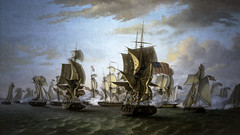
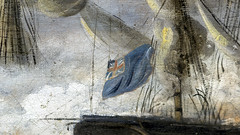
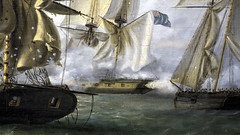
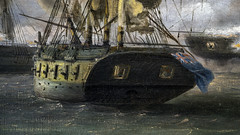
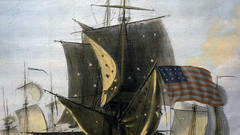
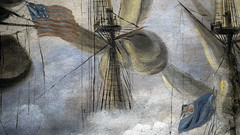
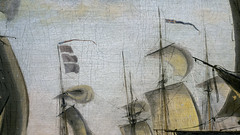
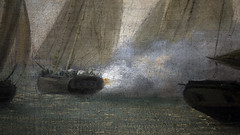
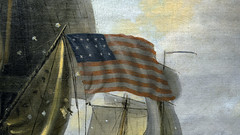


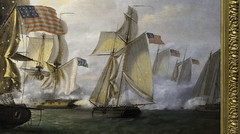
Thomas Birch, Fairmount Water Works
Video \(\PageIndex{3}\): Thomas Birch, Fairmount Water Works, 1821, oil on canvas, 51.1 x 76.3 cm (Pennsylvania Academy of the Fine Arts), a Seeing America video Speakers: Dr. Anna O. Marley, Curator of Historical American Art, Pennsylvania Academy of the Fine Arts and Dr. Steven Zucker
Additional resources
The United States in the 19th century
Artists began to develop their own styles and approaches.
c. 1800 - 1900
Romanticism in the United States
Romanticism in the United States took up themes of nature and spirituality in uniquely American ways.
c. 1800 - 1860
Washington Allston, Elijah in the Desert
Video \(\PageIndex{4}\): Washington Allston, Elijah in the Desert, 1818, oil on canvas, 125.09 x 184.78 cm / 49 1/4 x 72 3/4 inches (Museum of Fine Arts, Boston)
Smarthistory images for teaching and learning:


Thomas Cole, Expulsion from the Garden of Eden
Video \(\PageIndex{5}\): Thomas Cole, Expulsion from the Garden of Eden, 1828, oil on canvas, 100.96 x 138.43 cm (39-3/4 x 54-1/2 inches) (Museum of Fine Arts, Boston)
Smarthistory images for teaching and learning:
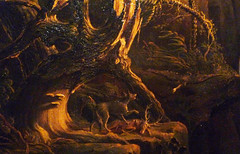

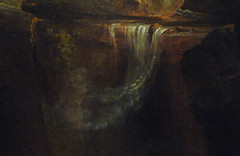
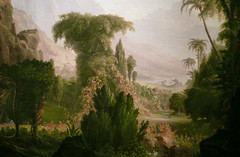
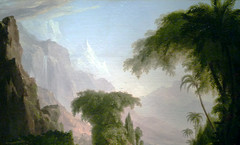
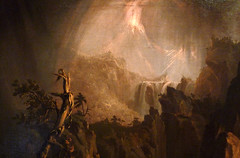
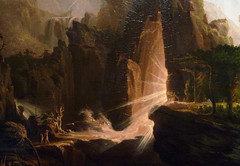

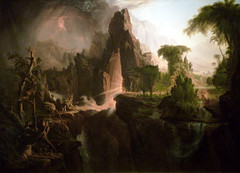
Thomas Cole, The Oxbow
Video \(\PageIndex{6}\): Thomas Cole, View from Mount Holyoke, Northampton, Massachusetts, after a Thunderstorm — The Oxbow, 1836, oil on canvas, 51 1/2 x 76″ / 130.8 x 193 cm (The Metropolitan Museum of Art, New York City)
An American painter born in England
During the nineteenth century—an expanse of time that saw the elevation of landscape painting to a point of national pride—Thomas Cole reigned supreme as the undisputed leader of the Hudson River School of landscape painters (not an actual school, but a group of New York city-based landscape painters). It is ironic, however, that the person who most embodies the beauty and grandeur of the American wilderness during the first half of the nineteenth century was not originally from the United States, but was instead born and lived the first seventeen years of his life in Great Britain. Originally from Bolton-le-Moor in Lancashire (England), the Cole family immigrated to the United States in 1818, first settling in Philadelphia before eventually moving to Steubenville, Ohio, a locale then on the edge of wilderness of the American west.

Early years
Cole worked briefly in Ohio as an itinerant portraitist, but returned to Philadelphia in 1823 at the age of 22 to pursue art instruction that was then unavailable in Ohio. Two years later, Cole moved to New York City where he exchanged his aspirations of painting large-scale historical compositions for the more reasonable artistic goal of completing landscapes. For instruction, Cole turned to a book, William Oram’s Precepts and Observations on the Art of Colouring in Landscaping (1810), an instructional text that had a profound effect on Cole for the remainder of his artistic career.

An important ally and an influential patron
Cole found quick success in New York City. In the year of his arrival, 1825, John Trumbull, the patriarch of American portraiture and history painting, and the president of the American Academy of Design “discovered” Cole, and the older artist made it an immediate goal to promote the talented landscape painter. In the months to follow, Trumbull introduced Cole to many of the wealthy and prominent men who would become his most influential patrons in the decades to follow. One such man was Luman Reed, an affluent merchant who, in 1836, commissioned Cole to paint the five-canvas series The Course of Empire.

Landscapes imbued with a moral message
It is in this series—and in many of the paintings to follow—that Thomas Cole found the aesthetic voice to lift the genre of landscape painting to a level that approached history painting. During the eighteenth and nineteenth centuries, great artists aspired to complete large-scale historical compositions, paintings that often had an instructive moral message. Landscape paintings, in contrast, were often though more imitative than innovative. But in The Course of Empire, Cole was able to take the American landscape and imbue it with a moral message, as was often found in history paintings. Indeed, the landscapes Cole began to paint in the 1830s were not entirely about the land. In these works, Cole used the land as a way to say something important about the United States.
The Oxbow: More than a bend in the Connecticut River
A wonderful illustration of this is Cole’s 1836 masterwork, A View from Mount Holyoke, Northampton, Massachusetts, after a Thunderstorm, a painting that is generally (and mercifully) known as The Oxbow. At first glance this painting may seem to be nothing more than an interesting view of a recognizable bend in the Connecticut River. But when viewed through the lens of nineteenth-century political ideology, this painting eloquently speaks about the widely discussed topic of westward expansion.

When looking at The Oxbow, the viewer can clearly see that Cole used a diagonal line from the lower right to the upper left to divide the composition into two unequal halves. The left-hand side of the painting depicts a sublime view of the land, a perspective that elicits feelings of danger and even fear. This is enhanced by the gloomy storm clouds that seem to pummel the not-too-distant middle ground with rain. This part of the painting depicts a virginal landscape, nature created by God and untouched by man. It is wild, unruly, and untamed.
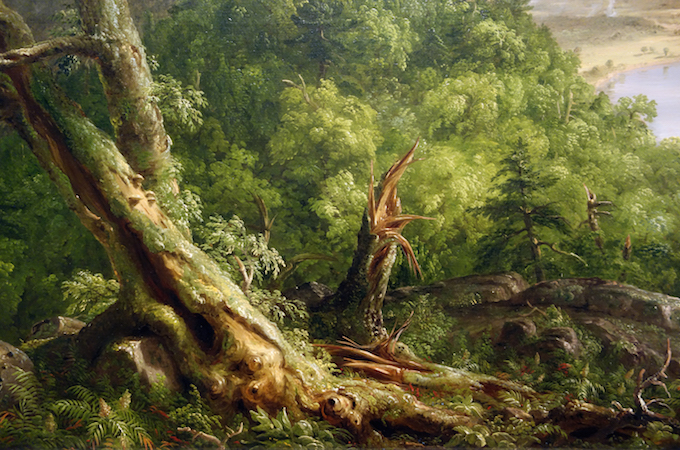
Within the construction of American landscape painting, American artists often visually represented the notion of the untamed wilderness through the “Blasted Tree, a motif Cole paints into the lower left corner. That such a formidable tree could be obliterated in such a way suggests the herculean power of Nature.

If the left side of this painting is sublime in tenor, on the right side of the composition we can observe a peaceful, pastoral landscape that humankind has subjugated to their will. The land, which was once as disorderly as that on the left side of the painting, has now been overtaken by the order and regulation of agriculture. Animals graze. Crops grow. Smoke billows from chimneys. Boats sail upon the river. What was once wild has been tamed. The thunderstorm, which threatens the left side of the painting, has left the land on the right refreshed and no worse for the wear. The sun shines brightly, filling the right side of the painting with the golden glow of a fresh afternoon.
Manifest Destiny
When viewed together, the right side of the painting—the view to the east—and that of the left—the west—clearly speak to the ideology of Manifest Destiny. During the nineteenth century, discussions of westward expansion dominated political discourse. The Louisiana Purchase of 1804 essentially doubled the size of the United States, and many believed that it was a divinely ordained obligation of Americans to settle this westward territory. In The Oxbow, Cole visually shows the benefits of this process. The land to the east is ordered, productive, and useful. In contrast, the land to the west remains unbridled. Further westward expansion—a change that is destined to happen—is shown to positively alter the land.


Although Cole was the most influential landscape artist of the first half of the nineteenth century, he was not completely adverse to figure painting. Indeed, a close look at The Oxbow, reveals an easily overlooked self-portrait in the lower part of the painting. Cole wears a coat and hat and stands before a stretched canvas placed on an easel, paintbrush in hand. The artist pauses, as if in the middle of the brushstroke, to engage the viewer. This work, then, in a kind of “artist in his studio” self-portrait—is akin, in many ways, to Charles Willson Peale’s 1822 work The Artist in His Museum. In each, the artist depicts himself in his own setting. For Peale, this was his natural history museum in Philadelphia. For Cole, this was the nature he is most well known for painting.
Lasting influence

Although he only formally accepted one pupil for instruction—this was, of course, Frederic Edwin Church—Thomas Cole exerted a powerful influence on the course of landscape painting in the United States during the nineteenth century. Not content to merely paint the land, Cole elevated the landscape genre to approach the status of historical painting. The landscape painters who followed during the middle of the nineteenth century—Church, Durand, Bierstadt, and others—would often follow the trail that Cole had blazed.
Additional resources:
This painting at The Metropolitan Museum of Art
Cedar Grove, The Thomas Cole National Historic Site
Hudson River School on The Metropolitan Museum of Art’s Heilbrunn Timeline of Art History
Thomas Cole on The Metropolitan Museum of Art’s Heilbrunn Timeline of Art History
On Cole’s The Course of Empire
Carl Pfluger, The Views and Visions of Thomas Cole, The Hudson River Review, vol. 47, no. 4 (Winter 1995), pp. 629-35
Smarthistory images for teaching and learning:

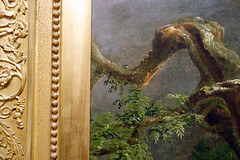
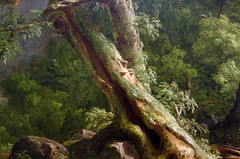
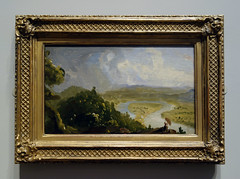
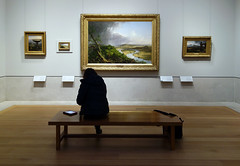
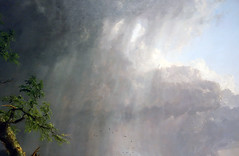
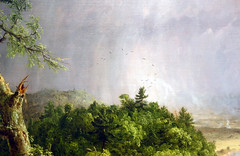
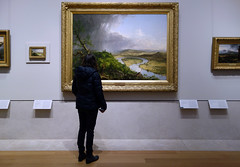
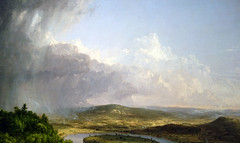


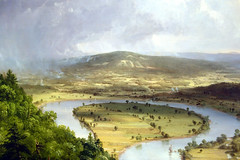

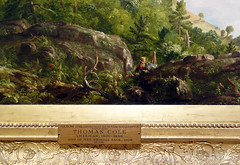
Thomas Cole, The Architect’s Dream
Video \(\PageIndex{7}\): Thomas Cole, The Architect’s Dream, 1840, oil on canvas, 134.7 x 213.6 cm (Toledo Museum of Art)
Additional resources
Smarthistory images for teaching and learning:
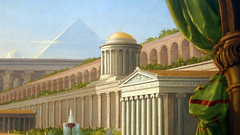
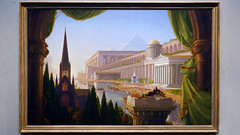
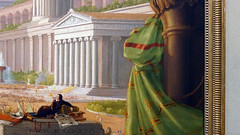

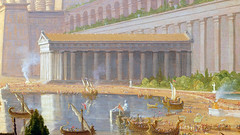
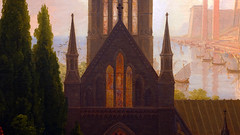

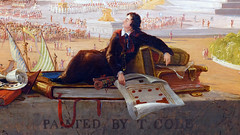

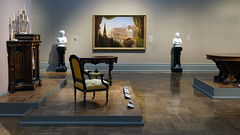
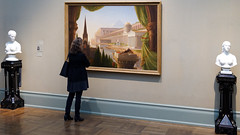
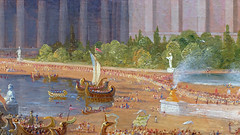
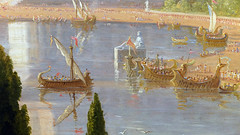
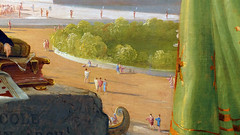
Video \(\PageIndex{8}\): Thomas Cole, The Hunter’s Return, 1845, oil on canvas (Amon Carter Museum of American Art). Speakers: Dr. Maggie Adler, Curator, Amon Carter Museum of American Art and Dr. Beth Harris
Hicks’s The Peaceable Kingdom as Pennsylvania parable
Video \(\PageIndex{9}\): Edward Hicks, The Peaceable Kingdom, 1826, oil on canvas, 83.5 x 106 cm (Philadelphia Museum of Art) Speakers: Barbara Bassett, Curator of Education, School and Teacher Programs at the Philadelphia Museum of Art and Beth Harris A Seeing America video
George Catlin, The White Cloud, Head Chief of the Iowas

Robed in his most splendid costume, his face gleaming with precious vermillion paint, he sits, like the prince he is, among his proud acolytes, solemnly smoking his pipe. [He is] a modern Jason.¹
This is what the nineteenth century French novelist and critic George Sand said when she first saw this striking portrait of the head chief of the Iowas, The White Cloud, or “Mew-hu-she-kaw,” painted by the American artist, explorer, and ethnographer, George Catlin. This painting, along with a series of other portraits of American Indians by Catlin, was exhibited in the Paris Salon of 1846 (the Salon was the official exhibition of the Academy of Fine Arts in France). They stunned and titillated bourgeois Parisians with the spectacle and strangeness of the vast American wilderness and its “noble savages.”
Vanishing heroes

The comparison to the Greek mythological seafarer Jason is not unusual; the tendency to link the diminishing American Indian population to a vanished race of classical heroes was popular among Europeans and Americans in the nineteenth century. In 1821 the American artist Charles Bird King caused a sensation when he painted a group of Plains Indian chiefs in profile as dignified and as stately as Roman statues.
But rhapsodizing over the Indian’s innate nobility was easy to do in the face of his near extinction. By the mid-nineteenth century the popular image of the terrifying Indian who threatened Western expansion and Manifest Destiny (the widely held belief in the United States that American settlers were destined to expand throughout the continent) gave way to a more dignified, but defeated figure as the numbers of Indians across the country fell due to diseases, forced relocation, and poverty. By 1750, the American Indian population east of the Mississippi River fell by approximately 250,000 while the Caucasian and African-American population rose from around 250,000 in 1700 to nearly 1.25 million by 1750.²
Catlin painted this portrait of The White Cloud around 1844, twenty years after the Iowa tribes were forced by the U.S. government to move from Iowa to small reservations in Kansas and Nebraska. The displacement from their ancestral and spiritual homeland left the dwindling Iowa people in a fragile state. Only thirteen years before Catlin’s painting, American Indians endured one of their most traumatic collective experiences, “The Trail of Tears.” As part of the Indian Removal Act of 1830, the government forced many of the southeastern tribes, the Cherokee, Seminole, Choctaw, and Chickasaw, to leave their homes and move west to designated Indian Territory in present-day Oklahoma. Hundreds of thousands died along the grueling journey from disease, exposure, and starvation.
A dignified portrayal
Catlin met The White Cloud, not in the U.S., but in Victorian London, when the Indian chief and his family were touring Europe as part of P.T. Barnum’s traveling circus from 1843 to 1845. The dancing Indians were a featured act in Barnum’s “Greatest Show on Earth” which showcased what Barnum believed to be rare cultural curiosities from all over the world.

By 1844, George Catlin was already something of a celebrity in America and in Europe with his Indian portraits. Catlin exaggerated his rustic backwoods character by occasionally wearing fur and moccasins to entrance his eager European audience who were hungry for an undiluted taste of the American wilderness (Catlin had grown up in Wilkes-Barre, Pennsylvania).
The exotic plumage of traditional Indian dress appealed to Catlin at a fundamental level. It connected him to another culture and to the roots of American identity and the land.
In his journals he describes their beauty in detail:
I love the Indians for their dignity, which is natural and noble. Vanity is the same all the world over. Good looks in portraiture and fashions, whatever they are—crinoline of the lip or crinoline of the waist (and one is as beautiful and reasonable as the other), or rings in the nose or rings in the ears, they are all the same.³
However, Catlin’s portrayal of The White Cloud, in his resplendent warrior regalia, stands in sharp contrast to the squalid way in which Barnum treated him. Indian performers during the nineteenth century, whether they were with Buffalo Bill’s “Wild West Show” or P.T. Barnum’s circus, were by and large cruelly exploited. In an 1843 letter to the collector and cultural historian Moses Kimball, founder of the Boston Museum, Barnum writes of the challenges of including Indians in his act while denigrating them:
Dear Moses:
The Indians arrived and danced [last] night…They dance very well but do not [look] so fine as those last winter. They rowed, or rather paddled, another [race] last Saturday at Camden. I hired them out for the occasion for $100 and their board.
You must either get a [building] near the museum for the Indians to sleep and cook their own victuals [in] or else let them sleep in the museum on their skins & have victuals sent them from Sweeny shop. I boil up ham & potatoes, corn, beef, &c. at home& send them at each meal. The interpreter is a kind of half-breed and a decent chap; he must have common private board. The lazy devils want to be lying down nearly all the time, and as it looks so bad for them to be lying about the Museum, I have them stretched out in the workshop all day, some of them occasionally strolling about the Museum. D—n Indians anyhow. They are a lazy, shiftless set of brutes—though they will draw [in a crowd].
B.4
Barnum’s view of the Indians in his employ is the opposite of Catlin’s portrayal of The White Cloud, which brings out this man’s inherent grace and dignity.
Traditional dress
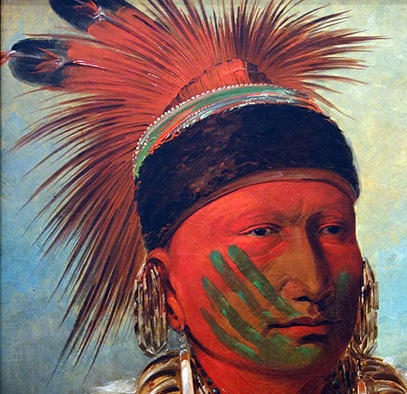
The White Cloud wears the traditional costume of the Iowa chieftain, indicative of his strengths as a warrior and hunter.
His face is painted in glowing vermillion with a green a handprint across his cheeks, a sign that he was skilled in hand-to-hand combat. He wears a headdress of two eagle feathers and deer’s tail (also dyed vermillion) and a black band across his forehead made of otter fur. His earrings are made of carved conch shells. White wolf skin covers his shoulders over his deerskin robe and he wears a necklace made of grizzly bear claws, which testifies to his superior skill as a hunter.

The necklace is the costume’s pièce de résistance, the aspect that signifies that The White Cloud is indeed the chief of his tribe. Catlin added the hazy blue sky in the background from his own imagination—the portrait was actually painted indoors in a draughty studio in London.
Catlin’s portrayal of Indian chiefs galvanized the imagination of a generation of European writers such as George Sand, Charles Baudelaire, and J.M. Barrie, whose Indians in Peter Pan are derived in part from Catlin’s portraits. Yet underneath the images of plumed warriors and braves there was a sense of underlying sadness and determination to document a vanishing way of life. “We travel to see the perishable and the perishing,” Catlin wrote in his journal in the 1830s. “To see them before they fall.”5
Catlin’s portraits today
It is difficult to look at Catlin’s The White Cloud today without overlaying our knowledge of the oppression and violence Indian peoples suffered over hundreds of years. Nevertheless, it’s important to remember that during Catlin’s time, painting was an important means that Europeans used to record and preserve the changing status of Native Americans. The cultural historian Richard Slotkin said, “Catlin tried to deal with the ephemeral quality of the wilderness—the fact that white men were destroying it as they were trying to appropriate it.”6 The Indian, to Catlin, represented a beautiful, primordial aspect of America endangered in the face of industrialization and westward expansion.
George Catlin’s paintings of the American Indians remain an enduring window onto the Old West, one of the most fascinating and contentious periods of American history. In certain aspects the art of the Old West shows us what the art historian Bryan J. Wolf calls, “the eternal last act in an imperial drama that began, as it ended, not just with territorial expansion but with cultural conquest as well.”7 Catlin’s paintings and illustrations, free of sanctimony or fabrication, show us the Indian not as a noble savage, as the European audiences often saw him, or as a demonic figure in the view of many nineteenth-century settlers, but as a real person in a real, though exotic, setting.
1. Benita Eisler, The Red Man’s Bones: George Catlin, Artist and Showman (New York: W.W. Norton, 2013), p. 328
2. Encyclopedia of American Indian History. Ed. Bruce Johansen. (ABC-CLIO, 2007), p. 115
3. George Catlin, Episodes from “Life among the Indians” and “Last Rambles,” (New York: Dover Publications: 1997), p. 251
4. Iowa Indians at the American Museum, The Lost Museum (American Social History Productions, Inc., 2002-2006)
5. George Catlin, Episodes from “Life among the Indians” and “Last Rambles,” (New York: Dover Publications: 1997) p. 73
6. Robert Hughes, American Visions: The Epic History of Art in America (New York: Knopf, 1999)
7. Bryan J. Wolf. “How the West Was Hung, Or, When I Hear the Word ‘Culture’ I Take Out My Checkbook: The West as America: Reinterpreting Images of the Frontier, 1820-1920,” American Quarterly, Vol. 44, No. 3 (Sep., 1992), p. 423
Additional resources:
This painting at the National Gallery of Art
George Catlin and his Indian Gallery from the Smithsonian American Art Museum
Biography of the artist from the Smithsonian American Art Museum
Charles Bird King, Young Omahaw, War Eagle, Little Missouri, and Pawnees at the museum
Susanna Reich, Painting the Wild Frontier: The Art and Adventures of George Catlin, (New York: Clarion), p. 77
An Eye for Art: Focusing on Great Artists and Their Work. National Gallery of Art, (Chicago Review Press: 2013), p. 40
Smarthistory images for teaching and learning:


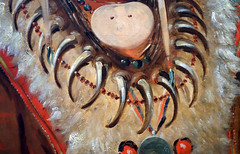

Emanuel Leutze, Washington Crossing the Delaware
Video \(\PageIndex{10}\): Emanuel Leutze, Washington Crossing the Delaware,1851, oil on canvas, 379 x 648 cm (The Metropolitan Museum of Art)
An American icon (made in Germany)
Washington Crossing the Delaware is one of the most recognizable images in the history of American art. You might be surprised, however, to learn that it was not painted by an American artist at work in the United States, but was instead completed by Emanuel Leutze, an artist born in Germany, and that it was painted in Düsseldorf during the middle of the nineteenth century.
Leutze painted two versions of this painting. He began the first in 1849 immediately following the failure of Germany’s own revolution. This initial canvas was eventually destroyed during an Allied bombing raid in World War II. The artist began the second version of Washington Crossing the Delaware in 1850. This later painting was transported to New York where it was exhibited in a gallery in October 1851. Two years later, Marshall O. Roberts, a wealthy capitalist, purchased the work for the then-staggering price of $10,000. It was donated to the Metropolitan Museum of Art in 1897. It remained there until 1950 when long held curatorial concerns about its bombastic, crowd-pleasing qualities led the museum to send it to Dallas and eventually to a site near the actual river crossing. The painting returned to New York in 1970.
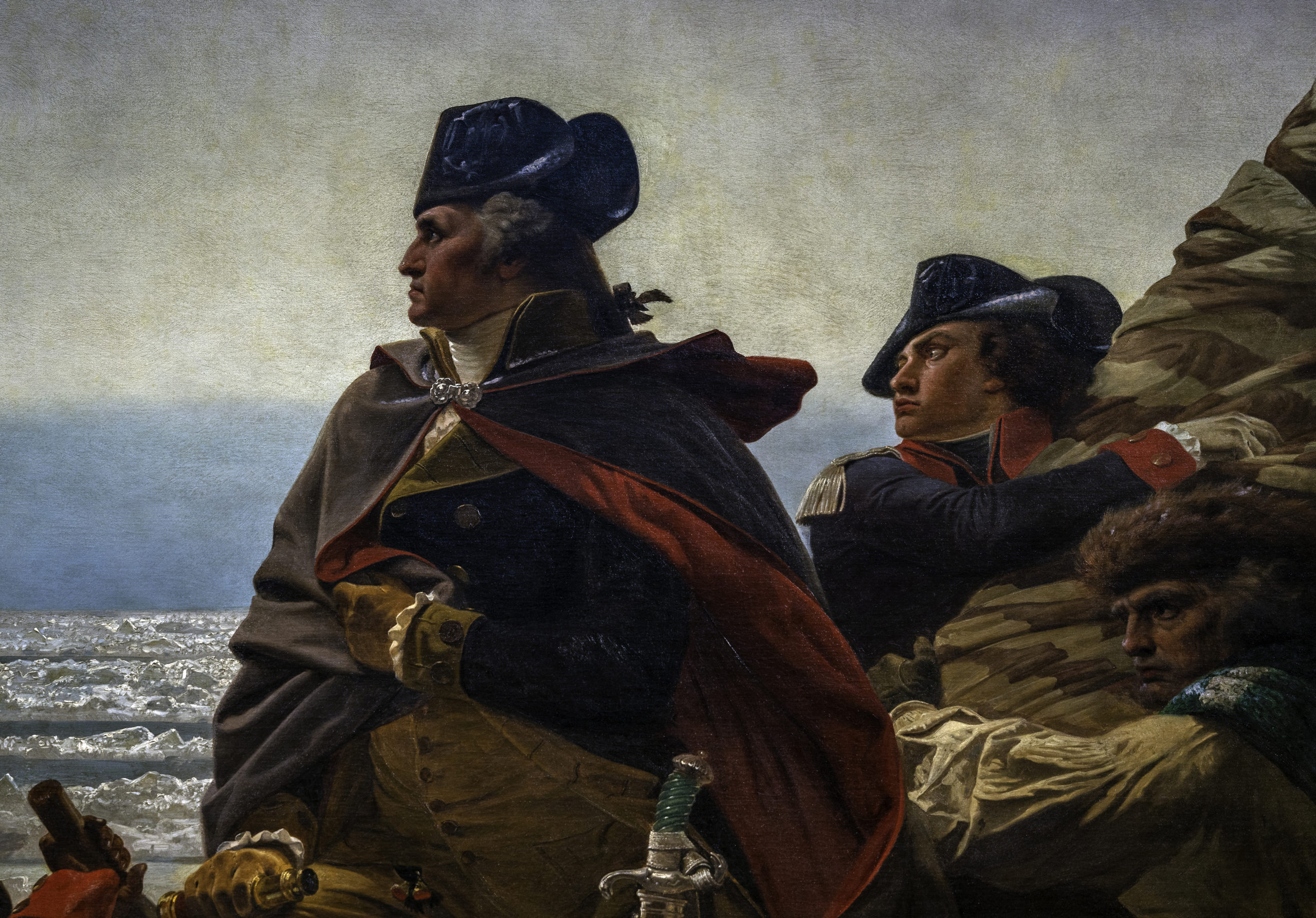
Although Emanuel Leutze was born in Schwäbisch Gmünd, Germany, his family immigrated to the United States before he turned ten years of age. His first art instruction came in 1834 when he studied drawing and portraiture with John Rubens Smith, a London-born artist who worked in the United States during the first half of the 19th Century. Wealthy Philadelphian patrons recognized Leutze’s talent and sponsored the young artist to study at the Königliche Kunstacademie in Düsseldorf. While there, Leutze came to know many American artists who were then studying in Germany. These artists included Worthington Whittredge, Albert Bierstadt, Charles Wilmar, and Eastman Johnson.
Although he was active in portraiture, Leutze’s fame today rests upon his history paintings, and among these, Washington Crossing the Delaware is the most recognizable and ambitious. It is, in one word, colossal, both in scale and patriotic zeal.
Brilliance and desperation on a vast scale
Little can prepare a viewer for the experience of standing before a painting that measures more than 12 x 21 feet. The monumental scale of the composition is matched by the importance of the historical event Leutze painted. Without doubt, Leutze took his subject from one of the turning points in the American Revolutionary War.
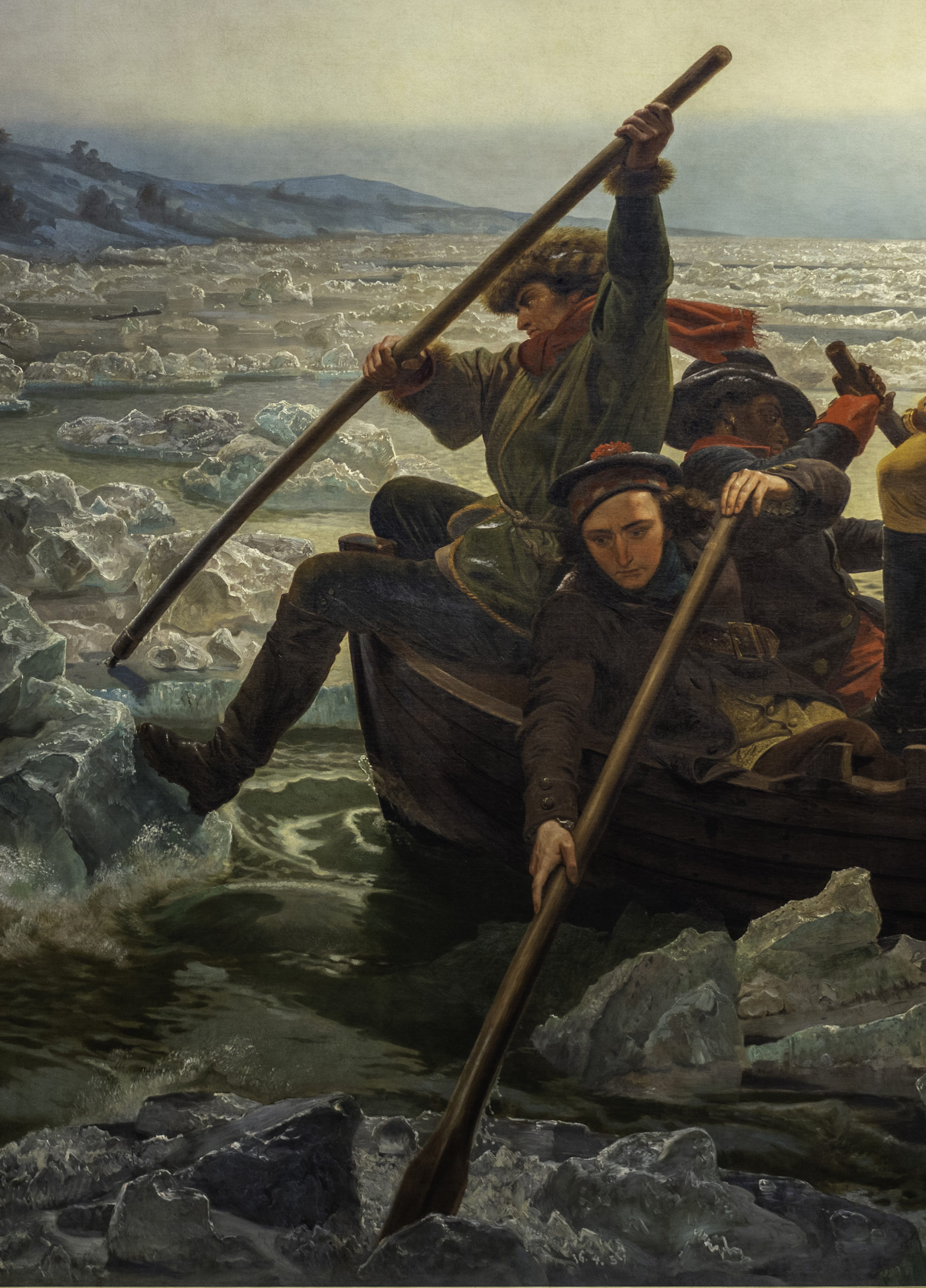
The Colonial cause appeared exceptionally bleak as the year 1776 came to a close. In a military move that navigated the fine line between brilliance and desperation, George Washington led the Colonial army across the Delaware River shortly after nightfall on 25 December in order to attack the Hessian encampment outside Trenton, New Jersey. Washington and his army achieved an unprecedented tactical surprise and delivered a much-needed military and moral victory. Washington’s army killed 22 Hessian soldiers, wounded 98 more, and captured more than 1,000 (Hessians were Germans soldiers hired by the British Empire). The Colonial Army had less than ten combined dead and wounded soldiers. After many military setbacks in the North, Washington’s bold move on Christmas night 1776 helped provide a sense of hope for the Colonial cause.
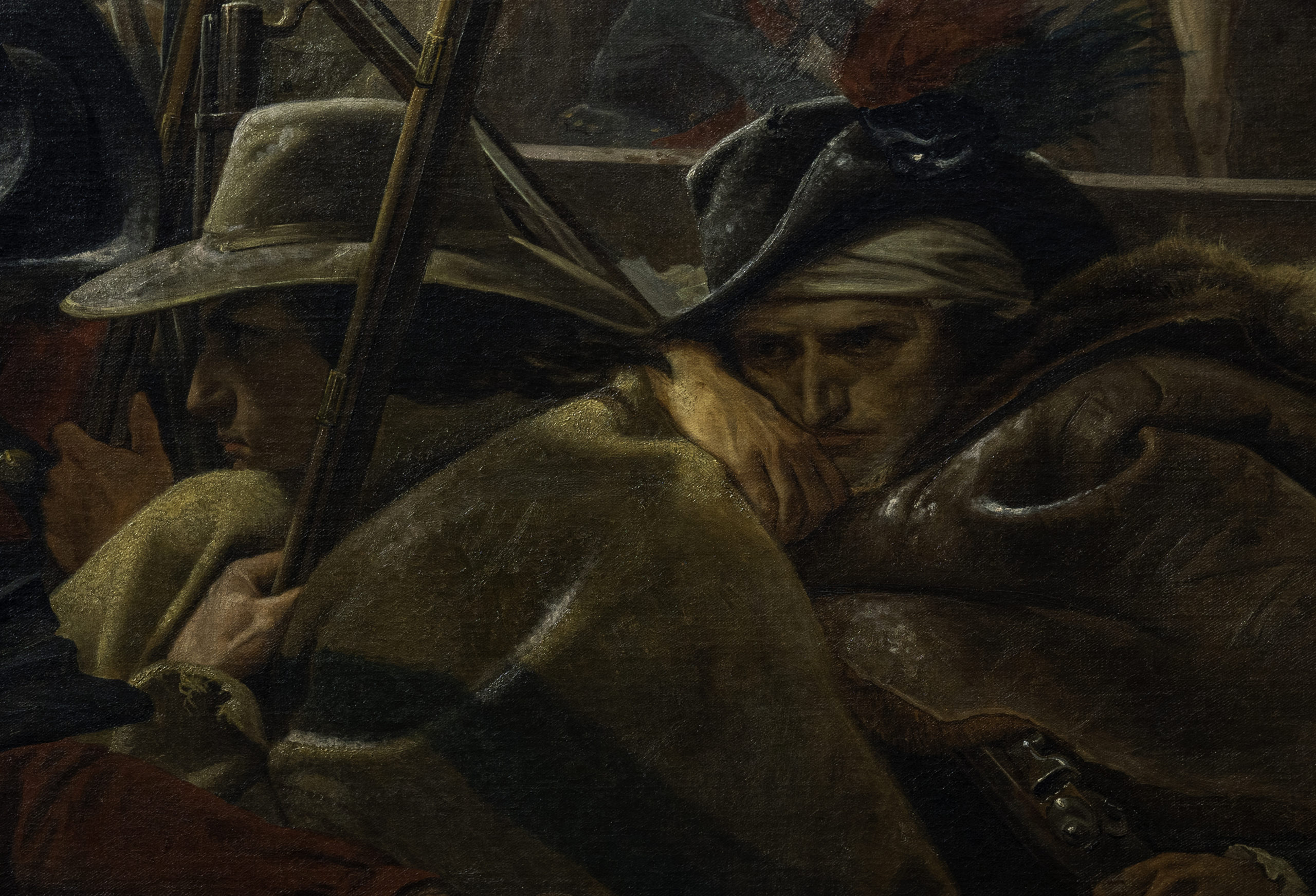
In addition to General Washington, Leutze has filled the boat with a variety of ‘types’ of soldiers. Washington and his two officers are distinguished by their blue coats, the trademark attire of a Continental officer.
The remaining nine men appear to be members of the militia. Three men row at the bow of the boat. One is an African American, another wears the checkerboard bonnet of a Scotsman, and the third wears a coonskin cap.
Two farmers, distinguished by their broad-brimmed hats, huddle against the frigid cold in the middle of the boat, while the man at the stern wears the moccasins, pants, and hat of a Native American. This collection of people suggests the all-inclusive nature of the Colonial cause in the American Revolutionary War.
Poetic license

Despite Leutze’s interest in history, there is little historical accuracy to be found within the painting. First, the “Stars and Stripes” flag shown in the painting was not in use until September 1777, and the size of the boat is far too small to accommodate the twelve men who occupy it.
And although this event happened in the middle of the night, Leutze shows the crossing occurring at the break of dawn. Rather than depict the Delaware River, a waterway that was rather narrow where Washington and the Continental Army crossed, Leutze paints what appears to be a river with the breadth and ice formation of the Rhine. Finally, and perhaps most interestingly, Leuzte paints Washington standing upright, an unlikely and precarious posture for anyone in a short-walled rowboat.
It is clear then that Washington Crossing the Delaware‘s strength is not in the correct rendering of an historical event. Leutze’s primary goal was to create a work of art that deliberately glorified General Washington, the Colonial-American cause, and commemorated a military action of particular significance. In doing so, Leutze created one of the most iconic images in the history of American art.
Additional resources:
This painting at The Metropolitan Museum of Art
Corey Kilgannon, “Crossing the Delaware, More Accurately”, New York Times (December 2011)
Smarthistory images for teaching and learning:
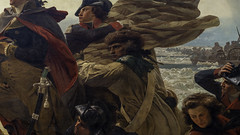
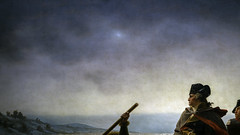
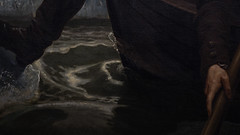
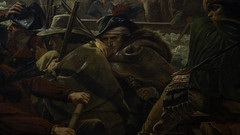
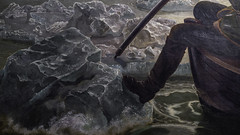

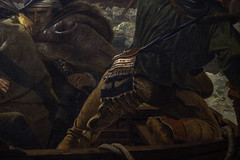
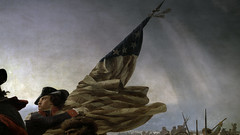


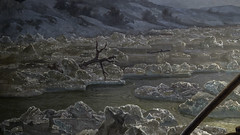

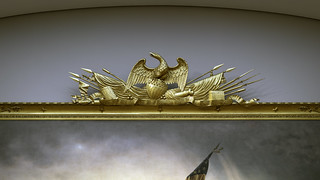
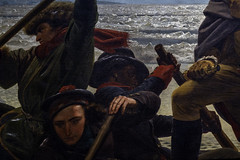
Envisioning Manifest Destiny
Video \(\PageIndex{11}\): Emanuel Gottlieb Leutze, Westward the Course of Empire Takes Its Way (mural study for the United States Capitol building), 1861, oil on canvas, 84.5 x 110.1 cm (Smithsonian American Art Museum, Bequest of Sara Carr Upton, 1931.6.1)
Peter Frederick Rothermel, De Soto Raising the Cross on the Banks of the Mississippi
Video \(\PageIndex{12}\): Peter Frederick Rothermel, De Soto Raising the Cross on the Banks of the Mississippi, 1851, oil on canvas, 101.6 x 127 cm (Pennsylvania Academy of the Fine Arts, funds provided by the Henry C. Gibson Fund and Mrs. Elliott R. Detchon, 1987.31), a Seeing America video Speakers: Dr. Anna O. Marley, Curator of Historical American Art, Pennsylvania Academy of the Fine Arts and Dr. Steven Zucker
Additional Resources
This painting at the Pennsylvania Academy of the Fine Arts
Historic rotunda paintings, Architect of the Capitol
History of Hernando de Soto’s expedition, Chickasaw Nation
Excavation, de Soto’s cross(?), Arkansas Archaeological Survey
Frederic Edwin Church, Niagara and Heart of the Andes
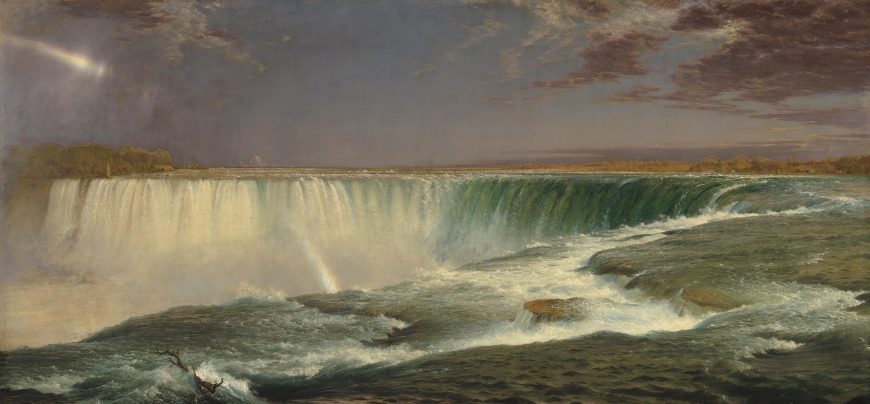
A precise depiction of nature
If Thomas Cole represents the first generation of the Hudson River School of painters, then Frederic Edwin Church, the only pupil Cole ever instructed, certainly represents the generation that followed. Yet despite the teacher/student relationship that they shared, they differed in the ways in which they conceived of the American landscape. For Cole, landscape painting was a pictorial device in which to reach allegorical or narrative ends. While Church at first followed his teacher’s instruction in this regard, the younger artist set allegory and narrative aside in favor of a more focused and precise depiction of nature.
A teacher’s praise: “The finest eye of drawing in the world”
Church was born in Hartford, Connecticut, to a wealthy family; his father was a prosperous silversmith and watchmaker. Daniel Wadsworth, one of the most influential art patrons of his time and the founder of the oldest public art museum in the United States—the Wadsworth Atheneum—introduced Church to Cole in 1844. Although still but a teenager, Cole remarked that Church possessed ‘the finest eye of drawing in the world.’ Church’s immense skill is demonstrated by his election as an Associate of the National Academy of Design in May of 1844. Just barely 24 years of age, Church was the youngest artist so honored. But one year later his status was to that of Academician. Clearly, his career was off to a meteoric beginning.
Blockbuster landscapes
Today, Church is most famous for his large, blockbuster-sized landscapes. Among the many he painted, Niagara (1857) and The Heart of the Andes (1863) are justifiably the most famous. Together, these two paintings vaulted Church to the position of the most famous painter in the United States.
Although Church was not the first artist to depict the Great Falls of Niagara—John Vanderlyn, John Trumbull, and Cole had made attempts earlier in the nineteenth century—he was the first to somehow capture the roaring essence of what many then considered to be the greatest natural treasure in the United States. In contrast to earlier painters, however, Church placed the viewer close to the falls and suspends them immediately above the ledge from which the water thrillingly descends. Even the panorama-like horizontal format and the colossal size (106.5 x 229.9 cm) accentuate the sublime nature of the composition.
An American image
Even though Church depicted the Canadian side of Niagara Falls, this image became wildly popular, both in the United States and in Europe, and has, over time, become a uniquely “American” image. When completed in 1857, Church exhibited this work at a one-painting show at the New York commercial art gallery of Williams, Stevens, and Williams. Within two weeks of the exhibition’s opening, more than 100,000 visitors had paid twenty-five cents each to view Church’s masterwork. The art-loving public was clearly fascinated and enchanted by this image. Many used opera glasses to discern the minute details that were only visible upon close inspection. Church, ever the businessman, generated additional revenue through the sale of chromolithographs of the painting.
After a successful exhibit in New York, Church then toured Niagara to various cites on the east coast, and eventually even took the image to London and Paris. In all, Niagara made Church both a wealthy man and amongst the most famous of American painters.
Return to South America
If 1857 marks the year of Church completed Niagara, it also marks his return to South America, a location the artist had visited just four years prior. Cyrus Field, a wealthy New York businessman who was to become one of Church’s most reliable patrons, financed both of these adventures. Church spent more than two months in South America—most of this in Ecuador—and became keenly interested in Alexander von Humboldt, the Prussian naturalist and acclaimed author of Kosmos. This two-volume study of geology and natural history was published in Germany in 1845 and 1847. English translations followed shortly thereafter, and Humboltdt’s theories had an immense impact on Church’s views of the natural world. When the artist returned to his New York studio, he arrived with countless preparatory drawings and watercolors from which to base a monumental composition.

Not just a painting—an experience
And complete a monumental composition Church did, not only in size (168 x 302.9 cm), but also in visual scope. Church unveiled the painting at Lyrique Hall on 27 April 1859, and was moved to the Tenth Street Studio Building two days later. Like Niagara, The Heart of the Andes was more for contemporary viewers than just a painting; countless writers agreed that seeing the painting was an experience. Church placed the painting in a darkened room and dramatically illuminated it through the use of gas lamps. An enormous frame that resembled window molding only increased the painting’s visual impact. As with Niagara, the twenty-five cent ticket price for The Heart of the Andes entitled viewers to borrow a pair of opera glasses and a set of pamphlets that explained the composition through the geographical ideas von Humboldt wrote of in his Kosmos.

Praise from Mark Twain
Indeed, if Niagara was a depiction of a singular scene, The Heart of the Andes is instead a pictorial composite view of Humboldt’s theories. The public was once again smitten with Church’s efforts, and more than 12,000 visitors paid the quarter admission charge. After New York, Church sent The Heart of the Andes on tour to both domestic and foreign locations. Mark Twain saw it when it arrived in St. Louis in 1860 and wrote to this brother:
Pamela and I have just returned from a visit to the most wonderfully beautiful painting which this city has ever seen–Church’s “Heart of the Andes”–which represents a lovely valley with its rich vegetation in all the bloom and glory of a tropical summer–dotted with birds and flowers of all colors and shades of color, and sunny slopes, and shady corners, and twilight groves, and cool cascades–all grandly set off with a majestic mountain in the background with its gleaming summit clothed in everlasting ice and snow! I have seen it several times, but it is always a new picture–totally new–you seem to see nothing the second time which you saw the first. We took the opera glass, and examined its beauties minutely, for the naked eye cannot discern the little wayside flowers, and soft shadows and patches of sunshine, and half-hidden bunches of grass and jets of water which form some of its most enchanting features…You will never get tired of looking at the picture, but your reflections –your efforts to grasp an intelligible Something–you hardly know what –will grow so painful that you will have to go away from the thing, in order to obtain relief. You may find relief, but you cannot banish the picture–It remains with you still. It is in my mind now–and the smallest feature could not be removed without my detecting it.
The composition

If Church had ever read Twain’s remarks, there can be little doubt the artist would have been delighted. Church aspired to take many different components and assemble them into a cohesive and believable whole. The monumental snow-capped mountain in the deep background is Mt. Chimborazo, one of the highest peaks in South America. Moving to the foreground, Church leads the viewer through a variety of topographical zones which all contain unique flora and fauna. There is but a little human presence in this vast depiction of space.A colonial Spanish hacienda appears in the central middle ground, resting on the banks of a river. This waterway flows to the viewer’s right, eventually arriving at a waterfall—a Niagara in miniature—on the right side of the painting. A well-traveled footpath in the left foreground leads the eye to a pair of people who worship before a simple wooden cross. Beyond these ‘major’ elements, the composition is filled with minute details unobservable in any reproduction. Flowers bloom, birds flutter, water flows, and wind seems to blow.
A nineteenth-century artistic entrepreneur
Niagara and The Heart of the Andes are only two paintings from a long and productive professional career that spanned North and South America, Europe, and the Middle East. However, they stand as excellent examples of Frederic Church’s extensive oeuvre and his practices as a nineteenth-century artistic entrepreneur. Whereas Thomas Cole, Church’s artistic mentor, used the landscape as a visual tool on the path towards allegory and narrative, Church instead placed great artistic focus on exactitude and specificity in regards to flora, fauna, and geological formations. The huge size, panoramic views, and incredible detail vaulted him into the highest ranks of nineteenth century American landscapists.
Additional resources:
Church’s Niagara at the National Gallery of Art
Church’s Heart of the Andes at The Metropolitan Museum of Art
Frederic Edwin Church on The Metropolitan Museum of Art’s Heilbrunn Timeline of Art History
The Hudson River School on The Metropolitan Museum of Art’s Heilbrunn Timeline of Art History
Olana, Church’s fabulous home on the Hudson River
Frederic Edwin Church, The Iceberg
Video \(\PageIndex{13}\): Frederic Edwin Church, The Iceberg, c. 1875, oil on canvas, 55.9 x 68.6 cm (Terra Foundation for American Art, Daniel J. Terra Collection, 1993.6), a Seeing America video speakers: Dr. Peter John Brownlee, Curator, Terra Foundation for American Art and Dr. Beth Harris
Additional Resources
This painting at the Terra Foundation for American Art
Smarthistory images for teaching and learning:





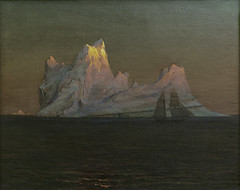

Fitz Henry Lane, Owl’s Head, Penobscot Bay, Maine
Video \(\PageIndex{14}\): Fitz Henry Lane, Owl’s Head, Penobscot Bay, Maine, 1862, oil on canvas, 40 x 66.36 cm (15-3/4 x 26-1/8 inches) (Museum of Fine Arts, Boston)
Smarthistory images for teaching and learning:

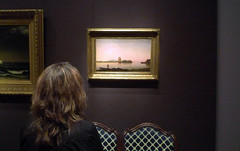

Albert Bierstadt, Hetch Hetchy Valley, California
Video \(\PageIndex{15}\): Albert Bierstadt, Hetch Hetchy Valley, California, c. 1874-80, oil on canvas, 94.8 x 148.2 cm (Bequest of Laura M. Lyman, in memory of her husband Theodore Lyman, Wadsworth Atheneum Museum of Art)
Additional resources:
Realism in the United States
Winslow Homer and Thomas Eakins epitomized the Realist movement in the United States.
1820 - 1895
Francis Guy, Winter Scene in Brooklyn
Video \(\PageIndex{16}\): Francis Guy, Winter Scene in Brooklyn, 1820, oil on canvas, 147.3 x 260.2 cm (Crystal Bridges Museum of American Art). Speakers: Dr. Margaret C. Conrads and Dr. Beth Harris.
Smarthistory images for teaching and learning:
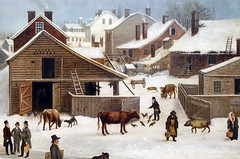
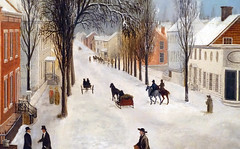
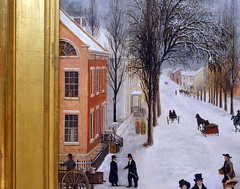

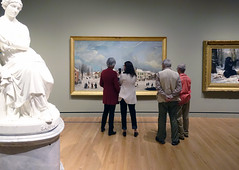
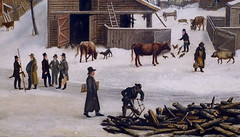

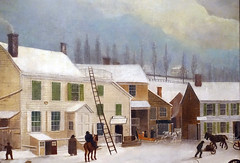


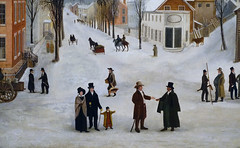
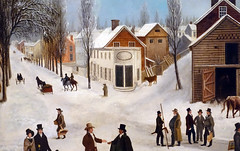
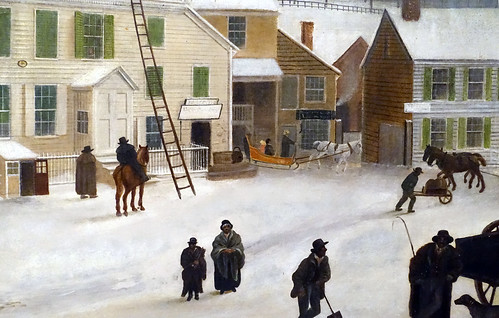
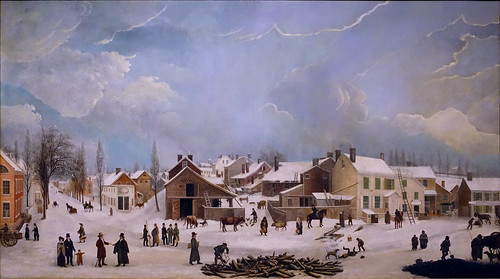
William Sidney Mount, Bargaining for a Horse
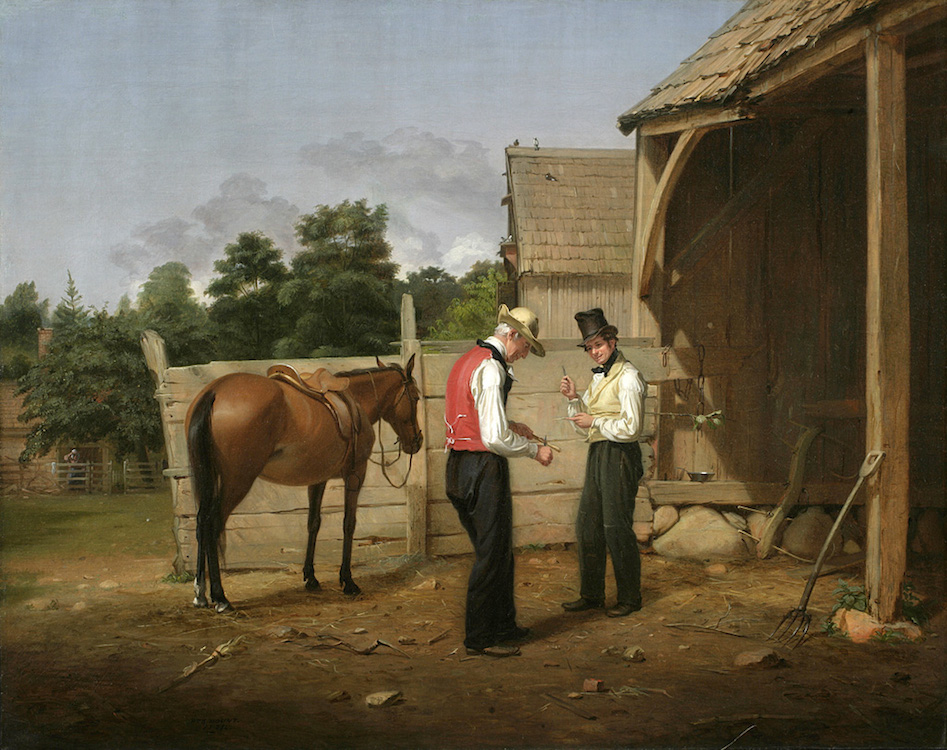
The New York painter William Sidney Mount painted this intimate, comically vibrant picture in 1835. Along with Raffling for the Goose and Eel Spearing at Setauket, Bargaining for a Horse is one of Mount’s great works and a striking example of early nineteenth-century American genre painting at its best.
Mount (and other artists like George Caleb Bingham) captured contemporary scenes of rural American life at the cusp of the country’s transition into urbanization and modernity. Mount’s childhood home in Long Island, once pastoral and sleepy in its cozy insularity, became—like many parts of America—changed by the presence of expanding railroad networks. Mount’s specialty as an artist lay in his ability to document the last remnants of the old Yankee culture of the New York countryside before the Yankee became gentrified and adjusted to the cosmopolitan demands of the nineteenth century (Yankee a refers to people from the northeast—especially those descended from colonial New England settlers).
Mount’s ambition to be a history painter
Though a renowned painter of genre scenes, William Sidney Mount had initially set out to be a history painter like Benjamin West. Mount was born into a wealthy land-owning family in Long Island in 1807. When his father died seven years later, Mount was sent to live with his uncle, Micah Hawkins, a successful wholesale grocer. At seventeen, Mount was an apprentice to his brother Henry, a sign painter. He took drawing courses at the National Academy of Design in New York, where he learned to appreciate the work of the Masters of European art and acquired an appreciation of landscapes and history painting. However, Mount’s first major work, a biblical scene, Christ Raising the Daughter of Jairus, received little critical attention when it debuted in 1828.
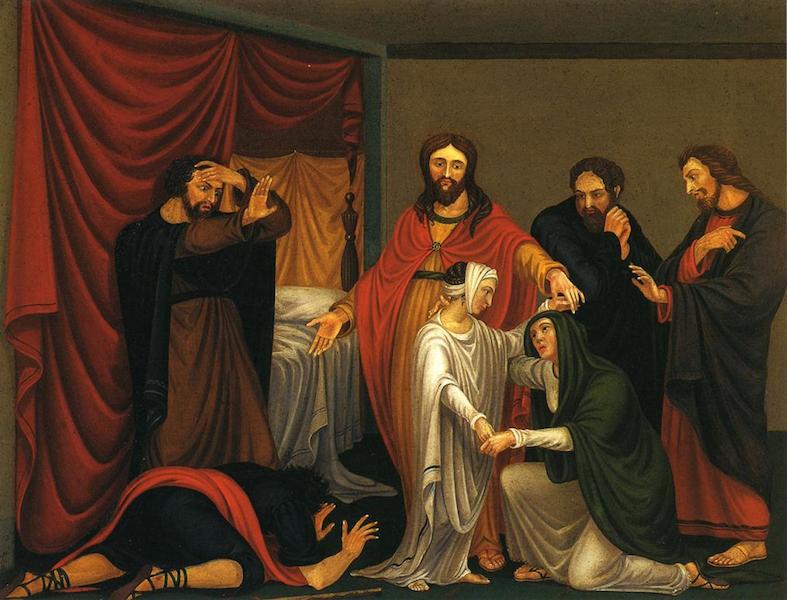
During the 1820s, a wide variety of landscape and genre prints circulated across the United States. Prints of rustic genre scenes by the Scottish painter David Wilkie were particularly popular with contemporary European and American audiences. Wilkie’s success convinced Mount to turn his attention to genre painting.
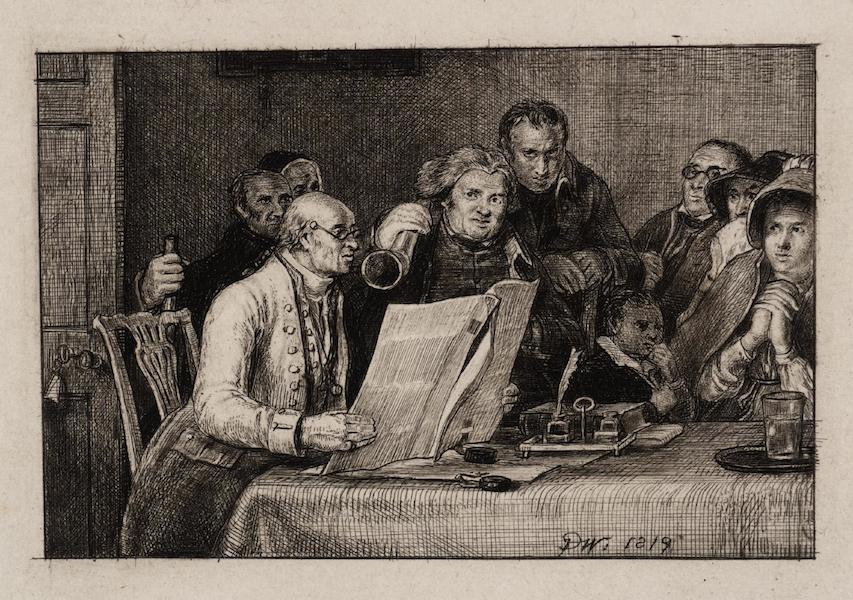
Bargaining for a Horse
In Bargaining for a Horse, we see two farmers, both well-dressed and seemingly prosperous, discussing the price of a chestnut mare that the man in the red waistcoat hopes to sell to the man in yellow. The younger man in yellow wears a battered top hat—indicating that he is perhaps a visitor to the farm. Both men are discussing the price of the horse while they “whittle,” or carve sticks of wood with their pocket knives (a popular pastime for men of all ages living in the country). The horse stands at the left tied to the barn door as the shadows stretch into the barn on the right. The demarcation of sunlight across the two men and the horse is a spotlight and creates a stage space for the unfolding comedy. It is likely that someone is going to be short-changed for the horse, but such is the nature of the comedy and the satisfaction within the audience’s suspense. Part of the engine of the comedy is the trap that is being set for the unsuspecting patsy. The scene’s humor also comes from the fact that the men are bargaining with one another while casually scraping away at wooden sticks, subtly masking their masculine authority and aggression in the guise of a popular childhood pastime.
Though the barn and its surroundings (notice the angled slant of the pitchfork on the right) frame the two “actors,” Mount is particular about rooting the scene in the countryside. A woman observes the horse trading from the distant background. She stands behind a split-rail fence underneath several immense trees. In some ways, she is perhaps a stand-in for us, the viewers of the painting. Mount always understood that, like a playwright, he was staging something for an audience, and the placement of the figure in the distance is a sly nod to this realization.
In the nineteenth century, the term “horse-trading” was often a colloquialism for back-room political deals. In the period between 1812 and the Civil War, the dynamic changes in the United States—its urban population growth, the nationwide expansion of railroads and industries, and Westward expansion (the Oregon Trail began in the 1830s)—led to an assertive forcefulness and toughness in the American character, associated in some ways with the presidency of Andrew Jackson and the toughness of the frontier spirit that Jackson exemplified. William Sidney Mount is showing us only a glimpse of this type of personality through the lens of his idea of the rural New Yorker, the New York Yankee so exemplified in the stories of writers such as Washington Irving and the poems of John Pierpont.
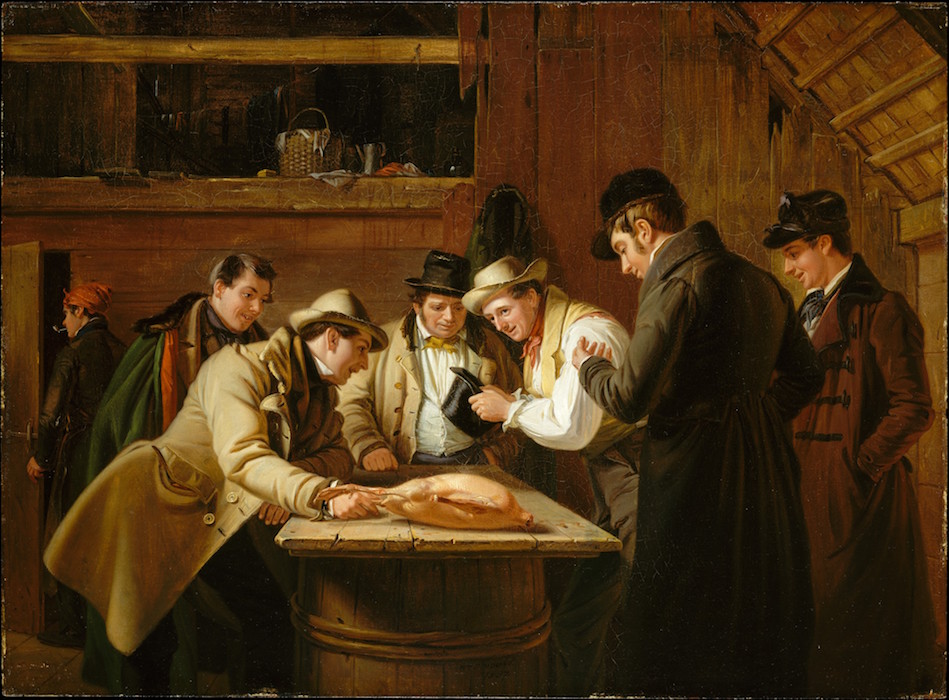
The resourcefulness of the Yankee merchant or farmer depicted in Mount’s paintings such as Raffling for the Goose (1837, above) and other similar images, is a reflection of the entrepreneurial drive and energy of many Americans in the 1820s and 1830s. In her book American Genre Painting: The Politics of Everyday Life, the art historian Elizabeth Johns describes a character we often see within Mount’s paintings—the Long Island Yankee farmer-merchant—as an emblematic figure of American enterprise. With the growth of urbanization across agrarian towns in the 1830s, and the rise of immigration to the United States from countries in Western and Central Europe, this Yankee figure—often a stage caricature in comic plays who went by the name of Jonathan Ploughboy—became a quasi-nativist representation of small-town cunning and ingenuity. As the United States became more multicultural and diverse, its population sought to redefine aspects of the national character. What precisely made an American, “American”? “With the triumph of the Democrats in national politics in 1828 and the intoxicating expansion of the economy in the early 1830s,” writes Johns, “enthusiasts envisioned a great harmony of individual enterprise and respect—an official recognition at least of the importance of the common man.”
William Sidney Mount’s uncle was an actor in the New York theater world in the early 1810s, and theatricality pervades many of Mount’s paintings. In Bargaining for a Horse and Raffling for the Goose, there is an element of playful humor rooted in the art of the swindle. Mount painted Bargaining for a Horse for his patron, the New York dry goods magnate Lumen Reed, who he had met in 1834. Reed was a keen collector of contemporary art and had become a patron to Asher Durand and Thomas Cole. The original title of the painting was Farmers Bargaining, but Edward Carey changed the title to the more descriptive one we use today when he published an engraving of the image in 1840.
Additional resources:
Alfred Frankenstein, Painter of Rural America, William Sidney Mount, 1807-1868 (The Suffolk Museum at Stony Brook, 1968).
Elizabeth Johns, American Genre Painting: The Politics of Everyday Life (Yale University Press, 1993).
Elizabeth Johns, “The Farmer in the Works of William Sidney Mount,” The Journal of Interdisciplinary History, vol. 17, no. 1 (Summer 1986).
Angela Miller, Janet Berlo, and Bryan Wolf, American Encounters: Art, History, and Cultural Identity (Pearson, 2007).
Marianne Doezema and Elizabeth Milroy, ed., Reading American Art (Yale University Press, 1998).
Barbara Novak, American Paintings of the Nineteenth Century: Realism, Idealism and the American Experience (Oxford University Press, 2007).
[1] William T. Oedel and Todd S. Gernes, “William Sidney Mount” in Reading American Art, ed. Marianne Doezema and Elizabeth Milroy (Yale University Press, 1998) p. 146.
Richard Caton Woodville, War News from Mexico
Video \(\PageIndex{16}\): Richard Caton Woodville, War News from Mexico, 1848, oil on canvas, 68.6 × 63.5 cm (Crystal Bridges Museum of American Art, Bentonville, Arkansas). Speakers: Dr. Mindy Besaw, curator, Crystal Bridges Museum of American Art, and Dr. Steven Zucker
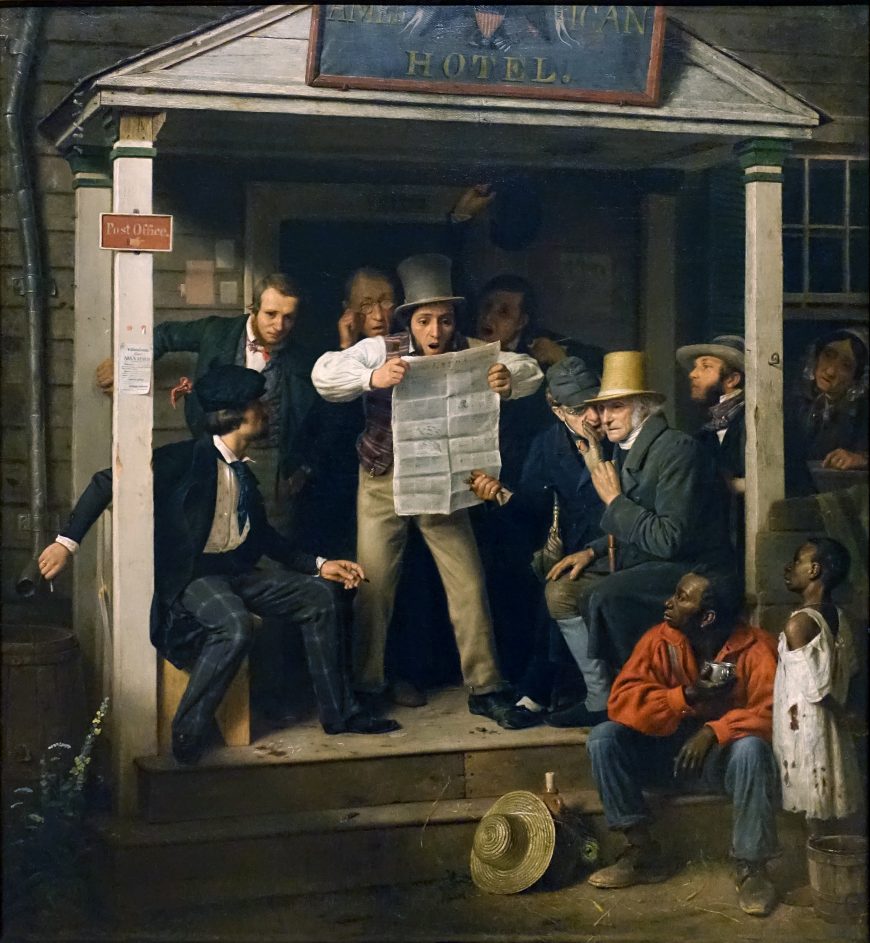
A crowd gathered for the news
The young man in the center of a crowd in Richard Caton Woodville’s War News From Mexico (1848) holds open a newspaper with his elbows up, but the paper is low enough that we can see the astonished look on his face.
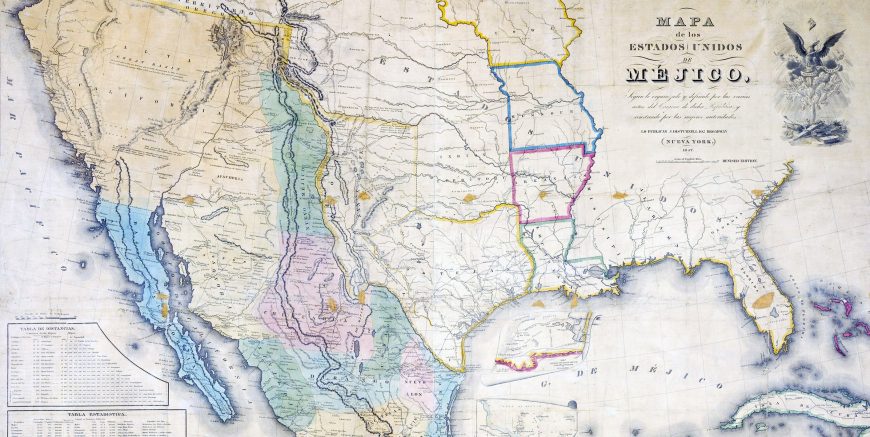
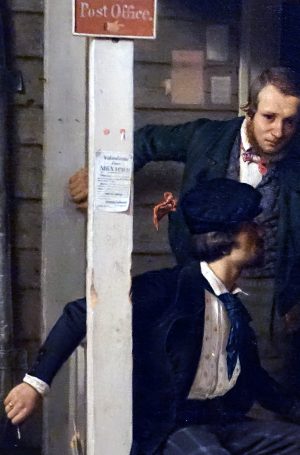
And the news itself? As the title indicates, this is a dispatch from the front of the Mexican-American War. United States troops entered Mexico City in 1848, bringing to an end a war that had begun in 1846 over a territorial dispute involving Texas. In the resulting Treaty of Guadalupe Hidalgo, Mexico ceded half its territory to the United States, effectively concluding the U.S. program of westward expansion.
To convey the characteristics of a Western outpost, the men gathered in the painting are shown standing on the porch of a building typical of the kind erected in the American frontier during the rush for territories in the early decades of the nineteenth century. In fact, the building serves multiple functions: it is both an “American Hotel” and post office, as indicated on the signs. While the building emulates in wood the style of stone classical structures found in Philadelphia or New York City, the artist has taken great care with the details to remind the viewer this is on the frontier: the wood is worn, and underneath the “post office” sign is tacked a recruitment notice asking for “Volunteers for Mexico!”
A range of responses
Opinion on the war was divided and Woodville thus depicts a range of responses. An older man in Revolutionary-era clothing just to the right of the standing figure holding the newspaper, strains to hear as another repeats into his ear what is being read. One young man in the background is tossing his hat into the air; he clearly welcomes the news but the seated elder shows far less enthusiasm. His outdated clothing identifies him as part of the generation that fought the Revolutionary War but did not endorse the expansion embraced by the new Jacksonian-era democracy. And what of the inhabitants themselves of the former Spanish colonies in the southwest (Mexico had gained independence from Spain in 1821)? This could only be bad news; the surrendering of territory spelled the loss of cultural identity. A protestant, Anglo-American culture, pushing westward, acquiring new states for the Union, would seek to eradicate any vestiges of Hispanic-Catholic identity. Mexicans would wake up the day after the treaty was signed and find themselves second-class citizens in a new country.
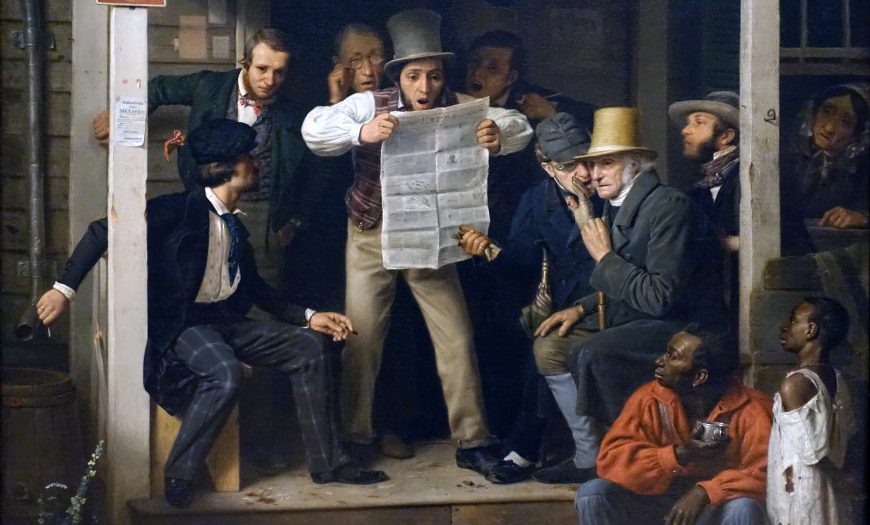
Genre scenes
American genre-scene painters during this period typically strove to represent an array of social types in their rapidly modernizing nation, and Woodville’s painting is no exception (“genre” paintings depict scenes of everyday life). There were often humorous illustrations of class status or newly immigrant Americans in genre scene paintings but they also betrayed, in equal measure, social anxiety about a shifting demography in a new political environment. There are African-American figures in the painting but they are pushed to the border, outside the framing beams of the hotel’s portico—a seated man in a bright orange shirt and a child wearing a tattered white dress. They look on from the bottom right, at the foot of the steps, but their facial expressions seem to register only weariness or perhaps resignation. The question as to whether the new territories would be slave states or free ones was hotly debated—some saw the war as extending the institution of slavery—and Woodville nods to this larger political reality. There is also an elderly woman barely visible in the shadows; she leans out a window and looks in the direction of the group on the porch. These figures are not included within the immediate circle of white men—perhaps suggesting their less central position within society.
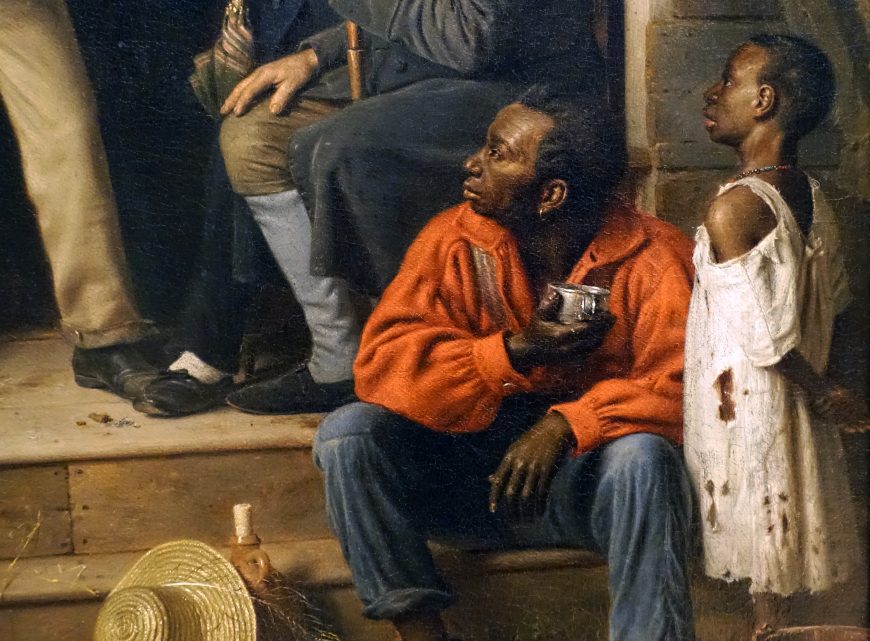
Images of frontier life were popular in the years leading up to the Civil War and Woodville had great success depicting this kind of everyday subject matter. He specialized in domestic interiors—an important subset of this newly emergent category of genre-scene painting. This subject type was popular in Europe (particularly during the 17th century in the Dutch Republic), however it was a relatively new phenomenon in American art—reaching its height of popularity in the period that stretched from the 1830s through the Civil War of 1861-65. Genre scene paintings were aimed at a broadly expanded and increasingly literate middle-class whose tastes ran to familiar scenarios of everyday life, rather than the mythic or historical themes favored by the art academies (the Royal Academies of Europe and the National Academy in the United States). Genre-scene paintings were promoted by organizations like the American Art Union (AAU). The AAU was formed in 1839 to promote American artists and specifically to forge a uniquely American art. Once exhibited under the aegis of the AAU—Woodville’s War News From Mexico was exhibited in 1849 right after the war ended—paintings were then turned into engravings and sold to AAU members by subscription.
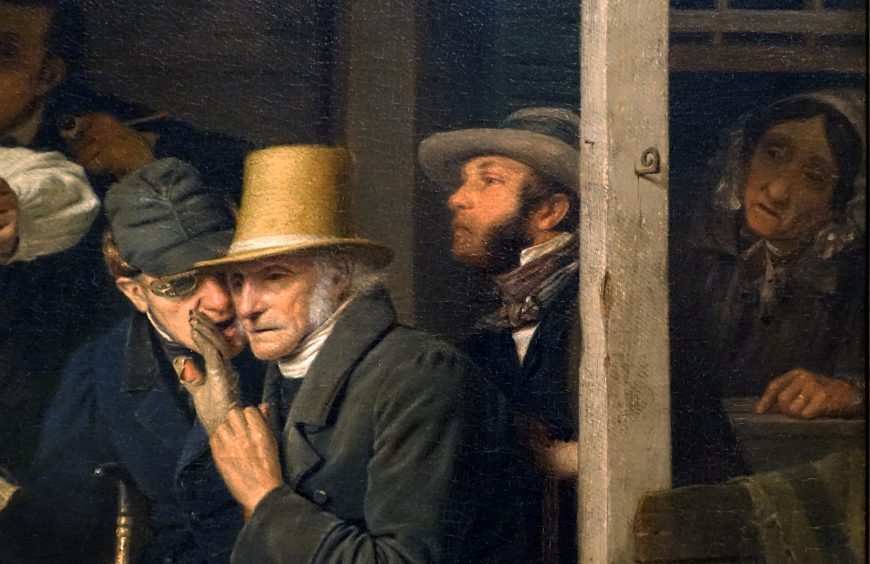
In contrast to the marginalized figures of the woman and the African Americans, the newspaper takes pride of place in this painting. The “penny presses,” as they were called, a relatively recent invention, were mass-produced commercial newspapers that emerged in the 1830s during a period of rapid industrialization and modernization. Unlike their more expensive, subscription-based counterparts, the penny presses (so named because they cost mere pennies) reached a broad swath of the American public. Not only was the Mexican-American War one of the very first to be photographed, it was also extensively broadcast through print—through the very type of paper depicted in the painting, with its top banner emblazoned with the words “EXTRA.” The newspaper, in fact, functioned as a powerful symbol of the power of the press to bring Americans together and the painting suggests the role of the paper in shaping public opinion.
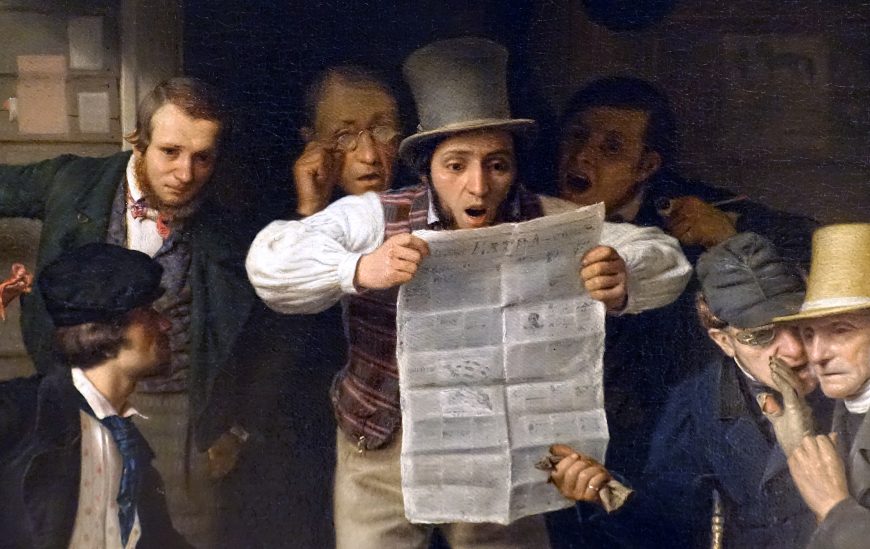
Genre-scene paintings often conveyed a sense of immediacy and here War News From Mexico orients itself towards the viewer in such a way that one feels as if one has just stumbled upon the scene. Notice, for example, how the perspective is tilted to the right of the viewer; this has the effect of positioning us off to the left side as if we have just come around some imaginary corner and the American Hotel, its porch crowded with the town’s inhabitants, careens into view.
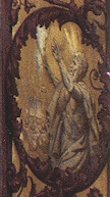
Manifest Destiny
Despite this seeming spontaneity, War News from Mexico is as carefully composed and even as moralizing as the staid history paintings and Neoclassical subjects favored by the academies. Though it was commonplace to view genre-scene paintings as “snapshots” of daily American life without larger purpose, this unfolding scene (meant to indicate some place on the frontier far removed from the military action, but close enough that it mattered), takes place against the backdrop of Manifest Destiny—the theory that drove and justified westward expansion.
The ideology of Manifest Destiny construes Anglo-Americans as God’s chosen people who—like the ancient Israelites of the Old Testament—are guided by God to their destiny. This was a subject often depicted in painting. For example, in Emmanuel Leutze’s mural for the west stairway of the U.S. Capitol, Westward the Course of Empire Takes its Way, we see American pioneers and their covered wagons looking towards the sunset and the Pacific Ocean while one of the scenes in the lower right border (illustrated left) depicts Moses leading the Israelites through the desert.
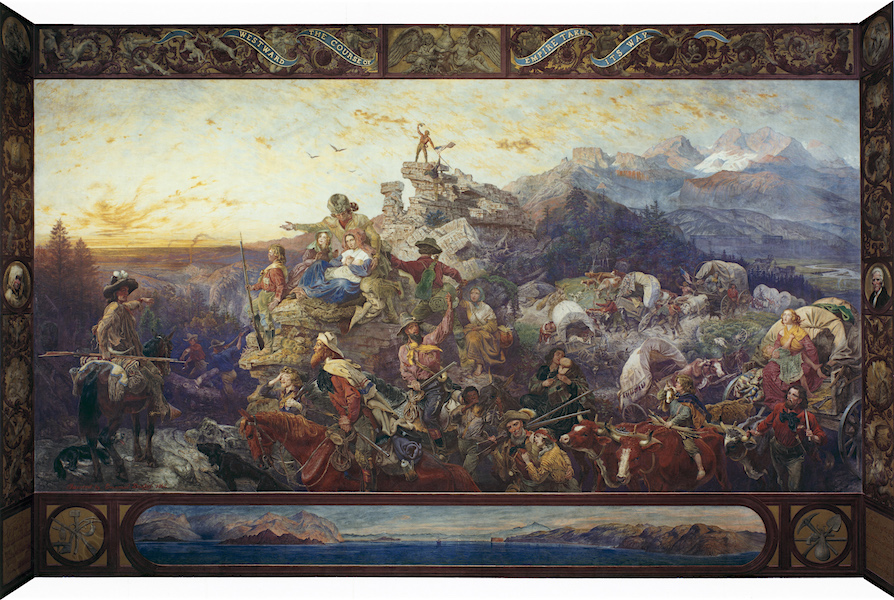
Beginning with the American Revolution, this American “exceptionalism” (as it also came to be known), rationalized not only the acquisition of land all the way to the Pacific Ocean, but also the subjugation and removal of people from their land—the Indian Removal Act of 1830 that President Andrew Jackson signed into law strengthened the rapid acquisition of land that went hand in hand with expulsion and extermination.
Woodville makes no overt statement of his politics in War News from Mexico but his painting nevertheless encapsulates a larger history than the scale of this relatively small painting (it measures approximately 27 x 25 inches) would seem to allow. If War News from Mexico does, however ambiguously, extol the ideology of Manifest Destiny and the inevitability of America’s domination of a large part of the continent, it is an ironic fact of history that Woodville’s scenes of life in the American West were painted while he lived in Europe. Born in Baltimore, Woodville left for Europe as a young man to train in Düsseldorf, Germany, and remained abroad until his death in London at the age of 30.
George Caleb Bingham, Country Politician
Video \(\PageIndex{17}\): George Caleb Bingham, Country Politician, 1849, oil on canvas, 51.8 x 61cm (Fine Arts Museums of San Francisco). Speakers: Emily Jennings, Director of School and Family Programs, Fine Arts Museums of San Francisco and Steven Zucker A Seeing America video
Blythe, Justice
Video \(\PageIndex{18}\): David Gilmour Blythe, Justice, c. 1860, oil on canvas, 51.1 x 61.3 cm (Fine Art Museums of San Francisco)
Thomas Hovenden, The Last Moments of John Brown
Video \(\PageIndex{19}\): Thomas Hovenden, The Last Moments of John Brown, c. 1884, oil on canvas, 117.2 x 96.8 cm (de Young Museum, Fine Arts Museums of San Francisco)
A Seeing America video
Additional resources
Smarthistory images for teaching and learning:
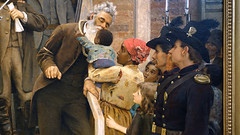
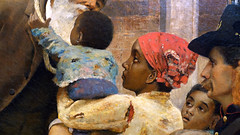





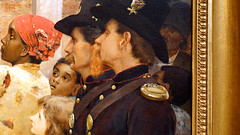
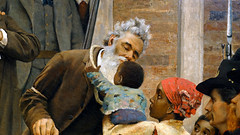

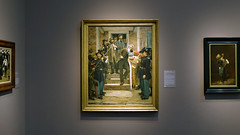
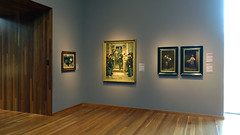
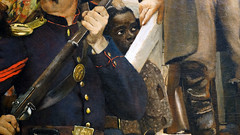
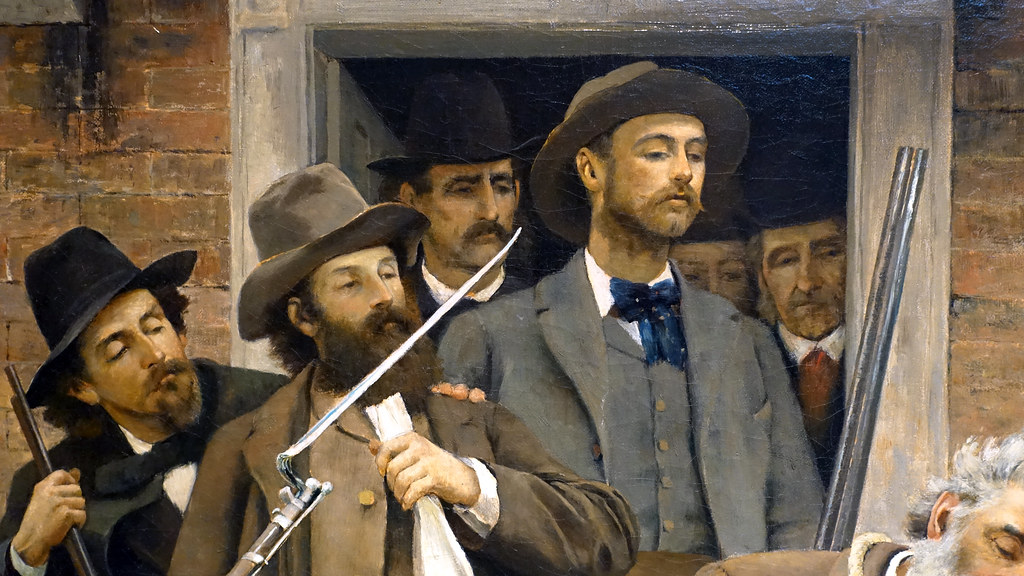
Eastman Johnson, A Ride for Liberty — The Fugitive Slaves
Video \(\PageIndex{20}\): Eastman Johnson, A Ride for Liberty — The Fugitive Slaves, c. 1862, oil on paperboard, 55.8 x 66.4 cm (Brooklyn Museum)
At the time of the Civil War
Today, Eastman Johnson is most well known for the small genre paintings he completed during the middle of the nineteenth century. In several of these images—Old Kentucky Home–Negro Life in the South (1859) is a good example—Johnson focused on the status of race in the United States right about the time of the American Civil War. If this was the first painting he completed that centered attention on the issues of slavery and race in America, then A Ride for Liberty—The Fugitive Slaves is perhaps a just as famous second.

Slaves crossing the battlefield
In A Ride for Liberty, Johnson recreates an event commonly seen during the American Civil War, that of slaves crossing battlefields from the Confederate South to the Union North in order to escape the horrors of their bondage. In this painting, Johnson depicts three African Americans—presumably a family consisting of a father, mother, and small child— on horseback. The horse gallops from right to left across the nearly barren battlefield. Each family member looks in a different direction. The father, ahead to the promise of the future, the wife looks back to the hardships of the past, while the child stares downwards at the excitement of the present.

A comparison
In addition to the directions of their gazes, the placement of the figures on the canvas has importance. Previous artists often depicted African Americans on the edge of the composition as if to marginalize their importance. William Sidney Mount’s The Power of Music (1847) is but one example. In contrast, Johnson chose instead to focus the composition on the African Americans and their dramatic escape to the free North. The sympathetic depiction and the year in which it was painted—1862—strongly speaks to this image being one that visually speaks to the Union causes in the American Civil War, and more specifically to the abolition of slavery.

Seen firsthand
Moreover, Johnson later claimed that this panting was not an artistic flight of fancy, but was instead an accurate rendering of something he saw firsthand. The event he depicted happened on 2 March 1862 on the battlefield in Manassas, Virginia. In the left background, Johnson recreated the Union army, then under the command of General McClellan. As McClellan marched southward, slaves often fled to cross his Union lines and secure their freedom.

White socks?
On close examination, further details emerge. During the time period surrounding the Civil War, horses were often characterized by the number of “white socks” they had. It was then believed that the fewer the number of white socks, the greater a horse’s value. Indeed, during the middle of the nineteenth century horse traders believed there was a direct relationship between the amount of white on a horse’s lower limbs and its stamina. Thus, a horse having only one—or more preferably, none at all—white sock would increase its potential value. When applying this to Johnson’s painting, we can observe that the horse the soon-to-be-free slaves ride has only one white sock, and it is a small one at that. This indicates—for the nineteenth-century viewer, at least—that the horse has been stolen in this noble cause was both valuable and of good breeding.
From Maine to Dusseldorf
Without doubt, Johnson’s life experiences impacted the subjects he aspired to paint. He was born in Lovell, Maine—a free state, of course—and later moved to Washington, D.C., a locale with both free and slave populations. Johnson’s formal artistic education began at the age of sixteen when he was apprenticed with a Boston lithographer. In 1845, Johnson moved to the nation’s capital and began completing portraits, demonstrating nearly equal skill in chalk, crayon, and charcoal. The fact that Johnson could support himself from his art without extensive formal instruction at such an early age is a profound testament to his innate artistic skill.
Since colonial times, artists from North America have traveled abroad in search of artistic instruction. During the 18th century, for example, American artists traveled to London to study in the studio of Benjamin West. John Vanderlyn broke this trend by travelling to Paris and studying at the Ecole des Beaux Arts. During the middle of the nineteenth century, however, artists began to travel further east into the continent in search of innovative artistic instruction. In 1849 Johnson joined other international artists in Germany to study at the Düsseldorf Akademie, an institution that specialized in instruction in genre and landscape painting. During his two-year stay in Germany, Johnson became acquainted with Emanuel Leutze, and both painted small genre paintings. After his tenure at the Düsseldorf Akademie, Johnson continued his international studies at The Hague for three years. His deep admiration and emulation of Dutch painters earned him the nickname of “American Rembrandt.”
A sympathetic treatment
However, the subject matter of the Dutch Rembrandt and the American Rembrandt were clearly very different. Indeed, Eastman Johnson’s A Ride for Liberty—The Fugitive Slaves is different from much of the art seen even in antebellum United States. The artistic focus on African Americans during the Civil War was not completely new—Winslow Homer’s art from the early 1860s comes to mind—but Eastman’s sympathetic treatment was relatively rare. Rather than pushing African Americans to the border of the composition, Johnson instead focuses the composition on their plight. In all, this composition forcefully and clearly speaks to the abolition of slavery and the Union cause in the American Civil War. As such, A Ride for Liberty—The Fugitive Slave, maintains a justifiable position in the history of American art.
Additional resources:
This painting in the Brooklyn Museum
Photographs of African Americans during the Civil War at the Library of Congress
Smarthistory images for teaching and learning:

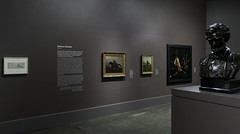
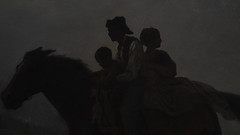

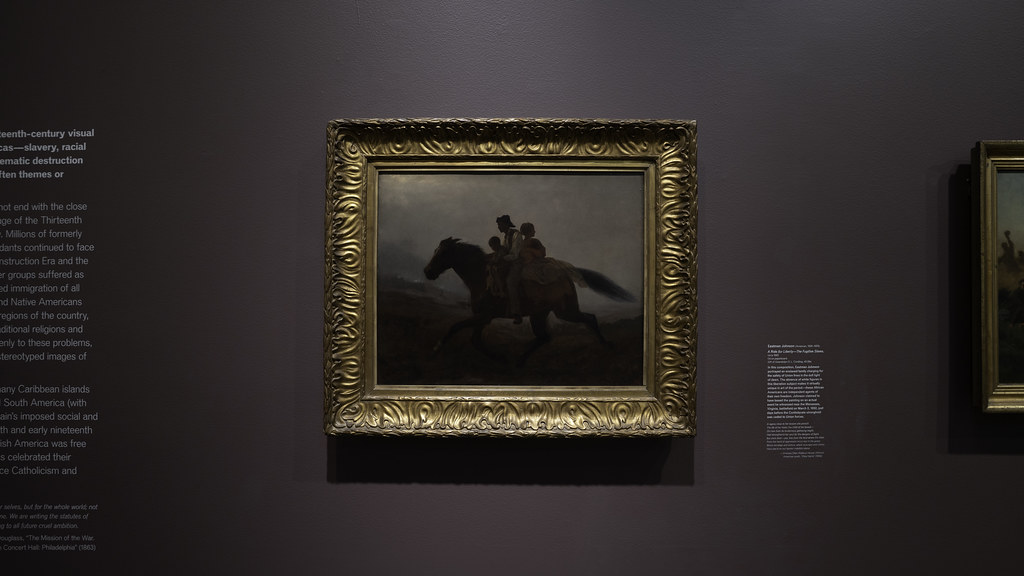
Lilly Martin Spencer, The Home of the Red, White, and Blue
Video \(\PageIndex{21}\): Lilly Martin Spencer, The Home of the Red, White, and Blue, c. 1867–68, oil on canvas, 24 x 30 inches (Terra Foundation for American Art, Daniel J. Terra Art Acquisition Endowment Fund, 2007.1), a Seeing America video Speakers: Taylor Poulin, Assistant Curator, Terra Foundation for American Art, and Beth Harris
Additional resources
This painting in the collection of the Terra Foundation of American Art
Smarthistory images for teaching and learning:

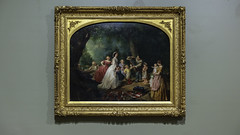
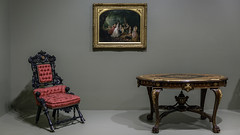
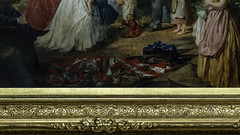


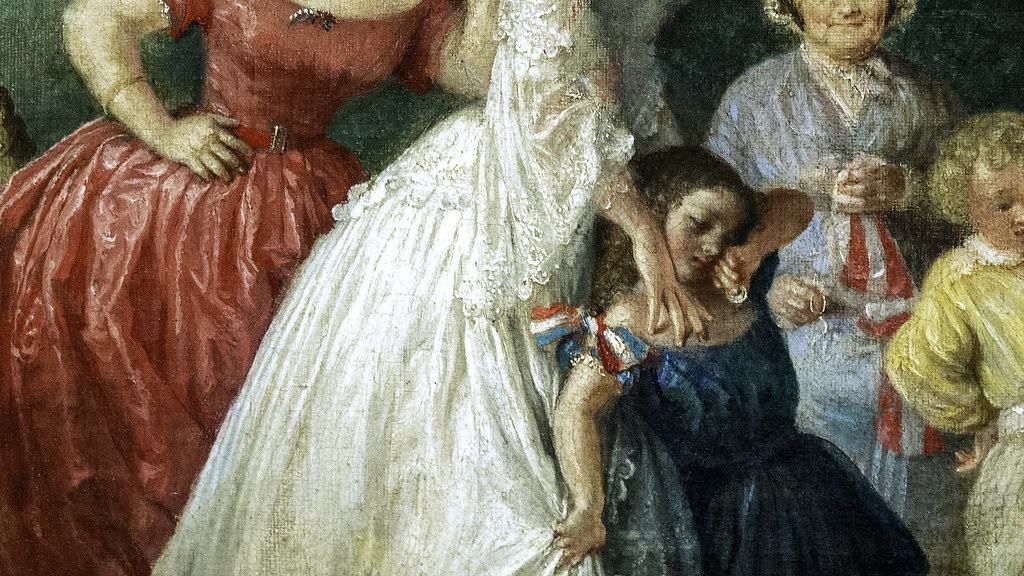
Samuel Colman, Jr., Ships Unloading, New York
Video \(\PageIndex{22}\): Samuel Colman, Jr., Ships Unloading, New York, 1868, oil on canvas mounted on board, 105 x 76 cm (The Terra Foundation for American Art, Daniel J. Terra Collection, 1984.4), a Seeing America video Speakers: Dr. Peter John Brownlee, Curator, Terra Foundation for American Art and Dr. Steven Zucker
Additional resources
This painting at the Terra Foundation for American Art
Smarthistory images for teaching and learning:
Foigure \(\PageIndex{80}\): More Smarthistory images…
Thomas Eakins, The Champion Single Sculls (Max Schmitt in a Single Scull)

More often than not, an art museum is designed to inspire quiet contemplation, encouraging visitors to stand before a painting and reflect on a work’s gravity and significance. In these somewhat contradictory private-moments-in-public-settings, many elevate these meditations to a more personal level, relating to the artwork within their own frameworks of experience and aesthetic taste. For these individuals, The Champion Single Sculls (Max Schmitt In A Single Scull) serves almost as a mirror, reflecting back a portrait of a man engaged in a similar state of introspection. At its heart, the charm of the painting is the very mood it evokes, one that is tranquil, still, even solemn. Its dimensions are not grandiose (roughly 2.5 by 4 feet), and neither is its atmosphere; this is a calm, placid painting.
The scene’s air of quietude could not be more at odds with its true subject matter, as it was meant to commemorate an athlete’s impressive victory in a physically taxing amateur rower’s race. The artist, Thomas Eakins, chose to portray the local hero not in the height of physical exertion, but instead in an anti-dramatic moment of rest during a late afternoon practice session. A Philadelphia native, Eakins completed The Champion Single Sculls upon return to his hometown after studying abroad in Paris, Madrid, and Seville. Blending the influences of his French tutors, Jean-Léon Gérôme and Léon Bonnat, as well as the work of the Spanish Baroque artist, Diego Velázquez, Eakins developed a unique style that was extremely labor-intensive and aspired to a high degree of truth to nature.

The Champion Single Sculls is ultimately a snapshot of Eakins, his environment, and his times. Utilizing the Philadelphia-area Schuylkill River as his backdrop (a landmark he would indirectly visit again in his 1877 portrait of William Rush), Eakins is domesticating an exotic genre, that of Orientalist river scenes by artists such as Gérôme and Frederick Arthur Bridgman. As for the painting’s subject, Max Schmitt was a personal friend of Eakins’, and the artist included his own self-portrait as a rower in the composition’s middle ground.
The theme of rowing plays into Eakins’ own love of sports and his tendency toward masculine themes, as well as the contemporary interest in the moral virtues and health benefits of outdoor recreational activities. In an era in which American printmakers were just beginning to take up the rowing craze and memorialize victorious single scullers as gentlemen and regional heroes, Eakins produced nineteen such rowing images.
The Champion Single Sculls debuted to mixed reviews, with one critic noting the “scattered effect” of “dealing so boldly and broadly with the commonplace in nature.” Nevertheless, it marked Eakins’ first major success by demonstrating his remarkable technical skill. It also exhibits the artist’s quirky sense of humor: instead of inscribing his signature in the painting’s corner, Eakins subtly included his name and the date on the boat he is shown rowing in the distance.
Additional resources:
This painting at The Metropolitan Museum of Art
Americans in Paris – from The Met’s Heilbrunn Timeline of Art History
Eakins letters in the collection of the Archive of American Art (Smithsonian Institution)
Video \(\PageIndex{23}\): Thomas Eakins, Portrait of Dr. Samuel D. Gross (The Gross Clinic), 1875, oil on canvas, 243.8 x 198.1 cm (Philadelphia Museum of Art) and Thomas Eakins, The Agnew Clinic, 1889, oil on canvas, 214 cm × 300 cm (Philadelphia Museum of Art)
Thomas Eakins’s deep connection to his birthplace remained a theme throughout his career. Perhaps his most well-known and ambitious work for the city of Philadelphia is The Gross Clinic, a painting completed in 1875 that spotlights the local physician Samuel David Gross.

Always a portraitist
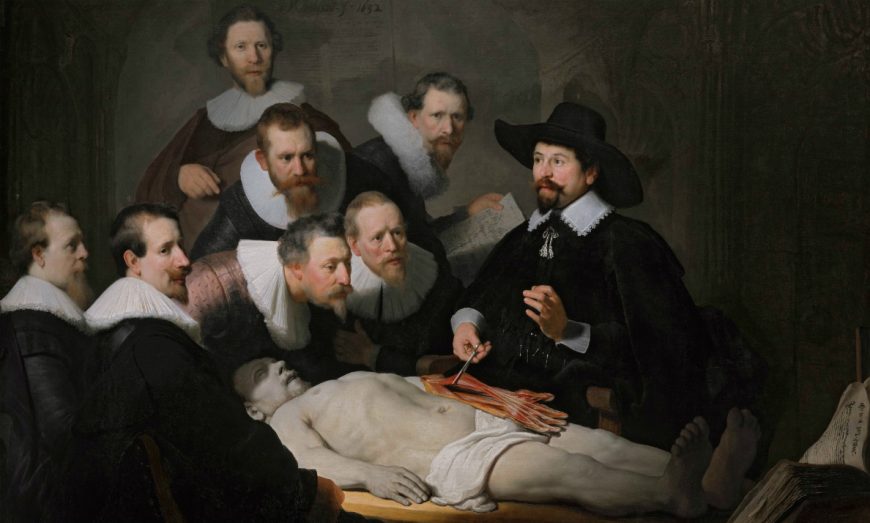
The scene depicts Gross overseeing a surgery and lecturing to a class of medical students—evoking Rembrandt’s art historical precedent The Anatomy Lesson of Dr. Tulp (1632). Much like Rembrandt’s version, The Gross Clinic documents medical sanitary procedures of its time, but the painting’s real focus are living figures. Always a portraitist, Eakins calculated the work as a visual record of all the individuals present in the medical amphitheater.
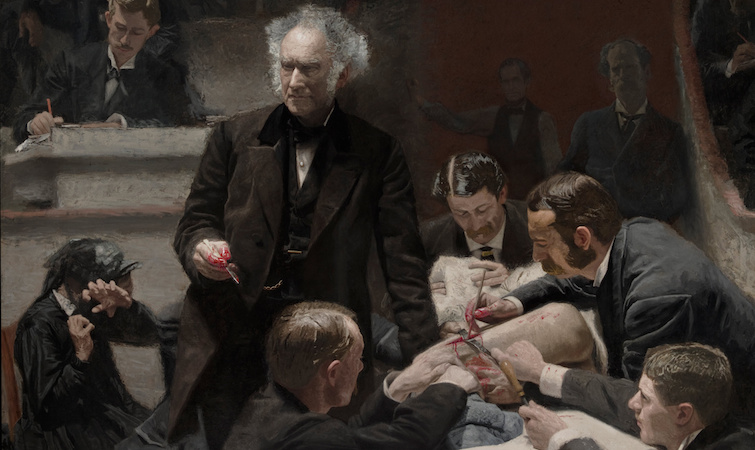
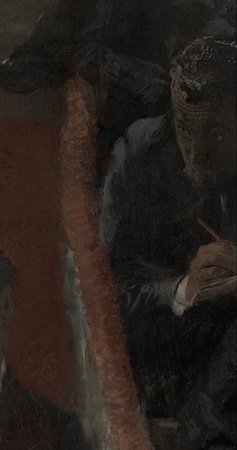
It is not solely a portrait of Dr. Gross; in addition to including the students and the assistants, Eakins inserted his own likeness among the audience – he’s the figure at the far right, sketching (one might consider Eakins the Alfred Hitchcock of nineteenth-century American painting). The core of the work is still Dr. Gross, however, as light and composition conspire to attract the eye to the esteemed lecturer.
Completed for the Centennial Exposition, Eakins intended The Gross Clinic as a statement of his artistic skill and as a way in which to affirm himself as a hero of Philadelphia. Though the work was rejected, the tactic was overall a success. While some critics lashed out against its gruesome subject matter, seemingly vulgar treatment, and inherent melodrama (note the near-swooning, hysterical woman in the left middle ground), viewers were nonetheless captivated by the work’s theatricality. Through his mastery of rendering convincing volume, individual representation, and psychological intensity, Eakins showcases his academic training and—in a style that has been dubbed “scientific realism”—reveals an uncompromising desire to portray honest details of form, depth, and proportion. He was obsessed with accuracy, and was known to project photographs onto canvases in order to laboriously trace figures though also to shift objects for a more harmoniously composed scene.
A Philadelphia painting

After The Gross Clinic’s exhibition at the U.S. Army Post Hospital—in a first-aid room meant to introduce viewers to modern medical paraphernalia—the Jefferson Medical College (where Eakins himself had taken anatomy classes) was given the painting by an alumni. A reproduction now hangs in the school, which sold the original in 2006. The work was considered so central to the history of Philadelphia, however, that the city’s two major art museums successfully rallied support to keep the tour de force in town with an ambitious fundraising effort that proved the work’s enduring value and underscored the fact that cultural artifacts can ignite complex debates. In closing, it should be noted that The Gross Clinic is not the only such medical scene Eakins produced. He later returned to the same popular formula to honor the surgeon David Hayes Agnew in a similarly composed (and equally controversial) work entitled The Agnew Clinic (1889), also on display at the Philadelphia Museum of Art.
Additional resources:
This painting at the Philadelphia Museum of Art
The Gross Clinic at Jefferson University
Winslow Homer, The Life Line
Video \(\PageIndex{24}\): Winslow Homer, The Life Line, 1884, oil on canvas, 28-5/8 x 44-3/4 inches / 72.7 x 113.7 cm (Philadelphia Museum of Art)
Smarthistory images for teaching and learning:

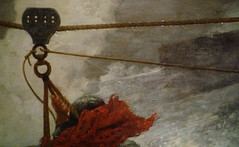
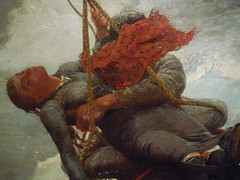
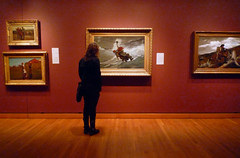
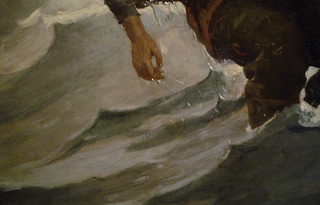
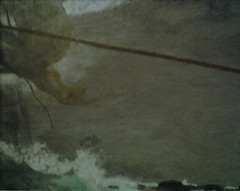
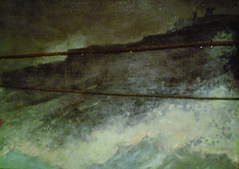
Winslow Homer, The Fog Warning (or Halibut Fishing)
Video \(\PageIndex{25}\): Winslow Homer, The Fog Warning (or Halibut Fishing), 1885, oil on canvas, 30-1/4 x 48-1/2 inches / 76.83 x 123.19 cm (Museum of Fine Arts, Boston)
Smarthistory images for teaching and learning:

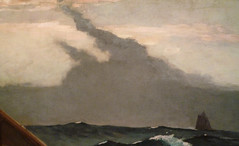
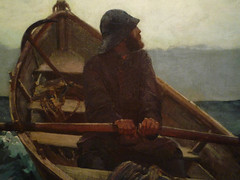


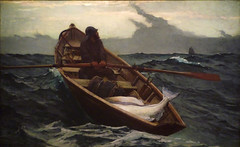


Winslow Homer, Northeaster
Video \(\PageIndex{26}\): Winslow Homer, Northeaster, 1895, reworked by 1901, oil on canvas, 34 1/2 x 50″ / 87.6 x 127 cm (The Metropolitan Museum of Art, New York). Video from The Metropolitan Museum of Art. Speaker: Met curator H. Barbara Weinberg.
Grafton Tyler Brown, View of the Lower Falls, Grand Canyon of the Yellowstone


In May of 1903, the twenty-sixth President of the United States, Theodore Roosevelt, made a visit to the state of Arizona as a part of his Western tour across the country during the first term of his presidency. He had come expressly to see the Grand Canyon, a natural wonder not only particular to America, but to the world one of the nation’s crowning glories. In a speech delivered at the canyon on May 6, Roosevelt eloquently articulated what would become the defining mission statement of the conservation movement in America throughout the twentieth century:
“In the Grand Canyon, Arizona has a natural wonder which, so far as I know, is in kind absolutely unparalleled throughout the rest of the world. I want to ask you to do one thing in connection with it in your own interest and in the interest of the country to keep this great wonder of nature as it now is…Leave it as it is. You cannot improve on it. The ages have been at work on it, and man can only mar it. What you can do is to keep it for your children, your children’s children, and for all who come after you, as one of the great sights which every American, if he can travel at all, should see.” (Theodore Roosevelt, Grand Canyon Speech, May 6, 1903)
“Leave it as it is.” A straightforward plea, but one that was intended to caution a society that had been zealous in its need for industrialization and Westward expansion throughout the nineteenth and twentieth century at the expense of dwindling natural resources.

The 1890 painting above of the falls of the Grand Canyon of the Yellowstone by Grafton Tyler Brown exemplifies the sentiment behind Roosevelt’s impassioned speech even as it depicts a different Grand Canyon, the one found at Yellowstone in Wyoming, not Arizona. Grafton Brown, the first African American artist to paint extensive scenes of the West and Pacific Northwest, understood implicitly that he was painting a view of a rare natural monument to preserve for posterity.
When Grafton Brown came to Yellowstone National Park in Wyoming, the park was officially only 18 years old (President Ulysses Grant had signed its status into law on March 1, 1872). Brown had settled in Portland, Oregon in 1866 after a prolific career as a lithographer and cartographer in San Francisco in the 1860s, nearly a decade after the heady days of the California gold rush. In 1890, Brown traveled to Yosemite and Yellowstone to paint its signature features, its geysers, mountains, canyons, and falls, for audiences who were hungry for the curiosities and wonders of the West.


The opening of the Northern Pacific Railway in 1883, which linked the states of the Great Lakes to the West towards Montana, facilitated a surge in tourism and travel to the newly appropriated National Parks. When Rudyard Kipling visited Yellowstone in 1889, he wrote in his journals that he encountered “The Wonderland” one has only read about in books. On gazing at the splendor of the falls at the Yellowstone’s Grand Canyon, Kipling, recounted his awe:
“All I can say is without warning or preparation, I looked into a gulf 1,700 feet deep with eagles and fish hawks circling far below. The sides of that gulf were one wild welter of color—crimson, emerald, cobalt, ochre, amber, honey splashed with port wine, snow white, vermillion, lemon, and silver gray in wide washes. So far below that no sound of its strife could reach us. Now I know what it is to sit enthroned amid the clouds of sunset.”
It is this view that Grafton Tyler Brown shows us in his 1890 painting of the falls. Brown focuses the central image at an upward right angle looking down towards the falls and the canyon so that the viewer experiences a sense of being engulfed in the upward rising of the red cliffs and the surging blue spray. The grandeur and majesty described by Kipling is conveyed in Brown’s image through the careful play of dark and light, as the sun spreads across the top half of the falls and canyon in a diagonal sweep covering the pines and the bridge on the left in shadow. Though Brown’s image of the falls emphasizes their dramatic beauty, it is different from the familiar paintings of the West’s mountains and canyons by artists like Albert Bierstadt and Thomas Moran with their overt religious symbolism and deeply scaled, dramatic use of light.

Brown’s background as a lithographer and cartographer inclined him towards rendering a more scientific, de-romanticized image of the Grand Canyon of the Yellowstone. The skills that Brown had learned as a cartographer and draftsman in San Francisco in the 1860s gave him an analytical eye with which to draw and paint the Grand Canyon with precision and clarity free from religious or sentimental associations.

Throughout the late nineteenth century, there was palpable anxiety felt by many across America that the country’s vast natural resources were being irrevocably diminished and destroyed as the nation industrialized and expanded Westward. The United States census of 1890 contended that with each passing year the development in the name of progress was “redeeming wilderness by the hand of man.”* As railroads stretched across the country, Native Americans were systemically driven from their homelands and forced onto reservations. The once vast bison herds were being hunted, forests cut for pasture, and the once abundant passenger pigeon was driven to extinction. The bountiful American Eden seemed to be vanishing. It wouldn’t be until the late nineteenth century with the pioneering efforts of conservationists like John Muir, George Bird Grinnell, and Theodore Roosevelt, that Americans would become concerned with safeguarding their land and wildlife.

Though Grafton Tyler Brown was the first black painter to devote himself to depicting scenes of the Pacific Northwest and the West, the history of African Americans within the National Park system is a rich and varied one. Between 1891 and 1913, the soldiers of the 9th and 10th Cavalry and the 24th and 25th Infantry, the Buffalo Soldiers, were assigned with protecting Yosemite National Park and Sequoia National Park from poachers and timber thieves. Not only did these first park rangers face the routine challenge of having to assert their authority against those who refused to recognize the protected status of the park’s trees and wildlife, but the added burden of racism—so endemic at the time in post-Reconstruction era America—put the Buffalo Soldiers in a dangerous position.
Brown was often the subject of commonplace racial prejudice in San Francisco during the 1860s, a somewhat boisterous coastal boom-town in the aftermath of the Gold Rush that was filled with transplanted Southerners and Midwesterners. Due to his mixed race background, he was often referred to as a “mulatto” or “quadroon,” meaning that he perhaps had three Caucasian grandparents. Living and working in the West with its semi-lawless frontier towns and pockets of intolerance must have been a challenging and emotionally trying experience for a sensitive, educated Eastern-born son of a freedman, but Brown’s prolific body of work in the thirty years after he moved to San Francisco exemplify his remarkable talent and endurance as an artist.

By 1893, Brown had settled in St. Paul, Minnesota where he began work as a cartographer and consultant with the U.S. Army Corps of Engineers and the city’s engineering department. He would remain in Minnesota until his death in 1918.
Grafton Tyler Brown’s career showcases the astonishing efforts of an extraordinary, yet sadly, relatively ignored artist who persevered despite the racial intolerance of the late nineteenth century to forge a fascinating body of work that painstakingly documents the beauty of America’s western landscapes.
* As quoted by Dayton Duncan, “George Melendez Wright and the National Park Idea,” National Park Service Centennial Essay Series
Additional resources:
Robert J. Chandler, San Francisco Lithographer: African American Artist Grafton Tyler Brown (University of Oklahoma Press, 2014).
Dreck Spurlock Wilson, ed., African-American Architects: A Biographical Dictionary, 1865-1945 (Routledge, 2004).
William Loren Katz, The Black West: A Documentary and Pictorial History of the African American Role in the Westward Expansion of the United States (Touchstone, 1996).
Western art
Thomas Moran, Grand Canyon of the Yellowstone
Video \(\PageIndex{27}\): Thomas Moran, Grand Canyon of the Yellowstone, 1872, oil on canvas mounted on aluminum, 213 x 266.3 cm (Smithsonian American Art Museum) Speakers: Dr. Eleanor Jones Harvey, Senior Curator, Smithsonian American Art Museum and Dr. Beth Harris
Additional resources
Smarthistory images for teaching and learning:
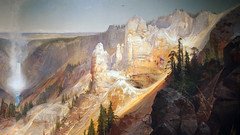
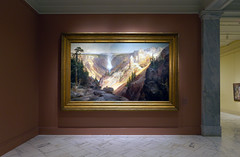
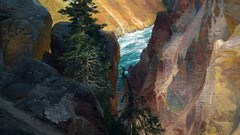
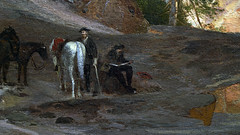

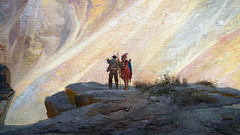

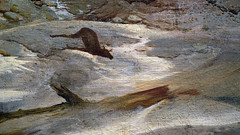
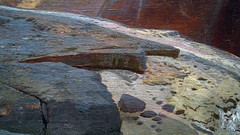
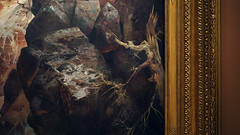
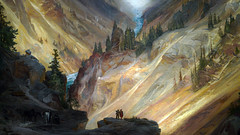
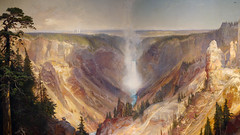
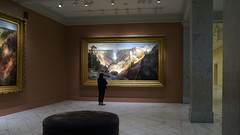
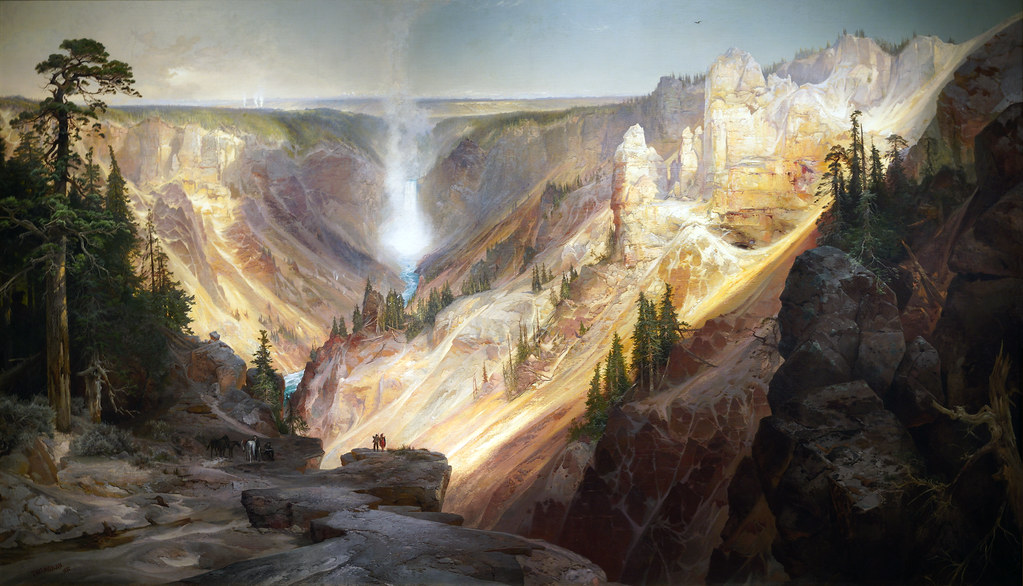
Frederic Remington, The Fall of the Cowboy
Video \(\PageIndex{28}\): Frederic Remington, The Fall of the Cowboy, 1895, oil on canvas, 24 x 35 1/8 inches (Amon Carter Museum of American Art), a Seeing America video Speakers: Sara Klein, Teacher and School Programs Manager, Amon Carter Museum of American Art and Steven Zucker
Aestheticism and the Gilded Age
Though American, both Whistler and Sargent worked and exhibited in Europe. Their patrons were often the wealthy industrialists who characterized the Gilded Age.
c. 1862 - 1900
Whistler, Symphony in White, No. 1: The White Girl
Radical portraiture
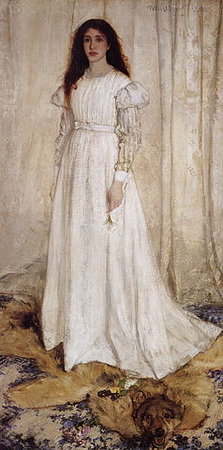
The woman in white stands facing us, her long hair loose, framing her face. Her expression is blank, her surroundings indistinct; posed before some sort of pallid curtain, she appears almost as an immobile prop on a stage.
Symphony in White, No. 1: The White Girl epitomizes James Abbott McNeill Whistler’s departure from the established norms of the era, and was perhaps his most reviled work. When he submitted it to the 1863 Paris Salon, the jury rejected the painting and the artist instead showed The White Girl at Napoleon III’s exhibition of snubbed artwork, the Salon des Refusés. Though it certainly defied many time-honored artistic conventions and earned much derision from critics, The White Girl does show some echoes of older standards. After all, its creator had studied under Marc-Charles Gabriel Gleyre in Paris, learning to paint in the academic manner – thus it is unsurprising that in the representation of his mistress, Joanna Hiffernan, Whistler opts for the customary full-scale society portrait format, and reproduces her features in a seemingly realistic and honest fashion.

The ways in which Whistler follows his own rules, however, far outnumber the few examples of accord, and they include the painting’s flattened and abstracted forms, distorted perspective, limited color palette, and penchant for decorative patterning. Though an intimate portrait, The White Girl is contrived and reveals no overarching mood or the personality of its sitter. While many of Whistler’s stylistic innovations are unique to the artist, he associated himself with other artists – such as Édouard Manet and Gustave Courbet, who also defied the traditions of academicism. The influence of Théophile Gautier is also apparent; in the 1830s, Gautier stated that art need not contain any moral message or describe any narrative, as art making is an end in and of itself – Whistler accepted this credo, “art for art’s sake,” wholeheartedly. In this light, The White Girl is less a faithful portrait painting and more an experimentation in color, pattern, and texture.


Whistler produced many portraits of similar format in the next decades, and continued to fine-tune his style and technique. In paintings such as Harmony in Gray and Green: Cecily Alexander (1872-74) and Arrangement in Flesh Color and Black: Portrait of Théodore Duret (1883), the artist exercised his need to balance the realist components of a picture with its more abstract needs, cherry-picking elements from the real world and reorganizing them in controlled, harmonious ways. Often these images feature a subdued palette, a lack of depth, unresolved backdrops, and irrational props that serve only as accents. His figures typically stand upon an unthinkably flat floor, appearing almost to hover like specters. As for Whistler’s signature, it evolved to take the form of a butterfly, applied to the surface in the manner of a mere decorative element.
Despite the controversy stirred when he entered the scene, Whistler won many wealthy and prestigious patrons over his career, and his portraits stand as testaments to growing interest in the radical new avant-garde approach to painting.
Whistler, Nocturne in Black and Gold: The Falling Rocket

A personal interpretation
One might say that for some artworks, seeing beyond the artist’s intention to form a more indefinite, personal interpretation is, ironically, the creator’s ultimate objective after all. Much like Alice stepping tentatively through the two-dimensional plane of the looking glass into the possibilities beyond, the viewer is invited to deduce his own meaning, to form his own associations, thus essentially taking part in the creative process itself. While ambiguity is standard in the conceptual contemporary pieces of today, what mattered most in early American art was what could be read on the surface: narrative clarity, illusionistic detail, realism, and straightforward moral instruction. When did things change? Perhaps, it seems, around the time avant-garde artists began to pursue abstraction, flirt with modernism, and challenge the aesthetic standards of the past.
Consider Nocturne in Black and Gold: The Falling Rocket of 1875. In the mass of shadowy dark hues, vague wandering figures, and splashes of brilliant color, museum-goers might construe myriad meanings from the same scene: perhaps sparks from a blazing campfire, flickering Japanese lanterns, or visions of far-off galaxies mystically appearing on a clear summer night. Indeed, while the Massachusetts-born artist James Abbott McNeill Whistler (1834-1903) was inspired by a specific event (a fireworks display over London’s Cremorne Gardens) the intangibility, both in appearance and theme, of the oil on panel was deliberate. The questions it conjures, the emotions it evokes, may differ from one viewer to another, and frankly, that’s the point.

“flinging a pot of paint in the public’s face”

The Falling Rocket resonates with many 21st-century beholders, yet when it was first exhibited at a London gallery in 1877, detractors deemed the painting too slapdash, incomprehensible, even insulting. Art critic John Ruskin dismissed Whistler’s effort as “flinging a pot of paint in the public’s face,” as in his opinion it contained no social value. In response, Whistler – cheeky man that he was – sued Ruskin for libel, and though he won the case in court, he was awarded only a farthing in damages. During the highly publicized trial, the artist defended his series of atmospheric “nocturnes” as artistic arrangements whose worth lay not in any imitative aspects but in their basis in transcendent ideals of harmony and beauty.
Music
Whistler saw his paintings as musical compositions illustrated visually, and delineated this idea is his famed “Ten O’Clock” lecture of 1885:
Nature contains the elements, in colour and form, of all pictures, as the keyboard contains the notes of all music. But the artist is born to pick and choose… that the result may be beautiful – as the musician gathers his notes, and forms his chords, until he brings forth from chaos glorious harmony.

Many of his titles incorporate allusions to music: “nocturnes,” “symphonies,” “arrangements,” and “harmonies.” The immaterial, the spiritual – these principles are subtly interwoven throughout Whistler’s oeuvre, and he preached his ideas on the new religion of art throughout his career.
Additional resources:
This painting at the Detroit Institute of Arts
Exhibition titled Whistler and His Followers at the Detroit Institute of Arts
John Singer Sargent, El Jaleo
El Jaleo is housed within the quirky Isabella Stewart Gardner Museum, a Gilded Age art collection that serves as a window into the eponymous collector’s life and unique aesthetic taste. In order to view the painting, you must pass by the sunlit faux-Venetian courtyard and into the shadows of the first floor’s Spanish Cloister. Here El Jaleo hangs at the end of a long hallway, its immense size (over 7 by 11½ feet) almost fully covering the far wall of a dark niche. Its mildly claustrophobic and somewhat out-of-the-way physical location lends the striking oil on canvas one of the most intimate settings for a work of art on display in an American museum.

The raw passion of the dance
The scene portrayed is a dynamic one: a group of musicians provides the rhythm for a lone flamenco dancer who performs for an audience of clapping listeners. It is a snapshot of a specific point in time: the apex of the dance, a moment rife with energy and sensual drama. The footlights cast haunting silhouettes on the rear wall; the raw passion of the dance is palpable. The stark contrasts between murky shadow and dazzling illumination allow the painting to visually pop – a phrase that is often used in describing art but rarely so aptly. Due to the loose, frothy brushstrokes, there isn’t the sense of a true illusionary space, yet the light (and hence the vitality) of the scene seems to emanate outward from within the work, as though El Jaleo commands a life of its own.
American, but born and studied abroad
El Jaleo’s precocious artist, John Singer Sargent, painted the artwork in 1882 at the young age of 26. Both the painting and its creator are evocative of the times, reflective of the nineteenth-century American fascination with, and inherent dependence upon, foreign cultures for both technical training and artistic inspiration.

Though labeled an American artist, Sargent was actually born in Florence to a Philadelphia family and traveled throughout his youth and career. In the late 1800s this type of background became the rule rather than the exception, with expatriate Americans taking advantage of the more accessible education opportunities abroad. Beyond the official state écoles (schools), private Parisian ateliers (studios) led by renowned artists offered instruction to admitted American students; Sargent studied under one such teacher, Charles Émile Auguste Durand, aka Carolus-Duran. The competitive annual salons (exhibitions) were another draw for foreign-born artists and these venues could win a painting great critical acclaim, as did the Paris Salon of 1882 for El Jaleo.
It was not uncommon for works at the salons to depict exotic subject matter, and Sargent’s admiration for Spanish music and culture was a continuing theme throughout his career, notably resurrected for this 1890 portrait La Carmencita (Musée d’Orsay, Paris).
John Singer Sargent, The Daughters of Edward Darley Boit

Another painting exhibited at the Paris Salon and designed to showcase Sargent’s talent was The Daughters of Edward Darley Boit, a commissioned life-sized group portrait of a wealthy Bostonian’s four daughters posed within the foyer of the family’s Parisian apartment. The girls have highly individualized representations, each bestowed her own unique position, though they do not interact. Again Sargent reveals interest in the interplay of light and shadow, of clarity and obscurity. The treatment is uncannily beautiful, though somewhat unsettling: breaking with conventional portraiture, one of the girl’s faces isn’t even visible to the beholder, and the asymmetrical composition, the inclusion of empty space, and the isolation of the figures all add to the sense of quiet unease. As with El Jaleo, The Daughters of Edward Darley Boit certainly succeeds in evoking a particular mood.

Influence of Velásquez
Sargent’s style is a clear testament to his artistic training. His instructor Carolus-Duran encouraged students to study the work of seventeenth-century Spanish master Diego Velázquez, and here Sargent produces a modern reimagining of Velázquez’s famed Las Meninas of 1656. Unlike the tightly polished and refined brushwork of contemporaries such as Jean-Léon Gérôme, Sargent preferred a painterly approach more akin to the Spanish Baroque. Sargent carried this brushier style into other works as well, including Impressionistic landscapes and outdoor watercolor experiments.


The vases
It should be mentioned that the two oversize Japanese porcelain vases pictured in the apartment were also donated by the Boit family to the Boston Museum of Fine Arts, and are exhibited beside Sargent’s painting. This is a noteworthy stroke of luck that provides a rare opportunity for the viewer to more fully immerse himself in the scene portrayed, to transcend the boundary between the world captured in the art and the historical foundation on which it was based.
Additional resources:
This painting at the Museum of Fine Arts, Boston
Video of the painting’s visit to the Museo National del Prado
Sargent’s letters at the Smithsonian’s Archives of American Art
John Singer Sargent, Madame X (Madame Pierre Gautreau)

A controversial beauty
Madame X is perhaps Sargent’s most infamous painting. When it debuted at the Paris Salon of 1884, critics lashed out at the artist for what they deemed a scandalous, immoral image. While the title omitted the sitter’s name, the public immediately recognized her as the notorious Parisian beauty Virginie Gautreau. The gown’s plunging neckline was considered too provocative for the times, and its right strap – which originally was shown to have slipped off the shoulder – ultimately led to Sargent repainting it in its proper position to appease outraged viewers and Gautreau’s own family.
Madame X mixes the Gilded Age penchant for portraying status and wealth in portraiture with a daring seductive aesthetic. For all that it shocked onlookers, however, much of its details were based in older classical traditions: Madame Gautreau’s hairstyle is based on one of ancient Greece, and she wears a diamond crescent that is the symbol of the huntress Diana.
A reputation secured
John Singer Sargent intended the portrait to establish his reputation, and despite the notoriety it attracted, the work did succeed: Madame X advertized his ability to paint his sitters in the most flattering and fashionable manner possible, and led to a healthy career in Britain and great esteem in America from the late 1880s onward. Though he was born oversees, traveled worldwide, and spent much of his life abroad, Sargent’s career truly matured in his family’s native land, and he always considered himself an American artist. He toiled for nearly three decades on a mural commission for the Boston Public Library, he frequently painted fellow American expatriates, and in 1906 he was appointed full academician of the National Academy of Design in New York.

In 1916 the Metropolitan Museum of Art bought Madame X, which Sargent considered “the best thing I have done.” The painting—which debuted to severe disparagement but is today treasured as a masterpiece beloved in the history of Western art—is but one example of an artwork that gradually evolved from epitomizing the condemned to the celebrated. Much of a work’s initial reception is based upon society’s tastes, standards of etiquette, and values of the era, and as these attitudes shift over the decades, the public may begin to look at older paintings with new eyes. Sargent’s Madame X is perhaps a more dramatic example of this trend, yet it poses intriguing questions about what really defines an artwork’s popularity, legacy, and fame.
John Singer Sargent, Carnation, Lily, Lily, Rose
Video \(\PageIndex{29}\): John Singer Sargent, Carnation, Lily, Lily, Rose, 1885-86, oil on canvas, 1740 x 1537 mm (Tate Britain, London), speakers Dr. Beth Harris and Dr. Steven Zucker
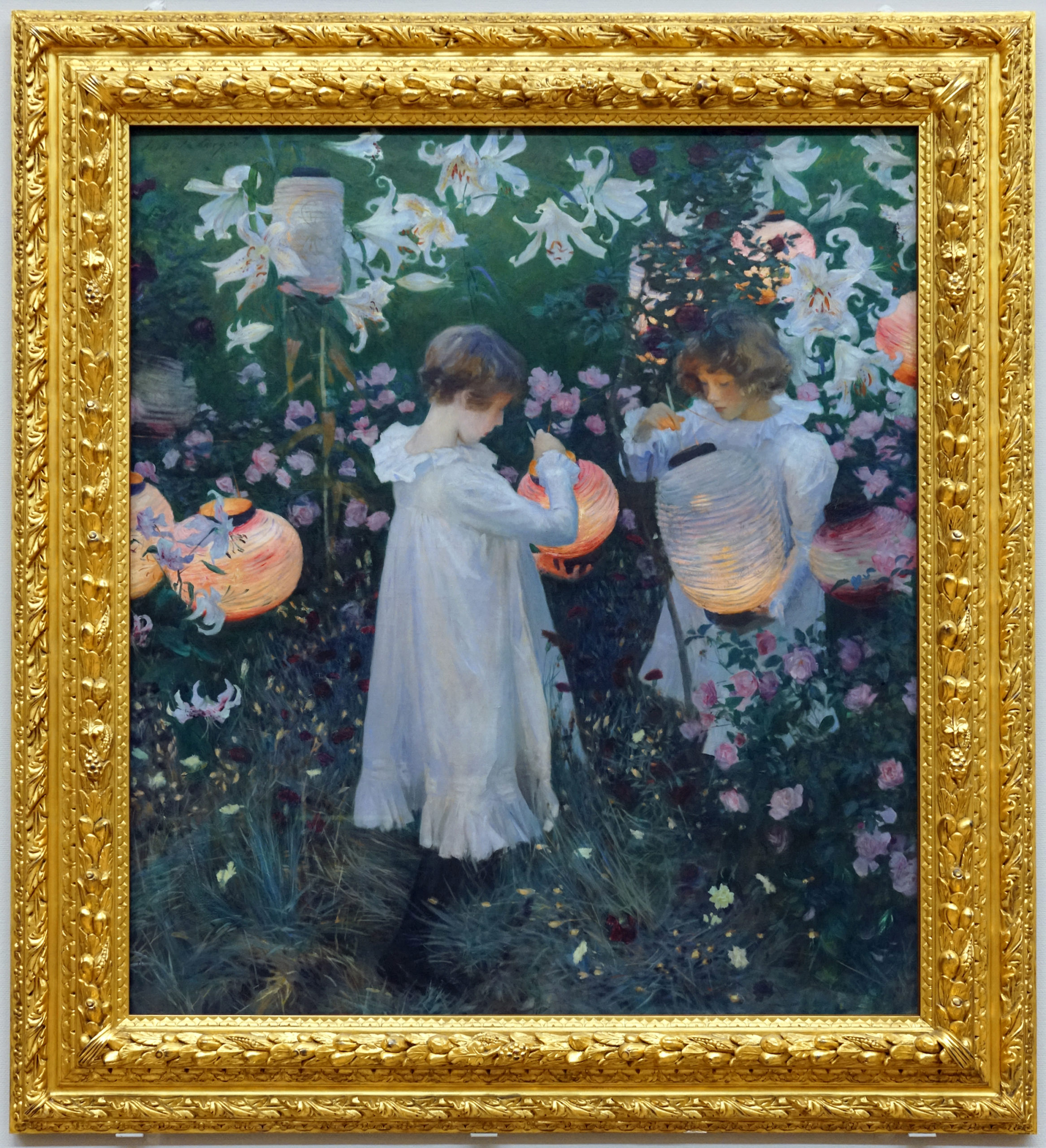
Shepherds tell me have you seen,
Have you seen my Flora pass this way?
A wreath around her head, around her head she wore,
Carnation, lily, lily, rose,…
The chorus of a popular song by composer Joseph Mazzinghi was the inspiration for the title of John Singer Sargent’s painting Carnation, Lily, Lily, Rose. In Sargent’s hands, however, the pastoral images of the song have been banished, replaced by an evocative twilight scene of children, flowers, and Chinese lanterns. The muted light and colors, unusual angles, and the lack of narrative content combine to create a beautifully rendered moment, capturing the fleeting atmosphere of dusk and the innocence of childhood.
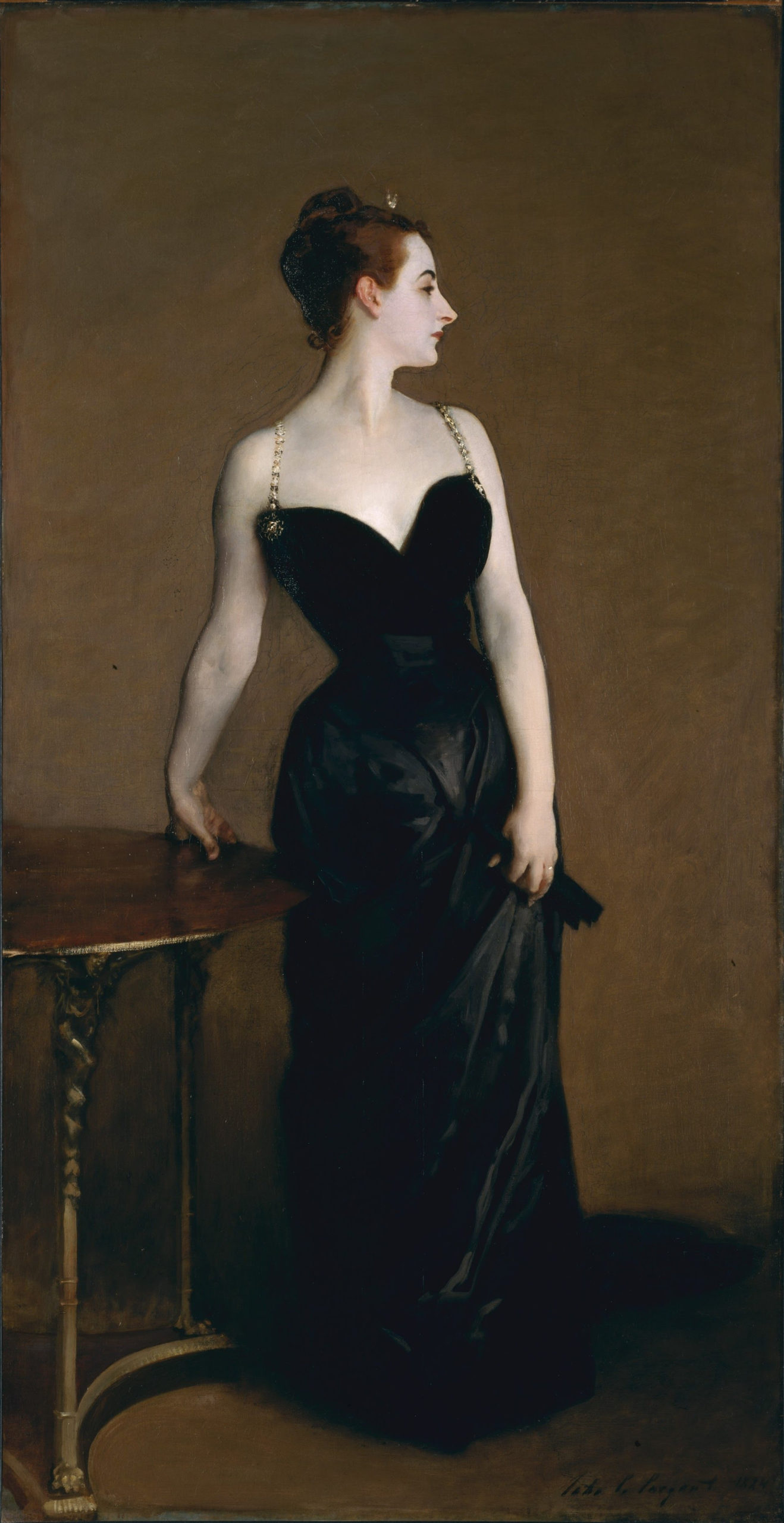
Carnation, Lily, Lily, Rose was painted in the English village of Broadway. The artist had moved to London after leaving France due to the scandal caused by his painting Madame X, which was exhibited at the Paris Salon in 1884. Sargent’s striking female portrait was the subject of enormous controversy due to the plunging neckline of her dress and the fact that originally one strap had been hanging off her shoulder (this was later repainted firmly in its correct place). Although the sitter, Virginie Gautreau, a fellow expatriate American who had married a French banker, was not explicitly identified, audiences recognized the likeness as well as her habit of using lavender dusting powder. Rumors of Gautreau’s infidelities were rampant, so the risqué portrait added fuel to the fire, for both artist and sitter.
For several years after his move to England, Sargent spent his summers in Broadway, a picturesque village in the Cotswolds, which was also the site of a thriving artist’s colony in the late 19th century. Both English and American artists and writers congregated there, and Sargent joined an expatriate community including such notables as Frank Millet, Edwin Austin Abbey and the writer Henry James. According to James in an article published in Harper’s New Monthly Magazine in 1889, “Broadway and much of the land about it are in short the perfection of the old English rural tradition,” and here Sargent found both acceptance and inspiration for his work.
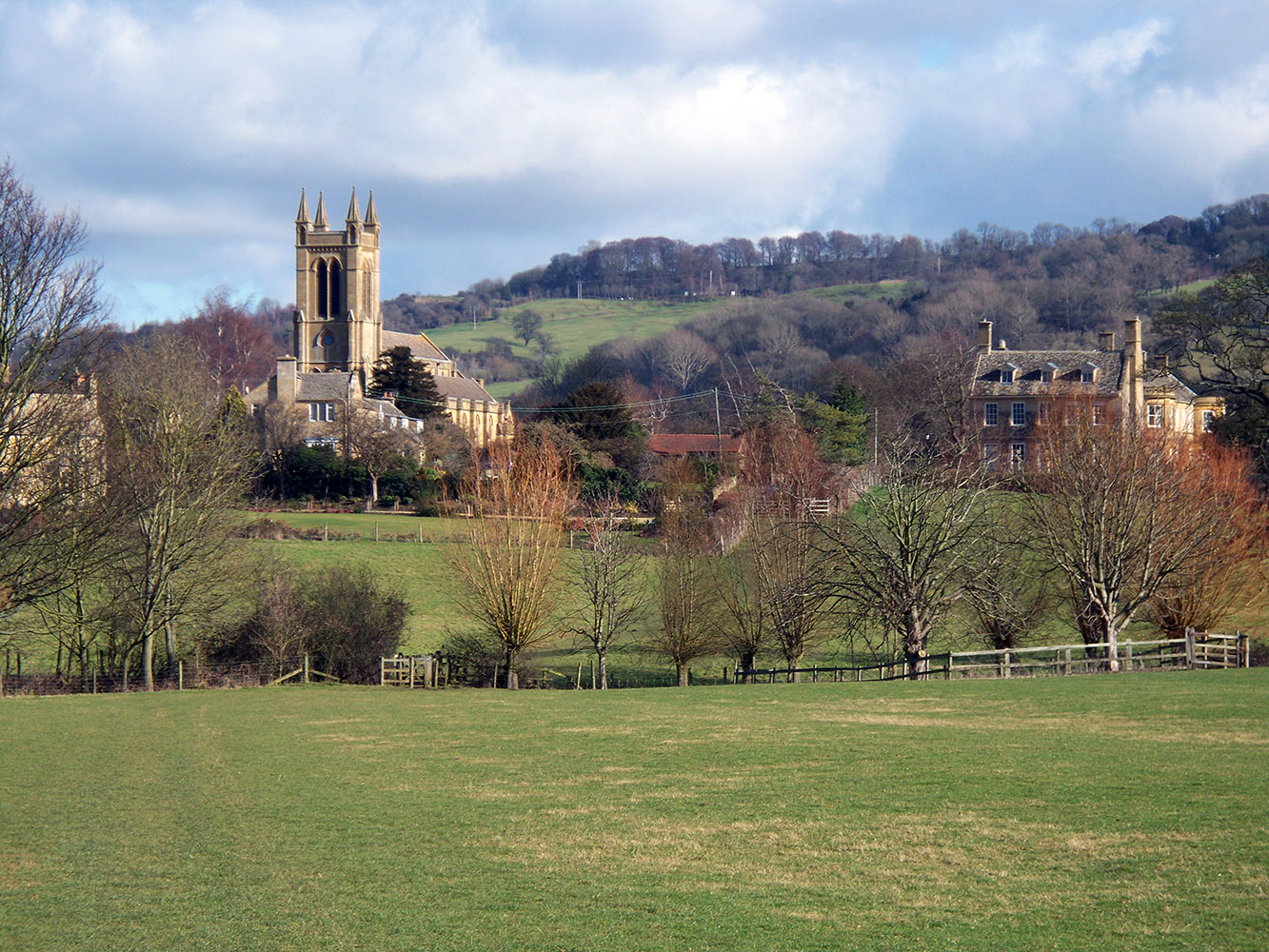
Sargent got the idea for the painting in August of 1885 after seeing a group of children among flowers and Chinese lanterns hung among trees in the village of Pangbourne in Berkshire. He spent more than a year trying to bring his vision to fruition. In letters, he pointed out that he was hindered from completing the painting in September because it was the end of the flowering season. Taking no chances, when he returned to Broadway to finish the painting in the summer of 1886, he had a friend grow lilies in pots to extend his available time for working on the painting.

In addition to the problem of maintaining blossoms, Sargent was plagued by other issues. His original intent for the composition was to use one younger child, but he was eventually forced to select little girls who were a bit older and able to pose as required. White dresses for the girls were specially designed. Most importantly, the painting was completed “en plein air” to get the correct effect of light, but given the fleeting nature of light at dusk, he could only paint for a few minutes each day.
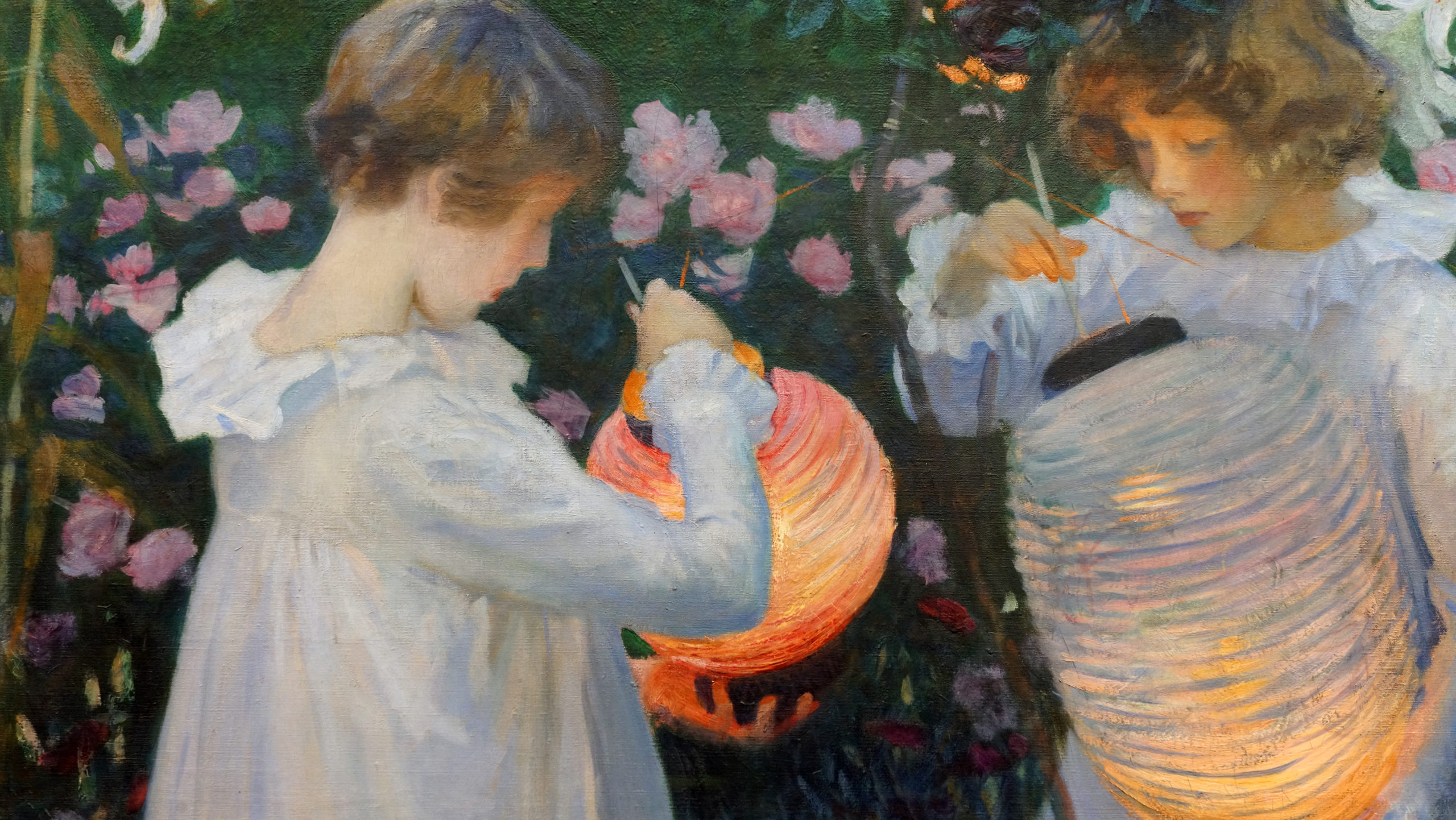
However, the effort that went into Carnation, Lily, Lily, Rose proved worthwhile. The painting was well received by both audiences and critics when it was exhibited at the Royal Academy in 1887 and was immediately purchased for the British nation by the Chantrey Bequest, a fund established by sculptor Sir Francis Chantrey to acquire works of art made in England. The subtle effects of light illuminating the faces of the little girls, the subtly sketchy brushwork, the unusual angle looking down at the children (taken from the influence of Japanese prints), and the attention to capturing the momentary changes of twilight all speak to Sargent’s modernity.
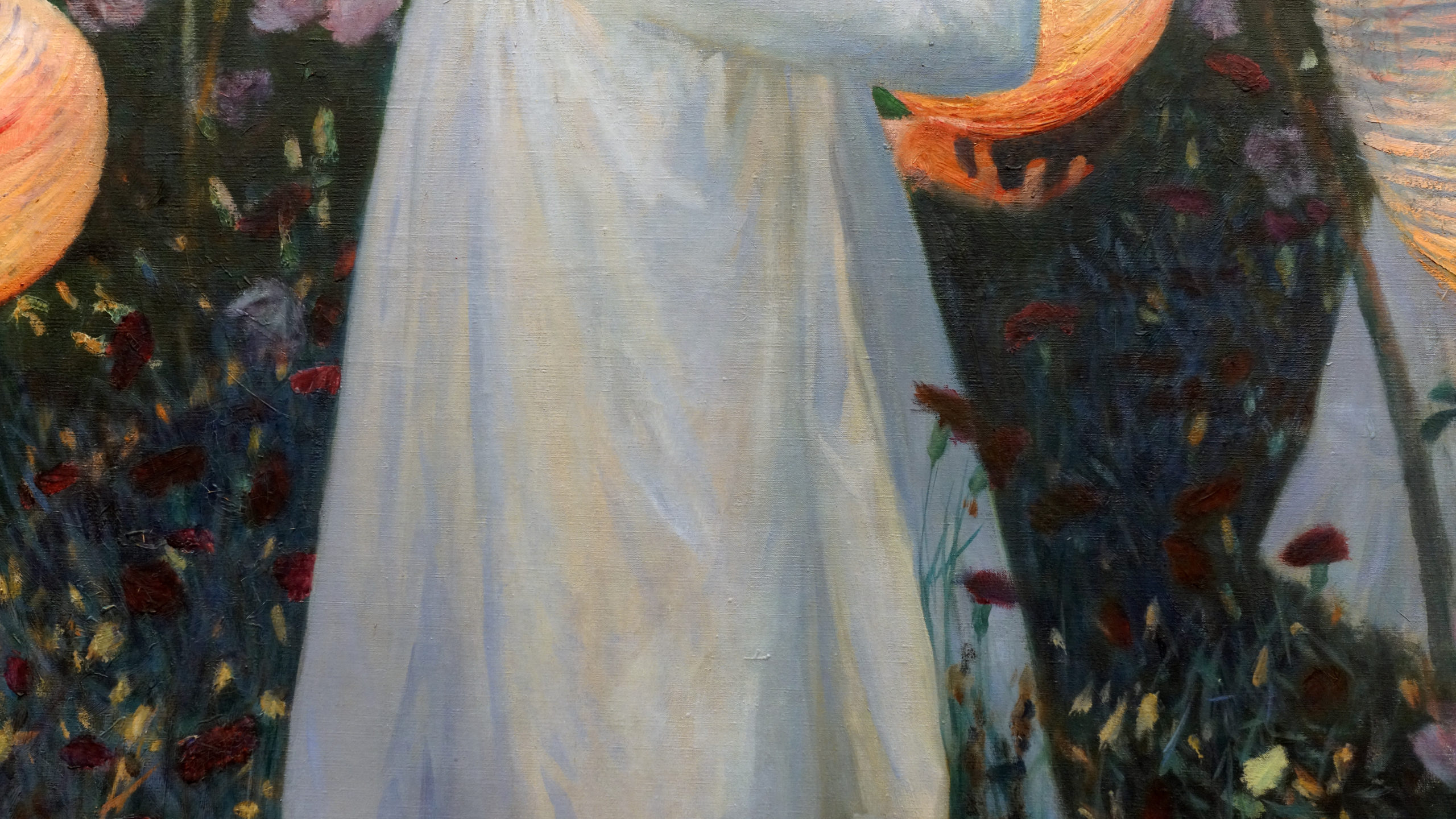
Sargent’s painting is a combination of several radical ideas found in the art of the end of the 19th century. Like Impressionism, it captures a distinct moment. In an instant, the children could move, or the light change and the spell would be broken. It is worth pointing out that Sargent was friends with Claude Monet and had in fact been invited to exhibit with the Impressionist group, an honor he declined. The picture is also firmly associated with the Aesthetic Movement, with its insistence on beautiful subjects and a lack of narrative content. Like the song that inspired its title, the painting reminds the viewer of a simpler time, creating a quietly beautiful snapshot of a bygone era.

Additional resources
Smarthistory images for teaching and learning:
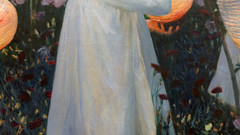
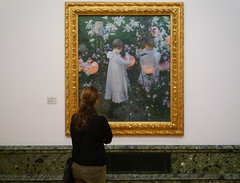
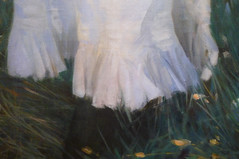
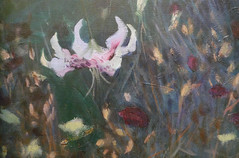
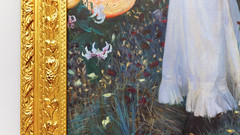
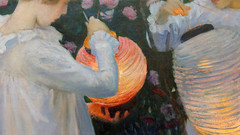

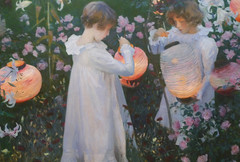
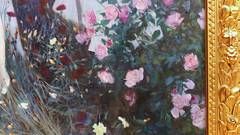

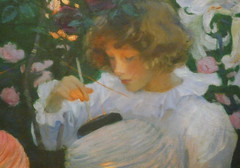


Childe Hassam, Horticulture Building, World’s Columbian Exposition, Chicago
Video \(\PageIndex{30}\): Childe Hassam, Horticulture Building, World’s Columbian Exposition, Chicago, 1893, oil on canvas 18-1/2 x 26-1/4 inches / 47.0 x 66.7 cm (Terra Foundation for American Art, Daniel J. Terra Collection, 1999.67), a Seeing America video. Speakers: Dr. Katherine Bourguignon, Curator, Terra Foundation for American Art, and Dr. Beth Harris
Additional resources
This painting at the Terra Foundation for American Art
Sculpture, architecture and photography
Sculpture and architecture created a sense of civic identity, while photography memorialized America's grandeur and exposed its growing inequities.
1800 - 1900
Hiram Powers, The Greek Slave
Video \(\PageIndex{31}\): Hiram S. Powers, The Greek Slave, 1866, marble, 166.4 x 48.9 x 47.6 cm (Brooklyn Museum) Speakers: Margarita Karasoulas, Assistant Curator of American Art, Brooklyn Museum and Beth Harris
They say Ideal beauty cannot enter
The house of anguish. On the threshold standsAn alien Image with enshackled hands,
Called the Greek Slave! as if the artist meant her
(That passionless perfection which he lent her,
Shadowed not darkened where the sill expands)
To so confront man’s crimes in different lands
With man’s ideal sense. Pierce to the centre,
Art’s fiery finger! and break up ere long
The serfdom of this world. Appeal, fair stone,
From God’s pure heights of beauty against man’s wrong!
Catch up in thy divine face, not alone
East griefs but west, and strike and shame the strong,
By thunders of white silence, overthrown.
— Elizabeth Barrett Browning, Poems, 1850
It is a rare work of art that could inspire the lyrical pen of a poetess as talented as Elizabeth Barrett Browning, but such was the universal acclaim of Hiram Powers’s The Greek Slave a mere five years after he first exhibited his statue in London. Powers, an American expatriate sculptor who had been living and working in Italy since 1837, was suddenly vaulted into the pantheon of great (American) sculptors, and drew favorable comparisons to Phidias and Michelangelo.
From Cincinnati to Florence
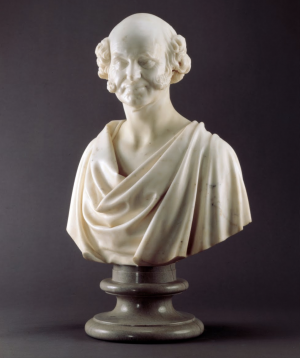
And yet, for Powers—who turned 40 in 1845, when The Greek Slave was first exhibited—it had been a long journey from his hometown of Cincinnati, Ohio. Born in Woodstock, Vermont, Powers’ family moved near Cincinnati when he was 14 years old. At the death of his father, Powers moved into the city and began work, first as a superintendent of a reading room attached to a hotel, and later as a clerk at a general store. His introduction to the art-making world was a humble one. At the age of 17 he worked as an apprentice to a wooden clockmaker. Several years later—in 1826—Powers began to study with Frederick Eckstein, a local sculptor of some regional renown. In his studio, Powers learned to model the human face and figure, and how to create plaster casts.
These skills were put to great use at Joseph Dorfeulle’s Western Museum. While there, Powers created animatronic wax figures to occupy scenes taken from Dante’s Inferno. At the same time, Powers began to create portrait busts of his friends. These likenesses brought him to the attention of Nicholas Longworth, a local wine entrepreneur. Longworth paid for Powers to undertake two extended periods of study away from Ohio: first to New York City (1829) and then later to Washington, D.C. (1834).
It was this later trip to the nation’s capital that propelled Powers onward to the success he would later find with The Greek Slave. While there, he sculpted many Washingtonian elites, including current and former presidents—Andrew Jackson (1834), John Quincy Adams (1837), and Martin van Buren (1837)—as well as John Marshall (1835), the second chief justice of the United States Supreme Court. These successes prompted Powers to follow the lead of another American neoclassical sculptor, Horatio Greenough, and depart his native shores for Italy. Greenough had already been in Italy since 1828; if Powers hoped to emulate the work of Michelangelo and Bernini, then Florence was just the place to do it.
An American Venus
And so, in 1837, Powers moved to Italy, never again to step upon American shores. Four years later, he was at work on The Greek Slave, the sculpture that has become his most recognized and celebrated work. Powers completed no less than six full-sized versions of this work between 1843 and 1866, and it secured his fame on both sides of the Atlantic Ocean. Indeed, had he made nothing else of note, this work alone would have vaulted Powers into the pantheon of American sculptors. The Greek Slave was both familiar and new, and exceedingly relevant for the audiences that first viewed it.
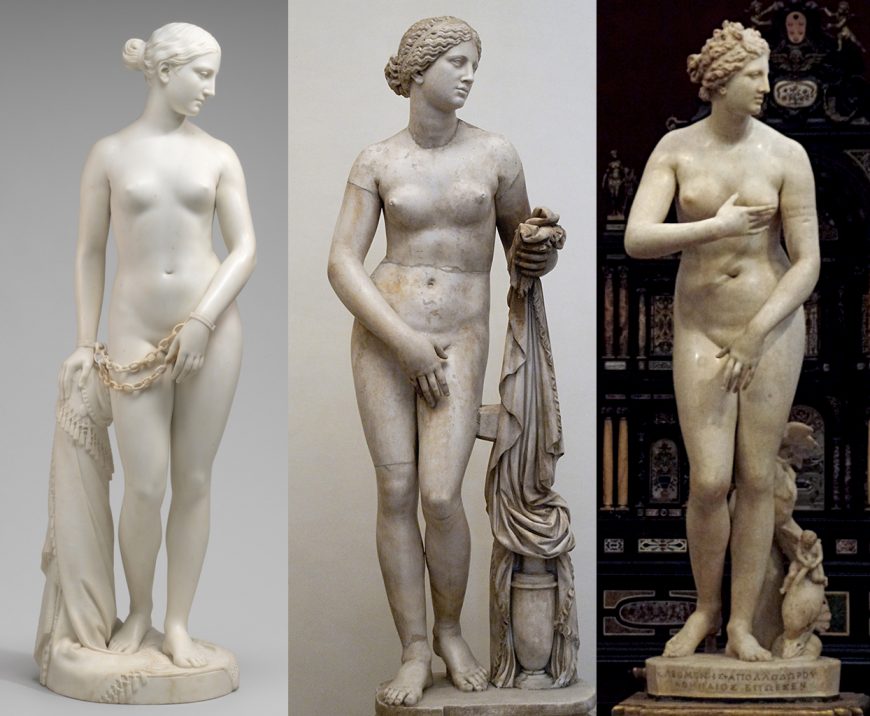
In it, Powers sculpted a nearly life-sized nude female. Posed in the High Classical contrapposto, the figure faces towards her left so that when her body is viewed frontally, her face appears in near-perfect profile. Her weight-bearing left leg counterbalances the straight right arm, which leads the eye downwards to the drapery-covered vertical support. In contrast, her bent left arm leads the eye across her unclothed body towards both her non-weight-bearing right leg and the chains that bind her two hands together. Indeed, much like the classical (ancient Greek and Roman) works that Powers based The Greek Slave on—Praxiteles’s Aphrodite of Knidos and the Medici Venus immediately come to mind—this gestural attempt to hide her nudity only forces the viewer to more directly address it.
The story of The Greek Slave
But who is this woman? Why is she nude? And what has caused her hands to be chained? In order to answer these questions—and, as importantly, justify Powers’s then scandalous use of female nudity—Powers himself wrote an explanatory text to accompany the exhibition of his work. In it, he explained that his figure is an enslaved Greek maiden who stands in a slave market during the time of the Greek War for Independence against Turkey (1821-32).
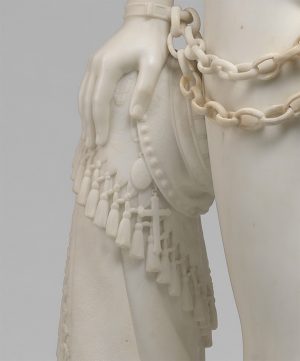
The Slave has been taken from one of the Greek Islands by the Turks, in the time of the Greek revolution….Her father and mother, and perhaps all her kindred, have been destroyed by her foes, and she alone preserved as a treasure too valuable to be thrown away. She is now among barbarian strangers…and she stands exposed to the gaze of the people she abhors, and awaits her fate with intense anxiety, tempered indeed by the support of her reliance upon the goodness of God. Gather all these afflictions together, and add to them the fortitude and resignation of a Christian, and no room will be left for shame.
Upon close inspection, one can see a small cross and locket carved on the support. The cross hints at her everlasting Christian faith, while the locket suggests far away love. Through these small details, Powers sets the stage for our reaction: a young Christian female has been abducted from her family, has been stripped bare by her captors, and now stands judged in the slave market. The pathos is palpable.
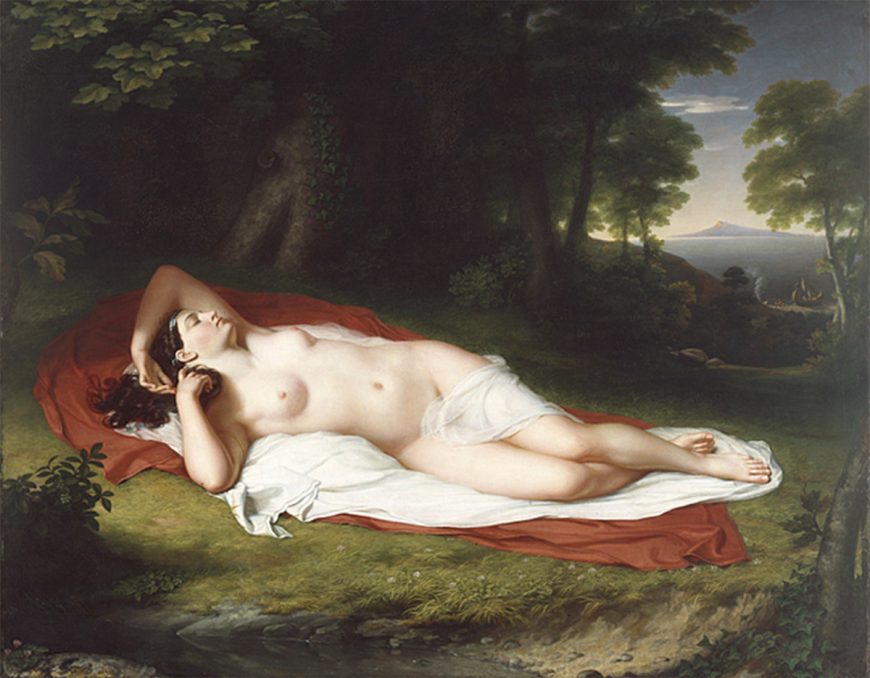
That The Greek Slave is nude—and that this nudity was deemed acceptable and appropriate to the audiences who viewed it—is very much a part of this work’s history. Nineteenth-century American art does not overflow with examples of the female nude, and those artists who attempted to paint or sculpt such scandalous subjects were often disappointed by reactions to their work. John Vanderlyn’s 1814 masterwork Ariadne Asleep on the Island of Naxos is one such example. Vanderlyn painted Ariadne in Paris and hoped for this work to announce—to a New York City audience—that he was eminently qualified to paint neoclassical history paintings. But whereas this painting was a hit when it was shown at the annual Paris salon, the (comparatively) prudish American audience responded negatively to Ariadne’s lack of clothing.
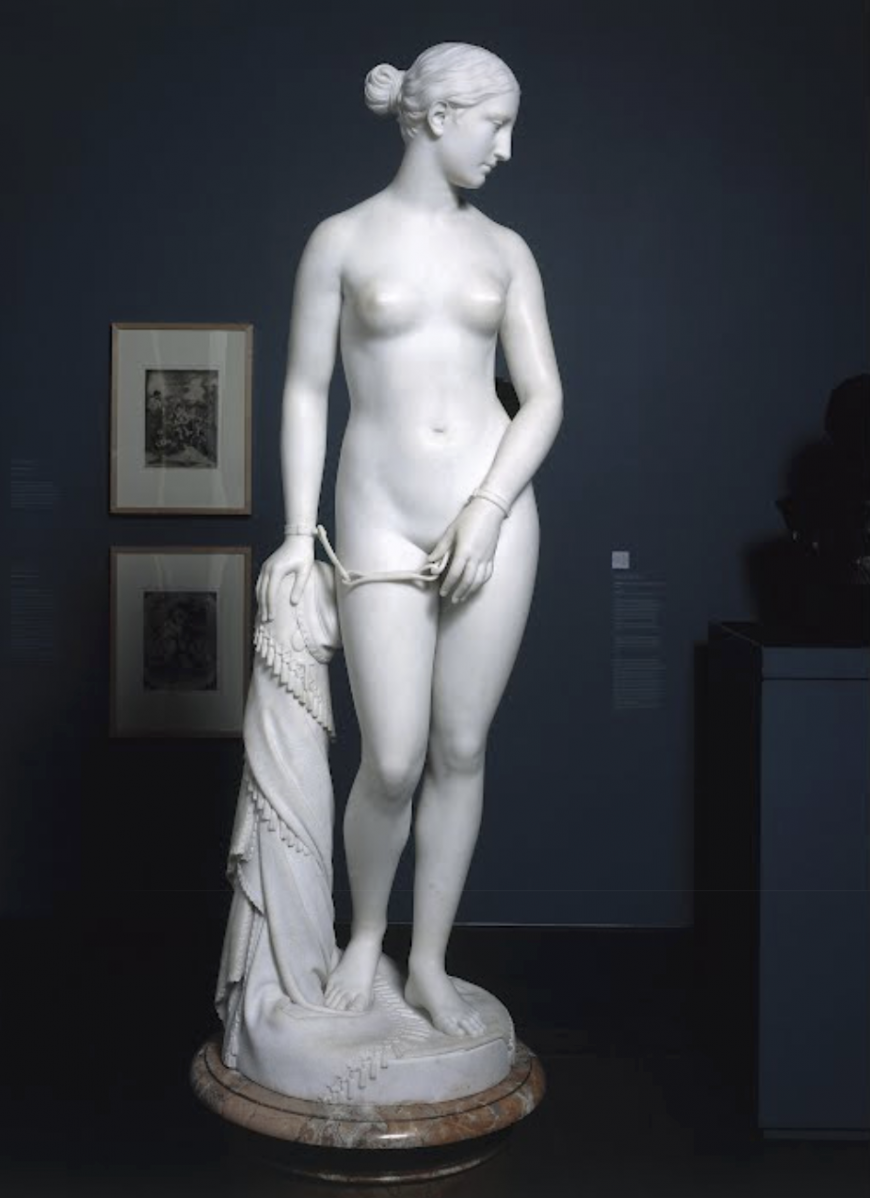
The Greek Slave is even more exposed than Ariadne in Vanderlyn’s painting (if we consider, for example, the drapery that comes across the top of her left thigh). So why was this sculpture so successful, when Vanderlyn’s painting had been rejected by American audiences? The Greek Slave is a generation or two later, but this difference in time—from 1814 until 1841—cannot be the only reason why one was accepted and other not.
Many believe the primary reason why The Greek Slave was so popular was because of the means by which the figure came to be nude. Her clothing was not removed because of an amorous tryst, like Ariadne’s. Although her clothing may have been stripped away, she remained cloaked and covered in her Christian piety. The Reverend Orville Dewey summed this up in an 1847 article in The Union Magazine:
“The Greek Slave is clothed all over with sentiment; sheltered, protected by it from every profane eye. Brocade, cloth of gold, could not be a more complete protection than the vesture of holiness in which she stands.”
The art-viewing public agreed, and the popularity of this work—a popularity that likely exceeded the work’s aesthetic merits—catapulted Powers to international fame. One of the contributors to the impact of this work was the way in which viewers could consider this both a historical and allegorical composition. In addition to being based upon an event taken from the Greek War of Independence, it was also topical to the situation of slavery in the United States.
A work admired around the globe
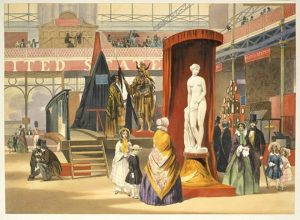
These were the connections viewers consistently made when the sculpture was first shown to great fanfare in London in 1845, and then when it toured the United States two years later. It made an appearance at the next two world’s fairs—London’s Crystal Palace in 1851 and the Exposition Universelle in Paris in 1855. At each stop, viewers made the connection between the statue and rising anti-slavery sentiment in the United States.
Beyond his six versions of The Greek Slave, Powers continued to contribute to the field of sculpture during the course of his long career. As an inventor, he patented new files and rasps, and developed an easier-to-use pointing machine that aided in the creation of marble copies of his works. He also developed a new finishing technique that allowed him to closely recreate the appearance of human flesh on the finely grained Carrara marble so preferred by Florentine sculptors. But it was The Greek Slave more than any other element that secured Powers’s reputation as an American sculptor of the highest rank and it remains one of the most important and enduring works of American sculpture.
Additional resources:
The Greek Slave at the National Gallery of Art, The Brooklyn Museum, Yale University Art Gallery, and the Smithsonian American Art Museum (the two other copies are held by Raby Castle, England, and Newark Museum, New Jersey)
Essay on Hiram Powers from The Metropolitan Museum of Art’s Heilbrunn Timeline of Art History
Smithsonian exhibition on the plaster cast of The Greek Slave
Replicating The Greek Slave from Smithsonian.com
Special issue on The Greek Slave from 19th-Century Art Worldwide
Smarthistory images for teaching and learning:


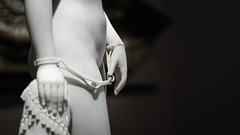



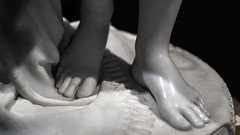
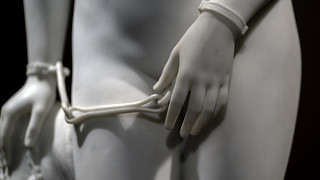
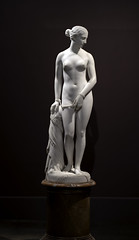
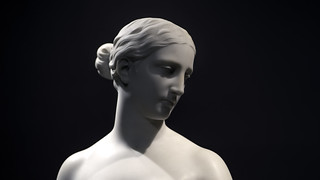
Seneca Village: the lost history of African Americans in New York
Video \(\PageIndex{32}\): A conversation between Dr. Diana Wall and Dr. Steven Zucker in Central Park about Seneca Village
If you are a descendant of a Seneca Village resident, or know someone who is, please contact the Seneca Village Project at: diana.diz.wall[at]gmail.com.
A Smarthistory ARCHES video
John Quincy Adams Ward, The Freedman
Video \(\PageIndex{33}\): A conversation with Erin Long, Lead Gallery Teacher, Amon Carter Museum of American Art and Beth Harris in front of John Quincy Adams Ward, The Freedman, 1863, bronze (Amon Carter Museum of American Art, Fort Worth, Texas)
Anna Pottery, Snake jug
Video \(\PageIndex{34}\): Anna Pottery, Snake Jug, c. 1865, stoneware with painted decoration, 31.75 x 21.11 x 22.07 cm (Minneapolis Institute of Art)
Additional resources:
Cultures and slavery in the American south: a Face Jug from Edgefield county
Video \(\PageIndex{35}\): A conversation with Sarah Alvarez, Director of School Programs, Art Institute of Chicago, Beth Harris, and Steven Zucker in front of a Face Jug from Edgefield county, South Carolina, c. 1860, stoneware and alkaline glaze, 13.3 cm high (The Art Institute of Chicago 2006.84) A Seeing America video
Smarthistory images for teaching and learning:
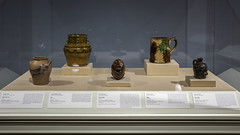



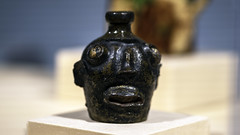
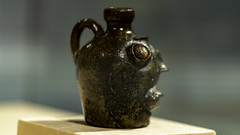
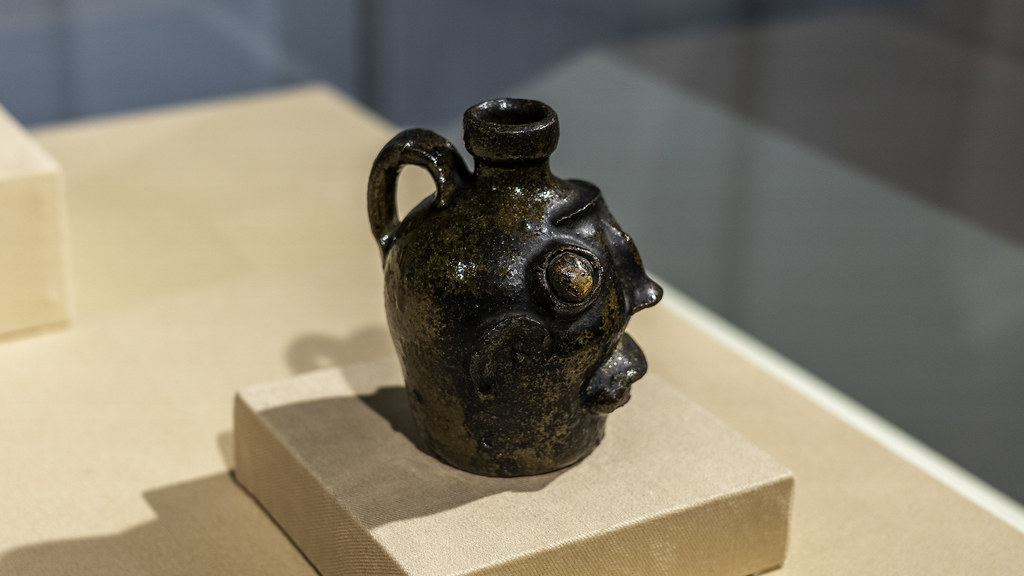
Carleton Watkins, Eagle Creek, Columbia River
Video \(\PageIndex{36}\): Carleton E. Watkins, Eagle Creek, Columbia River, 1867, albumen silver print, 40.01 × 52.39 cm (LACMA)
Business or pleasure? Carlton Watkins could photograph both beautifully.
William Howard (attributed), Writing desk
Figure \(\PageIndex{37}\): Writing desk, attributed to William Howard, c. 1870, yellow pine, tobacco box and cotton crate wood, 154.31 75.88 x 60.17 (Minneapolis Institute of Art)
Additional resources:
The light of democracy — examining the Statue of Liberty
Video \(\PageIndex{38}\): Statue of Liberty, New York Harbor, installed 1886, conceived by Édouard Laboulaye, sculpture designed by Frédéric Auguste Bartholdi, engineered by Gustave Eiffel, pedestal designed by Richard Morris Hunt. Speakers: Dr. Elizabeth Macaulay-Lewis and Dr. Steven Zucker
Additional resources:
Official website from the National Parks Service
Rediscovering An Ornate Cast Of Cast-Iron Buildings (New York Times)
Smarthistory images for teaching and learning:

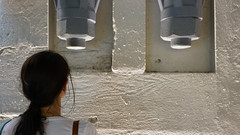

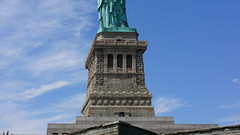

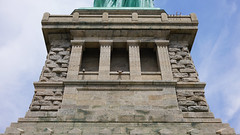
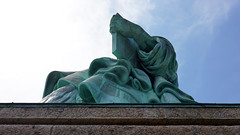
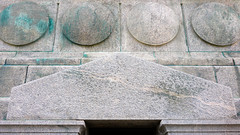

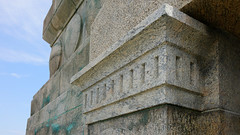
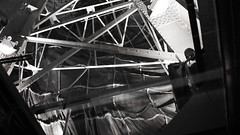
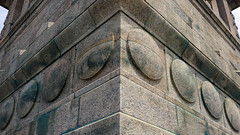
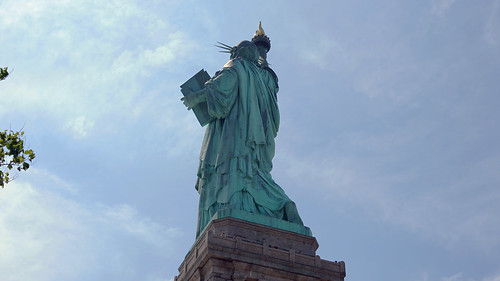
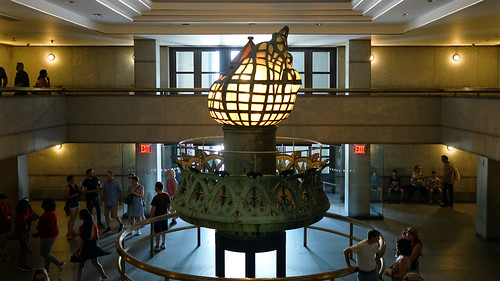
Olmsted and Vaux, Central Park

In the center of Manhattan Island lies a great expanse of sculpted nature. This large swath of greenery—Central Park—was the first great manifesto of a new urban vision that sought to introduce nature into the heart of commercial and industrial cities in the United States. As a measure of its tremendous success, the park quickly and enduringly became one of the most popular public attractions in New York City and an icon of a metropolis often famed more for its commercial power than for its art.
Nature and the city
A design of the magnitude and distinction of Central Park is necessarily the product of a fortuitous set of historical conditions. First, and broadly speaking, the park is an expression of the American fascination with the natural landscape that had defined the national character since colonial times. Although it was widely recognized that commercial cities had always been necessary, nineteenth-century American art, literature, politics, and popular culture all celebrated rural land as a central element of the nation’s “exceptionalism.” Henry David Thoreau, whose book Walden (1854) chronicled his retreat for self-renewal in rural Massachusetts, suggested every American city should be obliged to set aside land for a “primitive forest” in order to “preserve all the advantages of living in the country.”

The second crucial factor, by the middle of the nineteenth century, was the widespread awareness that industrial cities needed to be carefully planned. Reformers such as the poet and newspaper editor William Cullen Bryant and the travel writer, horticulturalist, and co-designer of Central Park, Frederick Law Olmsted embraced the urban future, but they wanted to better the lives of all city dwellers by introducing nature as an antidote to what they saw as the unsafe and unsanitary qualities of large cities. Of course, these reformers knew that true rustic nature was impossible in the middle of cities. Instead, they sought to cultivate a man-made, pastoral landscape that captured the best qualities of nature as filtered through human invention and design. Large parks were to be “the lungs of the city.” The reformers professed a Romantic conviction that being surrounded by nature assuaged the nerves and mind and helped “unbend” certain physical and psychological tensions.

Some reformers, though, expressed their views in a more paternalistic manner, showing disdain toward the poor and working classes. They argued that Central Park’s bucolic scenery should serve as a setting to refine the coarse, impolite manners thought to characterize especially the new, often impoverished immigrants then found in large cities like New York. Olmsted himself wrote that “a large part of the people of New York are ignorant” of a park’s social purpose and needed “to be trained in the proper use of it.” Olmsted’s original objective was to direct visitors to stroll through Central Park and quietly admire the natural scenery; they were not to partake, as they often do today, in strenuous exercise, large festivals or concerts, or any other behavior that would disturb the park’s bucolic ambience. Early on, he and his design partner Calvert Vaux issued regulations to achieve the desired behavior among park visitors: a polite sociability that might then filter out into behavior in the city itself.
The English landscape

These social concerns relied on the aesthetics of the natural landscape pioneered earlier in England. The “English landscape gardens” of the eighteenth century, as well as the early nineteenth-century suburban cemeteries of Paris, especially Père-Lachaise, strongly influenced landscape design in the United States. In the 1830s, for example, the Rural Cemetery Movement produced important landscape designs including Mount Auburn in Cambridge, Massachusetts, Green-Wood in Brooklyn (below), and Laurel Hill in Philadelphia. These suburban cemeteries were intended to provide a quiet retreat and confer physical and mental health benefits on visitors. They were designed according to the aesthetics of the English landscape garden (above), in which winding paths, open meadows, ponds, and occasional architectural “follies” created picturesque effects very different from the rigidly symmetrical or geometrical layouts of gardens in the Italian and French traditions, such as the Boboli Gardens in Florence or the royal gardens at Versailles.

Politics and Central Park
Political support was the third major factor in Central Park’s development. The land acquired for the park had been included in the city’s gridded urban plan of 1811, which was an early effort to take control of Manhattan Island’s development. The area was treeless, rocky terrain. On the west side it encompassed a small settlement that counted 264 residents in the 1855 census. About half of the modest houses in “Seneca Village,” as it was known, were owned by free African Americans, along with many German and Irish immigrants. There were at least two churches, cemeteries, and a school. City and state government used the legal power of eminent domain to claim the land as part of Central Park, forcibly evicting all the residents by 1857.

New York engineer Egbert Viele—who was responsible for the first, unbuilt plan for Central Park in 1856—described the land as a “pestilential spot” with “miasmatic odors” emanating from the untended ground. Unhealthy and unsightly, the land was ripe for reform as projections for Manhattan’s future growth pushed the boundary of built-up land further and further north. Reformers and politicians also soon realized that the 1811 plan had not sufficiently taken account of the need for recreational and other types of open space. Even the few parks provided by that plan had mostly been built over in the intervening decades as real estate interests trumped the public good.
In 1853, after more than a decade of agitation by Bryant, landscape architect Andrew Jackson Downing, and others, the state of New York authorized the creation of a large park in Manhattan, originally to be built and designed by Viele. However, his design was considered perfunctory, offering little in the way of artistry or ingenuity. The Central Park Commissioners, as the governmental body was known, appointed Frederick Law Olmsted as superintendent of works and called for an open competition for a new design.
Olmsted was not a designer or engineer. He had been a farmer and horticultural enthusiast on Staten Island for several years before traveling in northern Europe, Mexico, and elsewhere. His travels inspired him to take up writing and, later, magazine publishing. Calvert Vaux approached Olmsted about jointly submitting a design to the park competition. Vaux, an English architect, had earlier worked in partnership with Downing and eagerly took up the latter’s Romantic ideas about landscape. His partnership with Olmsted resulted in a pairing of like-minded, strong-willed individuals determined to mold the park to their shared vision.

The plan
Olmsted and Vaux won the design competition with their “Greensward Plan,” the last of thirty-two to be submitted. Two elements distinguished the Greensward design from those of their competitors. One was the sheer allure of their landscape features, conveyed in twelve before-and-after panels included in their submission. The other was the ingenious separation of pedestrian and cross-park carriage (now vehicular) traffic.

The competition brief had insisted that four roadways should connect the east and west sides of Manhattan through the park. All other submissions put those roads on the ground surface, effectively dividing the park into five zones separated by street traffic. However, Olmsted and Vaux submerged their “transverse” roads below ground level and created a continuous expanse of park differentiated by designed topography. As they discovered during construction, this critical invention gave them the chance to increase the park’s picturesque scenery since the many drives and walking paths that cross over the transverses and bridal paths could be embellished by attractive bridges.

From south to north, the park is laid out to create distinct visual experiences, helping the visitor navigate the vast space and creating picturesque variety in strong contrast to the rectilinearity of the gridded city around it. South of the reservoirs—there were originally three but today only the largest irregular one remains as a lake—the park is a series of pastoral areas, including the large glade called the Parade Ground (now the Sheep Meadow) surrounded by copses or small groves of trees (above).

In the southern end of the park, we find one area that departs from the naturalism: the long, tree- and bench-lined Promenade now know as the Mall (above) which leads to the Terrace and Bethesda Fountain (below).


The Terrace is divided into upper and lower sections, a remarkably classical environment with wide, symmetrical stairs and a sense of formality. Jacob Wrey Mould, an English architect who worked on the park for Olmsted and Vaux until 1874, designed its ornament. A surprising and elegant space, the Terrace is a delightful foil to the landscape around it. At its center is the much-photographed fountain surmounted by sculptor Emma Stubbins’ Angel of the Waters, installed in 1873 (left). Between the Terrace steps is the Arcade, a long subterranean space with a stunning ceiling decorated with tiles designed by Mould and manufactured by the Minton Tile Works in England. The formal but festive appearance of the Terrace is appropriate for a space conceived as the city’s “open air hall of reception.”
North of the Lake is the Ramble, a series of small, twisting paths along rocky outcroppings of the local stone, called schist, that can be seen throughout the park. At the northernmost edge of the park is the most rugged landscape with the densest foliage, then and now the park’s least visited section. But the area offers some of the park’s most stunning features, including the Ravine with its small brook, waterfalls, and tomb-like Glen Span Arch, made from massive, rough-faced stones. The quiet of the area is an almost haunting experience; it feels much more secluded than its actual distance from the busy surrounding streets would suggest.

The park’s influence
Central Park was very much a product of its particular moment in time, a combination of aesthetic ideas, urban concerns, and political will that coalesced in the decade before the Civil War. Its instant success led to other opportunities for Olmsted and Vaux to apply their approach to landscape design: a few of the important projects were Prospect Park in Brooklyn (1866-73), the Buffalo park system (begun 1868), and the suburb of Riverside, Illinois (1868).
Later, working apart from Vaux, Olmsted had a flourishing practice: he designed the campus of Stanford University (1889), the Druid Hills district in Atlanta (1892), and the grounds of the World’s Columbian Exposition in Chicago (1893)—just three among many projects. The landscape philosophy developed by Olmsted and Vaux and first expressed at Central Park had lasting influence, inspiring, for instance, Jens Jensen’s “prairie landscapes” in Chicago and elsewhere in the early twentieth century. It was arguably no exaggeration when Harper’s Magazine declared in 1862 that Central Park was “the finest work of art ever executed in this country.” It may still be.
Essay by Paul A. Ranogajec
Additional resources:
Morrison H. Heckscher, Creating Central Park (New York: Metropolitan Museum of Art, 2008).
Francis R. Kowsky, Country, Park & City: The Architecture and Life of Calvert Vaux (New York: Oxford University Press, 2003).
Roy Rosenzweig and Elizabeth Blackmar, The Park and the People: A History of Central Park (Ithaca, NY: Cornell University Press, 1992).
David Schuyler, The New Urban Landscape: The Redefinition of City Form in Nineteenth-Century America (Baltimore: Johns Hopkins University Press, 1986).
Robert Twombly, ed. Frederick Law Olmsted: Essential Texts (New York: W. W. Norton, 2010).
Carrère & Hastings, The New York Public Library

Today, the massive New York Public Library lies amidst the bustle of some of the busiest streets in the city. Along 42nd Street to the west is Times Square, a tourist mecca filled with throngs of visitors at all hours. A few blocks to the east is Grand Central Terminal, one of the city’s gateways, and certainly the most elegant, built in a grandiose Beaux-Arts style almost simultaneously with the library. When construction on the library started in 1899, this area of the city had long been built up, but Fifth Avenue north of 42nd Street was still a mostly residential enclave, filled with the mansions of the newly-rich industrialists and bankers of recent generations. The tall skyscrapers that today hem in the library and the adjacent Bryant Park make the juxtaposition between the library’s insistent horizontality and its towering neighbors startling. Yet the staggering difference in scale may only serve to heighten the observant visitor’s appreciation for the consummate handling of details inside the library and out.

A new library for a major city
Officially, the name of the library is The New York Public Library, Astor, Lenox and Tilden Foundations. The long name resulted from a merger in 1895 between two earlier private libraries in New York, the Astor (below) and the Lenox, as well as the Samuel J. Tilden Trust, created specifically to fund a public library in New York as a major part of the former governor’s philanthropic legacy. New York City (consisting only of Manhattan until 1898) grew dramatically in the nineteenth century. In 1800, the city had a population of about 60,000; in 1890, more than 1.5 million. As a result, civic leaders and philanthropists felt that new cultural and social institutions were needed in order to provide the modern services expected of a major city, especially one with so diverse a population. Further, the two earlier libraries that joined the Tilden Trust were small and too peripherally-located to serve the needs of the new library.

Beginning in 1901, the main building of the New York Public Library became the center of a larger network of public libraries being built throughout the city to better reach citizens in each of its neighborhoods. Andrew Carnegie provided the funds to build the first round of these libraries, 39 in total, with the understanding that the New York Public Library would cover their future operations and maintenance. Carrère & Hastings’ building on Fifth Avenue would be the administrative and symbolic center of this network.
Planning the library

An intensive public debate surrounded the selection of the best location for the new library. Within two years, the site of the old Croton Distributing Reservoir (above), slightly to the north of the city’s center at the time, had been chosen and, under the direction of the library’s first president John Bigelow, a competition held to select the architect. Prior to the competition, in 1892, Bigelow and architect Ernest Flagg anticipated the library’s formation and published ideal plans for the library in Scribner’s Magazine. Flagg’s drawings showed the library on the site of the reservoir, which had provided the city’s water since the 1840s, but which was obsolete already in the 1880s. Although the library as built by Carrère & Hastings would be very different, Flagg’s design set the parameters for a large Beaux-Arts-style building that would have a clear identity as a leading civic monument.

Among the designers invited to submit plans to a closed phase of the design competition, the favorites were McKim, Mead & White, a well-established firm that had trained both John Carrère and Thomas Hastings in the early 1880s. McKim, Mead & White had recently completed the Boston Public Library, a celebrated design that for the first time made the public library a commanding monument within an American city and that provided the most direct model for New York’s library.

Carrère & Hastings, however, won the competition, having submitted a design that was deemed practical and monumental, functional and beautiful. Their entry prevailed over other senior architects of the day, including George B. Post, Cyrus Eidlitz, and Peabody and Stearns. Carrère & Hastings’ design closely followed the competition brief, which had been drafted by the first director of the new institution, John Shaw Billings. His guidelines provided specific dimensions and set a demanding parti. In the French Beaux-Arts terminology that would have been familiar to architects at the time, parti refers to a schematic floor plan that represents a building’s primary functions as a series of figural spaces and sets the parameters for the whole design. In Billings’ guidelines, the library was to be a three-story building organized around a central circulation core—grand entry hall and stairs—with two courtyards and a large reading room on the third floor.

The location
The Croton Reservoir site was unusual in one important respect: it was a double block stretching between 40th and 42nd Streets with a large park on its western half. This small but very noticeable rift within the gridiron plan of Manhattan gave the library the great privilege of having a long frontage on Fifth Avenue with a park directly adjacent to it. This urban condition would have set apart any building at that location, but the architects took advantage of the rare opportunity afforded by the site to design a library that would make it a particularly visible landmark in the cityscape. As the architecture critic (and Progressive political theorist) Herbert Croly wrote in his review of the nearly-completed building in 1910, it was “essentially and frankly an instance of street architecture.”

By this, he meant that the architects had understood the importance of the broad street frontage along Fifth Avenue (above) and had adeptly configured the building to add to the variety and dignity of the streetscape. He perceptively described how the exterior “issues to the people an invitation to enter rather than a command.” It was, he said, an “ingratiating rather than imposing” building. On the side facing Bryant Park (below), below the round-arched windows of the reading room, the architects introduced tall, narrow rows of windows that articulate the seven levels of structural steel and cast-iron book stacks directly behind. The striping effect of the dark windows alternating with the white Vermont marble of the wall gives the park face of the library a strikingly modern look. Croly had a lukewarm reaction to the park façade, but other critics then and since have greatly admired the design, especially the strong contrast it provides to the more conventionally Beaux-Arts Fifth Avenue front.

Design elements inside and out
One of the key means by which Carrère & Hastings took advantage of the double-block site was the terrace upon which they lifted up their building from street level. The terrace not only elevates the library, symbolically exalting the public that would use it, but also helps orchestrate a carefully calibrated sequence of movements into and through the building, starting with the approach from the street. As the visitor moves up the wide, inviting stairs of the terrace on Fifth Avenue, the main façade of the library expands horizontally and completely dominates the field of vision. Carrère & Hastings designed this long façade according to the five-part French palace type (central entry or frontispiece, recessed wings, and end pavilions). The central portico (a porch supported by columns) composed of three large, arched openings with a tall sculpted attic (wall) above recalls an ancient Roman triumphal arch, a symbolic reference suggesting a ceremonial welcome into the library.

Once inside, the modest but exquisitely-detailed lobby splits into two stairs, which take the visitor to the functional rooms of the second floor and then further to the spacious and stately reading room on the third floor. There, the visit culminates in this surprisingly large space, split in two by the book delivery pavilion. The richly decorative Renaissance-style ceiling, with coffered (sunken) panels and luminous murals of a colorfully cloudy sky, and with the bright natural light provided by the massively-scaled windows create an atmosphere of airy and serene openness that feels far from the bustle of the world outside, an atmosphere eminently conducive to serious study and writing.

This sequence of spaces, so clear that no guide map is needed by the visitor, is abundantly decorated with murals and sculpture, beginning most famously with the lions reclining atop the steps outside. Designed by Edward Clark Potter, the placid but attentive lions were nicknamed Patience and Fortitude (above) by former New York mayor Fiorello La Guardia during the Great Depression. Also among the outside sculptures are the allegorical fountains by Frederick MacMonnies, embedded in the walls adjacent to the portico: Truth (above) to the right and Beauty to the left. Above the latter is an inscription from a poem by John Greenleaf Whittier that begins, “Beauty old yet ever new,” which could be taken as the motto governing the aesthetic sensibility of the architects and artists who created the library. Inside, the numerous decorations include the large murals, not begun until 1938, by Edward Laning in the McGraw Rotunda on the third floor. Depicting the Story of the Recorded Word, they illustrate crucial periods of development in the history of books and printing. The ceiling is covered by the vast Prometheus Bringing the Gift of Fire, the mythological spark to human invention and knowledge, an appropriate symbolic reference to the library’s role in bringing all the world’s knowledge within reach of the city’s residents. Many more decorative features embellish nearly every corner of the interior public spaces.

Beaux-Arts style
As good Beaux-Arts architects, Carrère & Hastings knew how to create grandeur and drama in a building by directing movement and creating sight-lines. This ability was one of the strengths that the Beaux-Arts method of design cultivated in architects. The method also prized the study of ancient and Renaissance classical architecture. Originating at the École des Beaux-Arts in Paris, France, Beaux-Arts architecture was prevalent in the United States from the 1880s until World War II.

No city in the country has a greater concentration of Beaux-Arts-style buildings than New York, primarily due to the fact that many of the architects based in the city at the turn of the twentieth century, including Carrère and Hastings, had gone to Paris in order to gain a cosmopolitan education at the École. Many resident architects in New York shared the feeling that its architecture needed to reflect its new status as a major world city on par with Paris and London. The Parisian École welcomed foreigners, and its rigorous design method provided American architects with a set of skills and aesthetic ideas that helped make their practice more competent and professional. The school’s reliance on historical forms chiefly drawn from the classical tradition in Italy and France enhanced the trend toward eclecticism in nineteenth-century architecture, which many critics have found problematic. However, its rigorous design methods and attention to spatial planning contributed, as in Carrère & Hastings’ library, to a sense of modernity in productive dialogue with the past. Insofar as the New York Public Library is seen as a product of the École, it should be considered one of its most distinguished successes in the United States.
A special space in the city

For a large part of the twentieth century, Beaux-Arts architecture was held in low esteem by many architects, critics, and even historians. Yet the New York Public Library’s main building has always elicited a degree of reverence among its users—academics and other researchers, novelists and playwrights, cultural leaders and everyday citizens—who all seem to find things of special and enduring value in the building. Among these special things are, of course, its bountiful treasures: the books and documents that constitute its reason for being. But it also provides, by means of its beautiful halls, gracious and welcoming steps, and ambiance attuned to scholarly pursuits, a temporary refuge from the harshness of the world that great libraries, large and small, have always provided. Carrère & Hastings’ architectural dressing for the library has seemed to all these people, and even to the harshest critics today, to be an appropriate and enduring sign of the institution’s signal importance to the intellectual and cultural life of a world metropolis.
Additional resources:
The website of The New York Public Library
Phyllis Dain, The New York Public Library: A History of Its Founding and Early Years (New York: New York Public Library, 1972).
A.C. David (Herbert Croly), “The New York Public Library,” Architectural Record, September 1910, pp. 144-72.
Mark Alan Hewitt, Kate Lemos, et al. Carrère & Hastings, Architects. 2 vols. (New York: Acanthus Press, 2006).
Paul Andrija Ranogajec, “Apotheosis of the Public Realm: Civic Classicism in New York City’s Architecture.” Ph.D. dissertation, City University of New York, 2014.
Henry Hope Reed and Francis Morrone. The New York Public Library: The Architecture and Decoration of the Stephen A. Schwarzman Building (New York: W. W. Norton, 2011).
William R. Taylor and Thomas Bender, “Culture and Architecture: Some Aesthetic Tensions in the Shaping of New York,” In In Pursuit of Gotham: Culture and Commerce in New York (New York: Oxford University Press, 1992), pp. 51-67.
Timothy O’Sullivan, Ancient Ruins in the Cañon de Chelle

The impressive natural landscape of Timothy O’Sullivan’s photograph Ancient Ruins in the Cañon de Chelle, 1873, immediately commands attention. The yawning black hole in the center is emphasized by the dramatic striations in the rocks, the black and white contrast of the photograph making the layers of sediment far more obvious than they would be in reality. In fact, the drama of the surrounding landscape makes it possible to almost overlook the ancient ruins at the mouth of a black cave.
Borrowing from landscape painting
Although clearly a documentary image of the scene, the photograph also employs many of the artistic conventions of landscape painting. The narrowly focused composition does not allow the viewer’s eye to wander through the landscape. In fact, our vision is confined solely to the rock and the ruins, without the standard light source found in most landscape painting. However, light plays an obvious role in the play of light and dark on the rock walls. The ruins themselves, which suggest the passage of time, are so small as to emphasize the traditional Romantic interest in man’s insignificance when confronted with the immensity of nature.

The realities of war
Timothy O’Sullivan began his photographic career as an apprentice in the studio of Mathew Brady. At the start of the Civil War, he became part of Brady’s team assigned to document the conflict, although O’Sullivan resigned after an argument with Brady over who was to receive credit for authorship of his photos. Many of O’Sullivan’s war images have a haunting quality, for example, A Harvest of Death (1863), which captures a misty landscape in Gettysburg, Pennsylvania littered with corpses. At a time when standard war images consisted of portraits of soldiers in uniform and camp life, O’Sullivan’s photograph is a stark reminder of the realities of the conflict.
Geological expeditions
During the late 1860s and 1870s O’Sullivan traveled west several times photographing as part of various geological survey teams. The difficulties of these trips must have been huge, carrying men and equipment through the wilderness in wagons and small boats. O’Sullivan himself nearly drowned on an early expedition when he was thrown from a boat and carried down stream by rapids before finally making his way to shore. Managing his personal equipment must have also been a challenge. Photographs at the time were exposed on large glass plates, and understandably, many of O’Sullivan’s images simply didn’t make it home.
In 1873 O’Sullivan himself led a group to explore the rock formations and long abandoned archaeological remains found in Arizona around the Canyon de Chelly. The ancient pueblos in the photograph were built by the Anasazi or Navajo for “ancient ones.” Although O’Sullivan was one of the first to capture this impressive scene, many others have followed in his footsteps, including the legendary twentieth-century landscape photographer Ansel Adams. The Canyon de Chelly became a National Monument in 1931 and is today jointly managed by the National Park Service and the Navajo Nation.
Jacob Riis, “Knee-Pants” at Forty-Five Cents a Dozen—A Ludlow Street Sweater’s Shop, from How the Other Half Lives
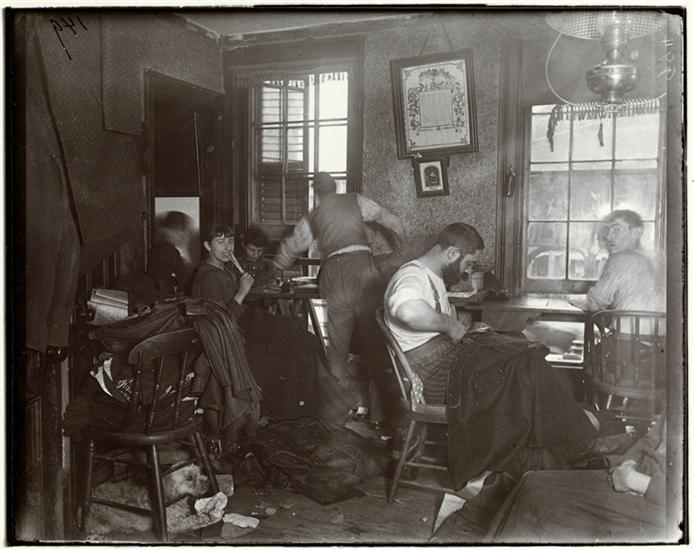
The slums of New York
Jacob Riis documented the slums of New York, what he deemed the world of the “other half,” teeming with immigrants, disease, and abuse. A police reporter and social reformer, Riis became intimately familiar with the perils of tenement living and sought to draw attention to the horrendous conditions. Between 1888 and 1892, he photographed the streets, people, and tenement apartments he encountered, using the vivid black and white slides to accompany his lectures and influential text, How the Other Half Lives, published in 1890 by Scribner’s. His powerful images brought public attention to urban conditions, helping to propel a national debate over what American working and living conditions should be.

A Danish immigrant, Riis arrived in America in 1870 at the age of 21, heartbroken from the rejection of his marriage proposal to Elisabeth Gjørtz. Riis initially struggled to get by, working as a carpenter and at various odd jobs before gaining a footing in journalism. In 1877 he became a police reporter for The New York Tribune, assigned to the beat of New York City’s Lower East Side. Riis believed his personal struggle as an immigrant who “reached New York with just one cent in my pocket”¹ shaped his involvement in reform efforts to alleviate the suffering he witnessed.
As a police reporter, Riis had unique access to the city’s slums. In the evenings, he would accompany law enforcement and members of the health department on raids of the tenements, witnessing the atrocities people suffered firsthand. Riis tried to convey the horrors to readers, but struggled to articulate the enormity of the problems through his writings. Impressed by the newly invented flash photography technique he read about, Riis began to experiment with the medium in 1888, believing that pictures would have the power to expose the tenement-house problem in a way that his textual reporting could not do alone. Indeed, the images he captured would shock the conscience of Americans.

Midnight rounds
At first Riis engaged the services of a photographer who would accompany him as he made his midnight rounds with the police, but ultimately dissatisfied with this arrangement, Riis purchased a box camera and learned to use it. The flash technique used a combination of explosives to achieve the light necessary to take pictures in the dark. The process was new and messy and Riis made adjustments as he went. First, he or his assistants would position the camera on a tripod and then they would ignite the mixture of magnesium flash-powder above the camera lens, causing an explosive noise, great smoke, and a blinding flash of light. Initially, Riis used a revolver to shoot cartridges containing the explosive magnesium flash-powder, but he soon discovered that showing up waving pistols set the wrong tone and substituted a frying pan for the gun, flashing the light on that instead. The process certainly terrified those in the vicinity and also proved dangerous. Riis reported setting two fires in places he visited and nearly blinding himself on one occasion.
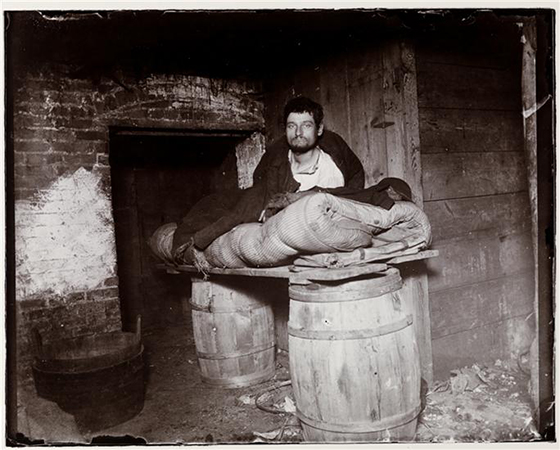
Home and work
While it is unclear if Riis’ pictures were totally candid or posed, his agenda of using the stark images to persuade the middle and upper classes that reform was needed is well documented. A major theme of Riis’ images was the terrible conditions immigrants lived in. In the 1890s, tenement apartments served as both homes and as garment factories. “Knee-Pants at Forty-Five Cents a Dozen—A Ludlow Street Sweater’s Shop” depicts the intersection of home and work life that was typical. Note the number of people crowded together making knickers and consider their ages, gender, and role. Each worker would be paid by the piece produced and each had his/her own particular role to fill in the shop which was also a family’s home.

While Riis did not record the names of the people he photographed, he organized his book into ethnic sections, categorizing the images according to the racial and ethnic stereotypes of his age. In this regard, Riis has been criticized for both his bias and reducing those photographed to nameless victims. “Knee-Pants,” appears in the chapter Jewtown and one can assume that the individuals are part of the large wave of Eastern European Jewish migration that flooded New York at the turn of the twentieth century.

They are likely conversing in Yiddish and share some type of familial or neighborly connection. Some of the workers depicted might have lived in a neighboring New York City apartment or next door back in the old country. Home life, family relations and business relations, are intertwined. Just as it is impossible to know the names of the people captured in Riis’ image, and what Riis actually thought of them, one also cannot know their own impressions of the workplace, or their hopes and day-to-day challenges.

The work performed in tenements like these throughout the Lower East Side made New York City the largest producer of clothing in the United States. Under the contracting system, the tenement shop would be responsible for assembling the garments, which made up the bulk of the work. By 1910, New York produced 70% of women’s clothing and 40% of men’s ready-made clothing. That meant that the knee-pants and garments made by the workers captured in this Ludlow Street sweatshop were shipped across the nation. Riis’ photographs helped make the sweatshop a subject of a national debate and the center of a struggle between workers, owners, consumers, politicians, and social reformers.
The Progressive Era
Riis’ photographs are part of a larger reform effort undertaken during the Progressive Era, that sought to address the problems of rapid industrialization and urbanization. Progressives worked under the premise that if one studies and documents a problem and proposes and tests solutions, difficulties can ultimately be solved, improving the welfare of society as a whole. Progressives like Riis, Lewis Hine, and Jessie Tarbox Beals pioneered the tradition of documentary photography, using the tool to record and publicize working and housing conditions and a renewed call for reform. These efforts ultimately led to government regulation and the passage of the 1901 Tenement House Law, which mandated new construction and sanitation regulations that improved the access to air, light, and water in all tenement buildings.
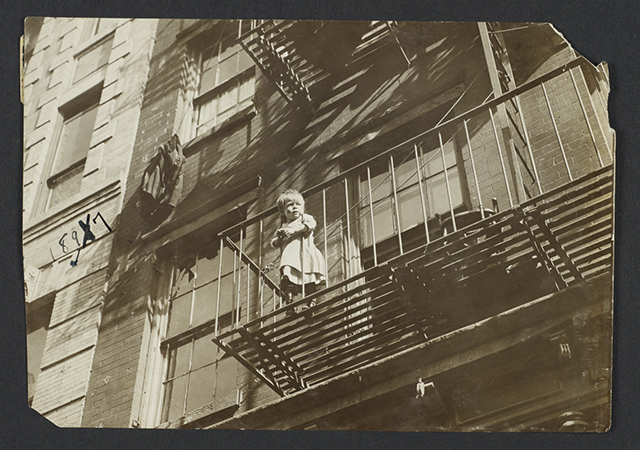
In the introduction to the How the Other Half Lives, Riis challenged his readers to confront societal ills, asking “What are you going to do about it? is the question of to-day.” It was a question of the past, but one that endures.
1. Jacob Riis, The Making of An American, 2: 18
Additional resources:
Jacob A. Riis Photographic collection, The Museum of the City of New York
Ginia Bellafante, Discussion on How the Other Half Lives, The New York Times
Texts by Jacob Riis online bartleby.com
“Jacob Riis and the Other Half” website by Lisa Xie
Bonnie Yochelson and Daniel Czitrom, Rediscovering Jacob Riis: Exposure Journalism and Photography in Turn-of-the-Century New York ( Chicago University Press, 2014).
Herter Brothers, Mark Hopkins House Side Chair
Video \(\PageIndex{39}\): Mark Hopkins House Side Chair, c. 1878-80, designed and made by Herter Brothers (New York), rosewood, inlaid and veneered with various woods, silk (of the period, but not original) (Cooper Hewitt, Smithsonian Design Museum, New York City)
This video was produced in cooperation with the Cooper Hewitt, Smithsonian Design Museum.
Smarthistory images for teaching and learning:
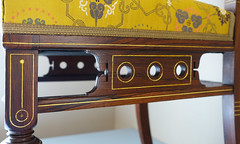
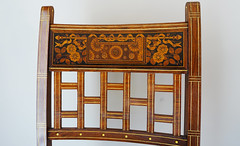

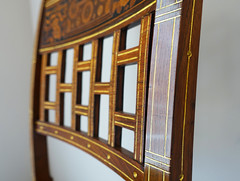
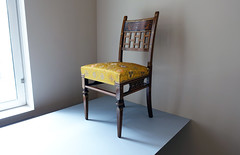
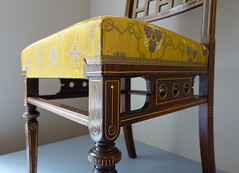
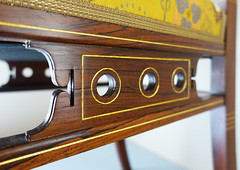

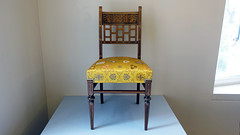

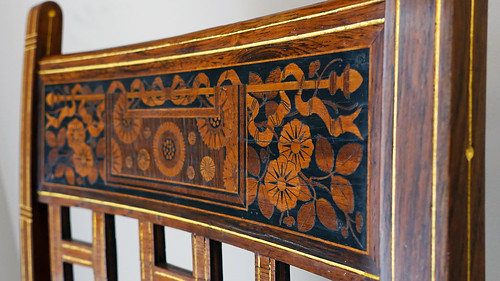
Robert Mills and Lieutenant Colonel Thomas Lincoln Casey, Washington Monument

Evolving American narratives

At 555 feet high the Washington Monument towers over the National Mall. In a city of height-restricted buildings, this enormous, mottled-marble obelisk can be seen piercing the sky from miles around like a beacon to the country’s symbolic center. Once there, the observation deck at the top of the monument provides visitors with a breathtaking bird’s eye view of the city – from the World War II Memorial, past the Lincoln Memorial and over Arlington Bridge to the west, down the museum-lined Mall to the Capitol Building to the east, over the Ellipse and past the White House to the north, and beyond the Tidal Basin and the Jefferson Memorial into Virginia to the south. Built to honor the country’s first president, the Washington Monument is the linchpin of an evolving American narrative told through the buildings and monuments that surround it.
L’Enfant’s proposal
Pierre Charles L’Enfant, the architect and city planner responsible for the design of Washington D.C. and the National Mall, was the first to propose a monument to Washington. Inspired by the city planning in his native France, L’Enfant suggested placing an equestrian statue of George Washington as commander of the Continental Army in the middle of the National Mall. It was to be set on the spot where the sight lines from the White House and the Capitol intersected so that future presidents and members of Congress would always have Washington in view and on their minds as they deliberated on what was best for the country. Funding fell short for L’Enfants’ grand scheme, however, and his sculpture was never completed.
Mills’ proposal

Fifty-four years later, Federal architect Robert Mills put forward plans to celebrate Washington with a 600 foot tall Egyptian-style obelisk surrounded by a vast colonnade decorated with sculptural elements recalling ancient Egypt, Greece and Rome. Unlike a true Egyptian obelisk which was carved from a single block of stone, the one Mills proposed would be made of many marble blocks some carved with portraits of the first president in action. Its grandeur would serve to equate George Washington with the greatest leaders of antiquity.
With a modest amount of private funding in hand, Mills began work on the obelisk thinking he would be able to raise the rest. However, the venture did not go as planned. By 1851, the marble shaft of the obelisk was only one-quarter complete. It stuck up like a great stump and became a symbol for the government’s poor planning and mismanagement of the Mall.

Money problems
The Monument’s Board of Managers lobbied Congress for money but was soon overthrown by a group of anti-immigration, anti-Catholic activists called the “Know-Nothings”. The Know-Nothings wanted to use the monument to promote their “America for Americans” agenda by having the monument paid for and built by those who supported their cause. However, the oncoming Civil War drained interest from the project and the Washington Monument remained stump-like for more than a quarter century. Then, in 1878, Congress appointed Lieutenant Colonel Thomas Lincoln Casey, an army engineer, to complete the project.

Colonel Casey
Colonel Casey jumped into the project by significantly altering Mills’ plans. Right away he simplified the design of the obelisk, stripping the structure of extraneous decoration, and creating a narrower, higher, peak at the top. Using a white marble that was a better quality, but not an exact match of the first stone used, Casey completed the monument. And while Congress gave Casey money incrementally and tried to intercede in the design process, they failed to get the Colonel to alter his vision of a façade free of any and all ornamentation. In 1884, over widespread objections about its lack of descriptive, narrative and historical elements, Casey completed the memorial.
In the end, it had taken more than three dozen years for the Washington Monument to be completed. Soil stability issues forced its move some 400 feet from the exact intersection point for the Capitol and White House. Funding shortages, politics and the intrusion of the Civil War delayed its completion.
But what does it actually tell us about Washington? Unlike the other monuments on the Mall, the Washington Monument says next to nothing about the subject for whom it was created. In contrast, one can learn a lot about Lincoln from visiting the Lincoln Memorial, viewing his sculptural likeness and reading his words inscribed on the walls. And a person can learn a lot about World War II by visiting that Memorial and studying the reliefs, inscriptions, sculptures and other symbolic features. But one cannot learn anything about the way Washington looked or his words or deeds by visiting the Washington Monument. And that is a result of the long and contentious process from which the Monument to America’s first president arose.

The Washington Monument receives an estimated 4 million visitors a year. It was the tallest building in the world until the completion of the Eiffel Tower in 1889, and remains the tallest stone building in the world today.
Additional resources:
NYPL Digital Gallery of early photographs of the Washington Monument
Shrady and Casey, Ulysses S. Grant Memorial

Location, location, location
The dramatic and action-packed monument to Ulysses S. Grant in front of the U.S. Capitol Building, at once grand and intimate, speaks to both the valor and the horror of the Civil war. Henry Merwin Shrady’s massive tripartite memorial features a bronze equestrian statue of Grant on a central pedestal flanked by two sculptural groups of soldiers.
Sited on top of a grand terrace 252 feet wide and 71 feet long, the memorial stands in front of a large reflecting pool built to complement the water feature in front of the Lincoln Memorial at the opposite end of the Mall.

Grant, at the apex of the central column, calmly attends to the war around him. Silent, certain and yet not traditionally heroic, the figure appears weary, but determined, his uniform unadorned, his presence unassuming.

On Grant’s right is the seven men Cavalry Charge. Their commanding officer raises his sword and urges his men into battle. The horses leap into action as the bugler prepares to sound the charge. Yet this powerful and inspiring moment has already turned tragic. One of the horses has fallen and trapped his rider beneath. He is about to be trampled by the cavalryman behind who shields his eyes in horror. Shrady made himself the model for the fallen soldier by working from his reflection in a mirror, which proved prophetically poignant as Schrady gave his life to the monument’s completion.

To the left of Grant is the equally dramatic portrayal Artillery. Three horses and five men bring forward a cannon but the bridal of the lead horse has broken. While the other two horses attempt to stop, the third plunges ahead causing the driver to lose control. The three riders appear both anxious and resigned as they brace themselves to be pitched to the side. Everything and everyone is destabilized. Even terrain under the cart is uneven and rutted. Both the Artillery and the Cavalry groups leave the visitor with narrative questions that will never be answered.
Memorializing Grant
The monument’s origins go back to 1895, when The Society of the Army of the Tennessee proposed a memorial to Grant. Ulysses S. Grant was a two-term president, brilliant strategist ,and resolute commander in chief of all U.S. armies. He led the Union troops to victory time and time again, culminating in the surrender of General Robert E. Lee at Appomattox, Virginia in 1865.

In 1901, Congress authorized $250,000 for a memorial to the Grant Memorial Commission, the largest sculpture commission of the time. Sculptor Henry Merwin Shrady and architect Edward Pearce Casey won the design commission.
Shrady immediately immersed himself in the details of Civil War battles. He joined the National Guard for four years to better understand military practice, borrowed Civil War uniforms, equipment and artillery, and convinced the military to run drills that would allow him to study the movements of soldiers and their horses. Shrady, taking great pains with every detail, pored over flags, uniforms, weapons, people, animals, and equipment to ensure they were accurately reproduced. The Grant Memorial Commission members, chaffing at the slow pace, pushed Shrady to work faster finally insisting he complete his work by the 100th anniversary of Grant’s birth. His health suffered under the strain. Two weeks before the memorial was dedicated, Shrady died.
On April 27, 1922 the memorial was unveiled. Later that year, the Lincoln Memorial was completed and the Mall’s narrative was set. At the center, the Washington Memorial speaks to the founding of the country. On the far west end sits the great thinking man, Lincoln. On the other end of the mall the great man of action, Grant, sits astride his proud horse, Cinicinnatus. Together they succeeded in saving what Washington had established.
Additional resources:
Mexico in the 19th century
c. 1750 - 1900
The Academy of San Carlos
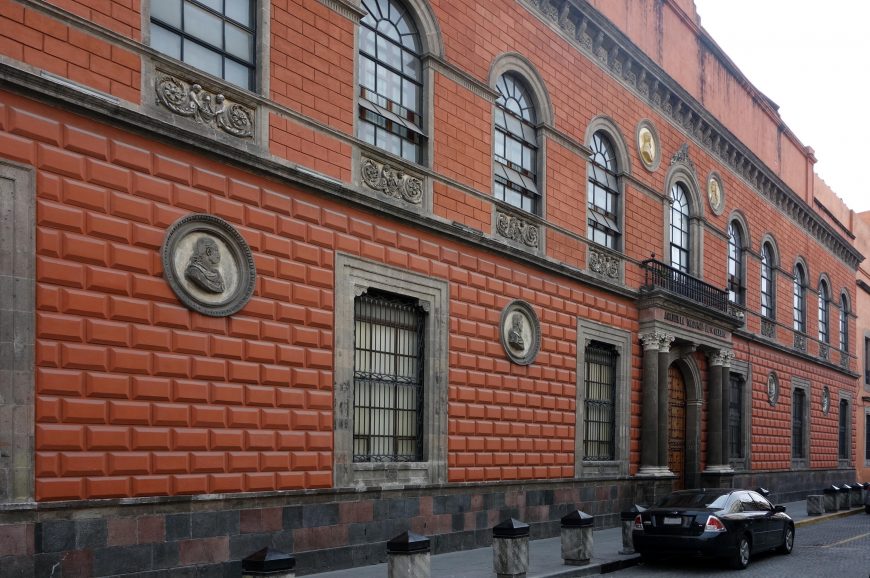
From its beginnings in the sixteenth century, the Viceroyalty of New Spain had been home to many accomplished artists. Some of these were Amerindian artists who used their knowledge of sculpture and graphic arts to produce works for conventos and codices; others, were of Spanish birth or heritage and worked mainly in the tradition of European painting and sculpture. By the eighteenth century, this European-based tradition had gained enough popularity and renown in New Spain that prominent artists such as Miguel Cabrera began to advocate for the establishment of an official art academy in Mexico City.
An official art academy for New Spain
Spain established the Academy of San Fernando in 1752 in Madrid—an official art school that, like art other academies across Europe, was designed to train artists in drawing, painting, and sculpture. This became the model for the earliest art academy in the Americas—the Academy of San Carlos in Mexico City, founded in 1785 under the leadership of Spanish engraver Jerónimo Antonio Gil (see medal above). Most of the faculty members were, like Gil, of Spanish descent, and the artistic lessons promulgated at San Carlos were likewise similar to those taught at the Academy of San Fernando across the Atlantic Ocean.
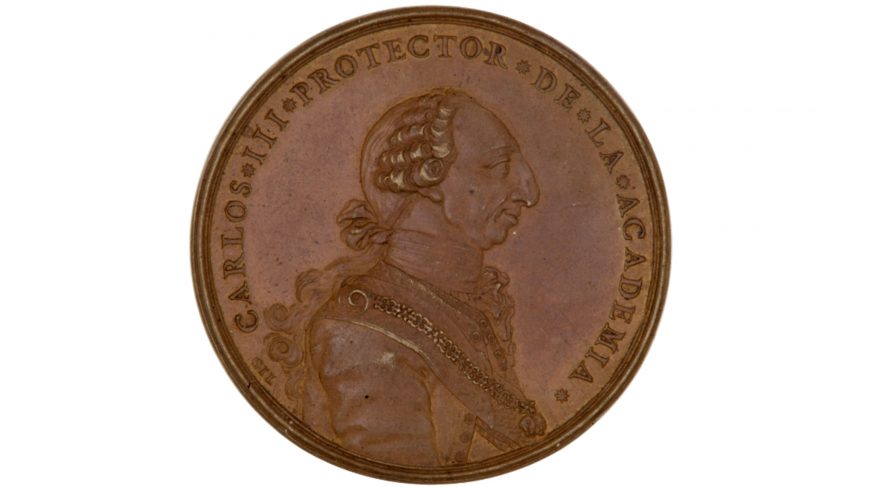
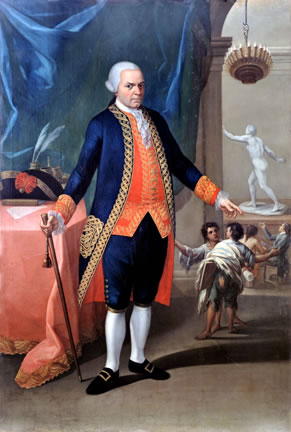
Gil developed an arts curriculum that included engraving, sculpture, painting, and architecture. As in the European academies, all students began their artistic education by first drawing from two-dimensional models (prints and drawings) and then progressing to three-dimensional examples, often plaster copies of classical statuary such as the Nike of Samothrace, which later decorated the courtyard of the Academy of San Carlos (this sculpture was excavated in 1863 but illustrates the use of casts of antiquities for study at the Academy). The collection of copies of classical sculpture—allude to the fact that art instruction at the academy was centered on Neoclassicism, a style of the late-eighteenth and early-nineteenth centuries that sought to emulate the classical art of ancient Greece and Rome. A distinguishing characteristic of Neoclassicism, and one that paralleled the artistic vision of Gil, was the crisp delineation of form, which placed an emphasis on line rather than color (hence the academy’s focus on drawing in the curriculum). The recent archeological discovery of ancient Roman sites such as Herculaneum and Pompeii inspired both the interest in the classical (ancient Greek and Roman) style as well as moralizing subjects about patriotism, nationalism, and courage—ideals founded in 18th century Enlightenment philosophy that helped inspire the Mexican independence movement.
Art education in a colonial context
Andrés López’s Portrait of Don Matías de Galvez y Gallardo as Vice Protector of the Academy of San Carlos provides a view of the school and its students, as much as of its director, the Viceroy of New Spain (a viceroy rules a colony on behalf of a king), whose portrait it shows. While the Viceroy commands the viewer’s attention in the foreground, one cannot help but be distracted by the background where we see two mestizo children in tattered clothes make their way towards the background where drawing students measure a classical sculpture in order to faithfully render it on paper. What this scene implies is that, through attendance at the Academy, unruly children are transformed into disciplined students, from provincial artisans to sophisticated artists. Additionally, by depicting the Viceroy as pointing towards the two children, the López alludes to the mission of the Academy—to educate and professionalize artists, including those of mixed heritage. This depiction of unruly mestizo children also serves as a reminder that the goal of the Spanish colonizers in Latin America was to “civilize” the indigenous population in all aspects of daily life—including religion and art.
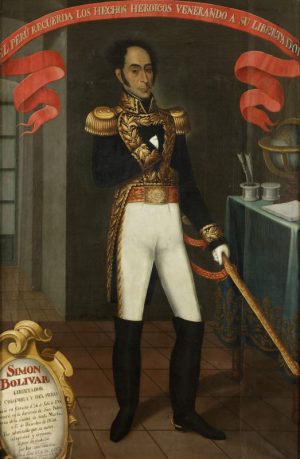
Students at the Academy of San Carlos were not only transformed into artists; they were also made more cosmopolitan, since their education was formally aligned with Europe. However, this cosmopolitanism was not a simple adoption of European ideas and techniques. The art historian Maria Fernández writes that “far from passively absorbing and naively imitating European trends, Mexican cosmopolitanism in the visual arts manifests as active exchanges: adaptations, translations, innovations, and deliberate contestations of European hegemony.”1 Latin American artists, whether trained at the academy or abroad, did not passively imitate international trends, but rather adapted and localized them.
Neoclassical style, indigenous themes
In portraiture, such as in Gil de Castro’s Portrait of Bolívar in Bogotá, as well as in history painting, Neoclassicism was considered the academic style par excellence. As in Europe, Neoclassicism allowed Latin American artists to address nationalist values that were rooted in the present yet informed by the classical past. Mexican painters such as Juan Cordero, who had trained at the Academy of San Carlos and in Rome, adapted quickly to this new mode of representation. In 1850, while in Italy, Cordero painted Christopher Columbus at the Court of the Catholic Monarchs, shown at the 1851 exhibition of the Academy of San Carlos.Columbus Before the Catholic Monarchs was a turning point in the career of Cordero and in the history of Mexican art, and became one of the first paintings by a Mexican artist to depict a scene from colonial history.
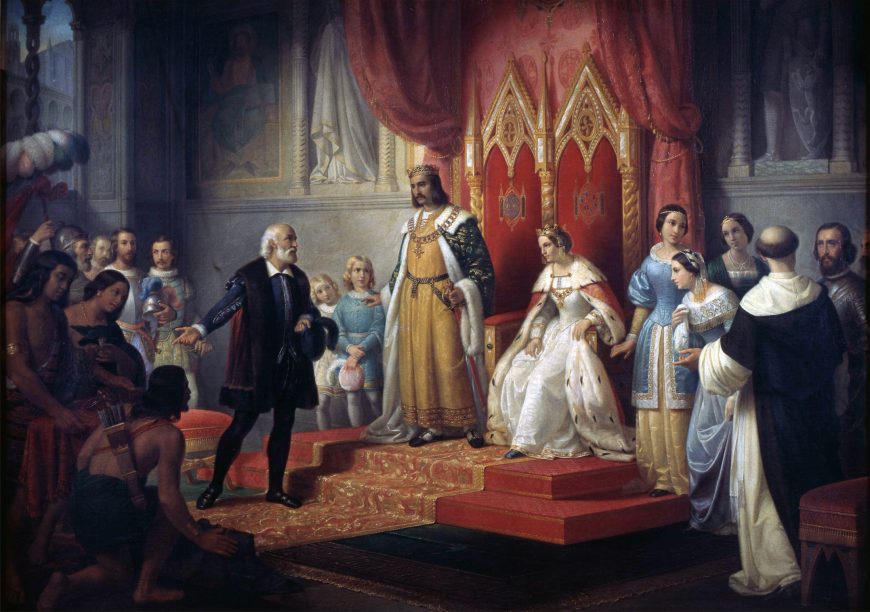
In 1869, director Ramón Alcaraz introduced a prize in the category of history painting for the exhibitions held at the Academy of San Carlos. Indigenous subjects dominated the genre of history painting until 1881 in large part due to the restoration of the Republic in 1867 and the triumph of Mexico’s first indigenous president, Benito Juárez. In Félix Parra’s Episodes of the Conquest: Massacre of Cholula, the Spanish conquest is not depicted in the context of discovery, as it was in Cordero’s work, but rather in the context of tragedy. Parra documents the bloody execution of the residents of Cholula by the Spanish conquistador Hernan Cortés, who stands proudly at the center. As Cortés’s men plunder the city of Cholula, exemplified by the figure at the right who greedily examines an object of value, the remaining victims try to save themselves and their families. A woman at left leans over her child, perhaps dead, in order to reach her deceased husband, who lies on his back with his arms outstretched, recalling the martyred image of Jesus on the cross.
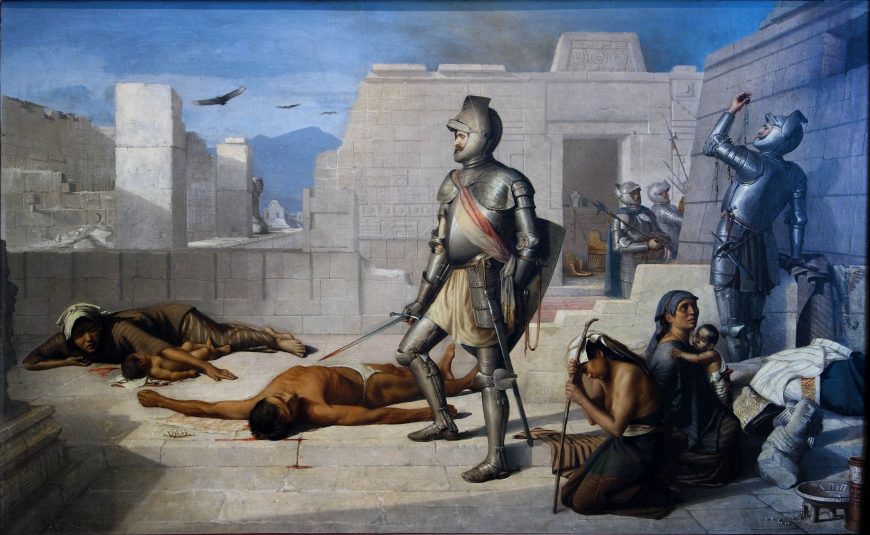
On the other hand, José Obregón’s The Discovery of Pulque is entirely indigenous in subject matter, documenting an event that took place before the time of the Spanish Conquest. Obregón depicts a young woman, Xochitl, offering pulque, a viscous alcoholic beverage made of maguey plants, to the Aztec Emperor Tecpancaltzin, shown seated on his throne. A woman at the far left holds the actual maguey plant, considered sacred to the Aztecs. She and her companions appear humble because of their tattered clothes and subjugated poses, while the men to the right of the composition, surrounding the Aztec emperor, are clearly of a higher status, as reflected in their feathered headdresses.
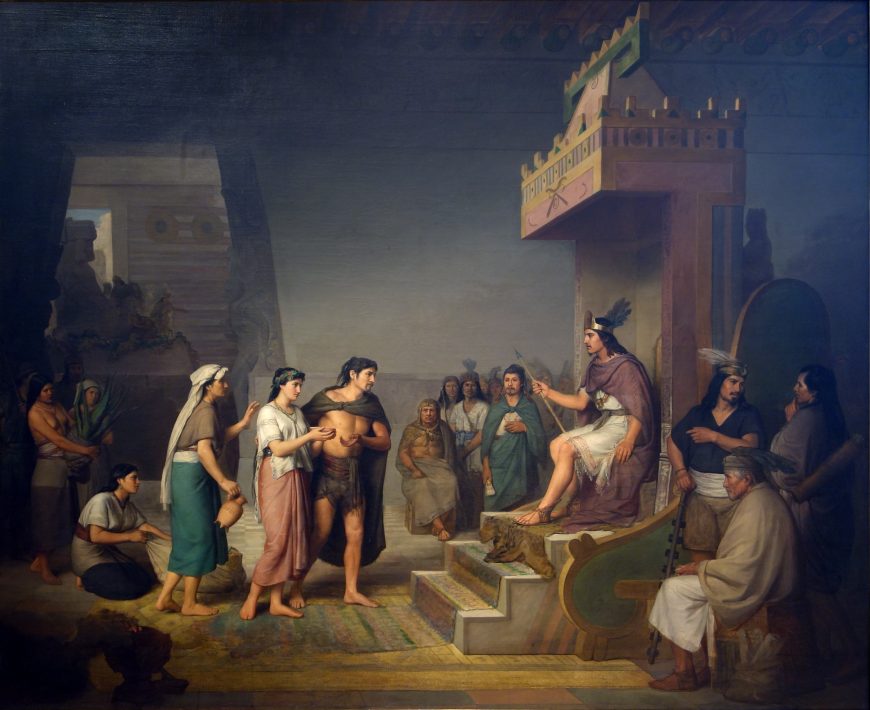
In keeping with his interest in classicism, Obregón depicts the scene according to the principle of “noble simplicity and quiet grandeur” which the German art historian Johann Joachim Winckelmann articulated in Reflections on the Painting and Sculpture of the Greeks in 1755. Rather than portray the figures in this history painting with dramatic gestures, as might befit such an event, the artist depicts the calm and serene poses typical of classical art. Yet by classicizing Mexico’s pre-Hispanic past, Obregón Europeanized his indigenous subjects demonstrating his adaptation rather than imitation of European trends.
Obregón’s The Discovery of Pulque is further fictionalized, since this drink was known to Mesoamerican cultures before the Aztecs. By presenting the beverage within the context of discovery, Obregón’s painting speaks to European interest in innovation, invention, and exploration. Nevertheless, by representing the Aztec as the cultivators of maguey plants and creators of pulque, Obregón counters the prevalent iconography of the era that commonly depicted the Spanish, not the indigenous people, as “discoverers” and “creators,” as seen in Cordero’s Columbus Before the Catholic Monarchs.
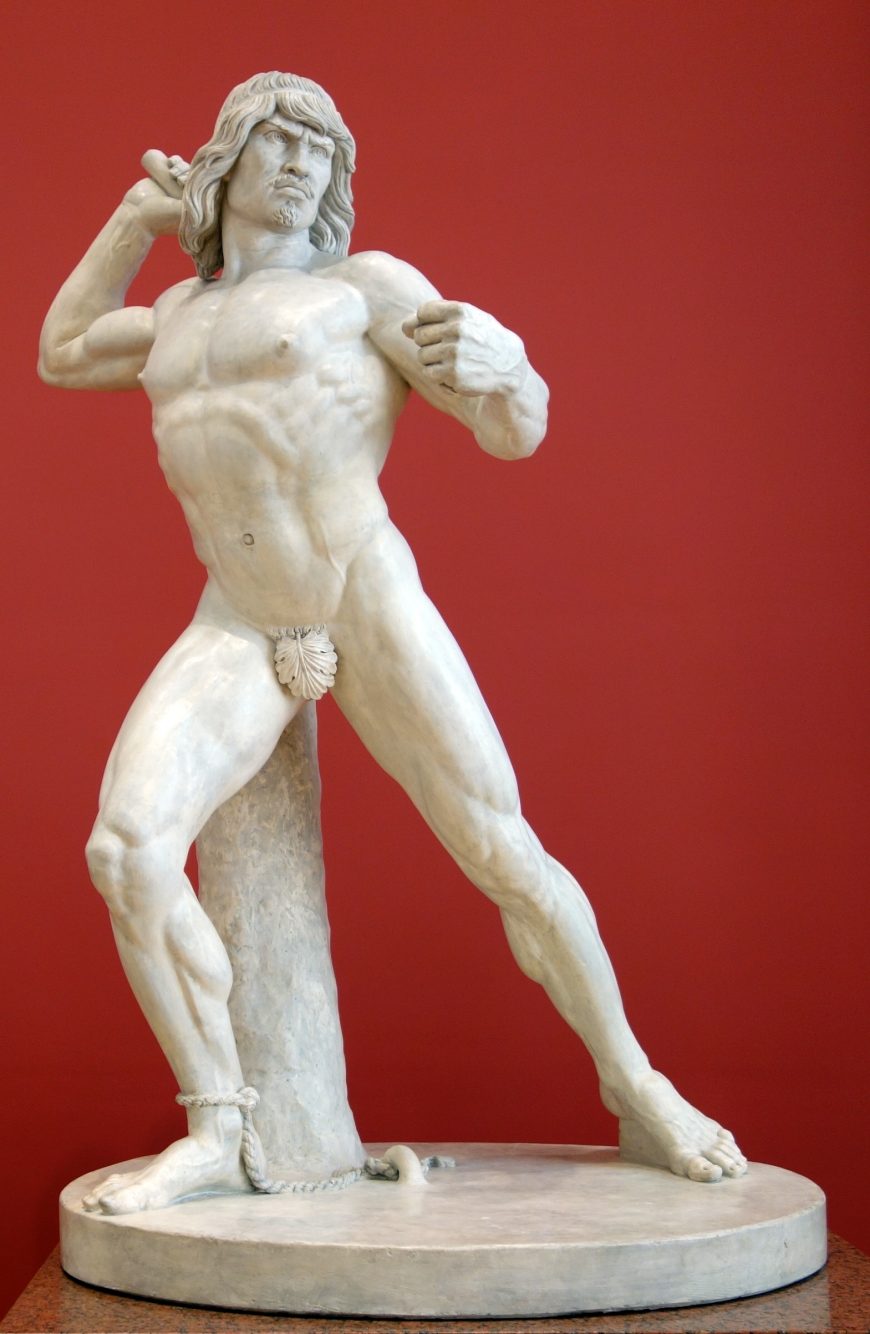
The Spanish-born sculptor Manuel Vilar also capitalized on the glorification of the indigenous people, as seen in his larger-than-life size sculpture, The Tlaxcalan General Tlahuicole Doing Battle on the Gladiator’s Stone of Sacrifice. Captured by the Aztecs during a flowery war against Tlaxcala, Tlahuicole was taken prisoner; however, after defeating various warriors, he was pardoned and asked to join the Aztec army. Tlahuicole declined the offer and instead accepted his fate in a ritual sacrifice. Depicted in a heroic and idealized state, as noted by his firm stance and idealized body, Vilar adheres to a style of Neoclassicism that he also helped to disseminate at the Academy of San Carlos.
A unique blend
Though artists from New Spain were educated in the latest European trends and techniques at the newly-established Academy of San Carlos, their works nevertheless exemplify a range of solutions to the challenge of representing the complex history and context of New Spain. Interestingly, they achieved this through a complex synthesis of both local and global influences, demonstrating the continuing development of Mexican cosmopolitanism.
Notes:
1. María Fernández, Cosmopolitanism in Mexican Visual Culture (University of Texas Press, 2014), p. 7.
Additional resources:
Mexico and Central America, 1600-1800, essay from The Met’s Heilbrunn Timeline of Art History
Mexican Independence
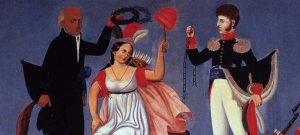
The first two, and most notable, countries in the Americas to gain independence were the United States (1776), led by General George Washington, and Haiti (1804), led by Toussaint L’Ouverture. Other Latin American countries soon followed, with exceptions such as Cuba and Puerto Rico, embarking on their struggles for independence in the early nineteenth century. However, since territories were freed in sections with the ultimate goal of liberating an entire viceroyalty, the fight for independence came slowly and in stages.
Mexican independence
The Mexican struggle for independence began with the Grito de Dolores (Cry of Dolores). In September of 1810, Miguel Hidalgo, the parish priest of the small town of Dolores in central Mexico, uttered the country’s cry for independence. He called not only for liberation from Spain, but also for the end of slavery and the return of lands to the indigenous inhabitants. A highly educated creole, Hidalgo had read the works of Enlightenment writers and had been an important community organizer in Dolores. While Hidalgo’s efforts led to both the stripping of his priestly title and his gruesome execution, his cry set in motion the Mexican fight for independence.

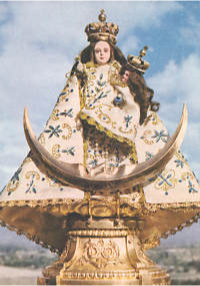
Hidalgo’s visual trademarks were his baldness and religious dress—both shown in Antonio Serrano’s Portrait of Miguel Hidalgo (above). He is depicted inside his study, minimally decorated with books, a desk, and a small reproduction of the Virgin of Guadalupe (below). While the library reflects Hidalgo’s erudition, the depiction of the iconic Virgin of Guadalupe alludes to both his faith and the image’s historical significance in the struggle for independence: Hidalgo marched with a banner decorated with the Virgin of Guadalupe, a foil to the Virgin of los Remedios (left), which was used by the Spanish loyalists. In this way, the Virgin of Guadalupe became a symbol of Mexican resistance and independence, and was featured on the earliest Mexican flag.
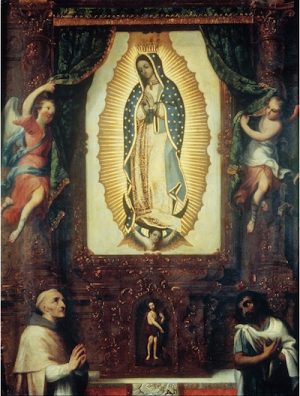
After Hidalgo’s failed attempts at instigating a revolution, José María Morelos, another revolutionary priest, and the army general Agustín Iturbide continued the struggle (IIturbide had originally fought for the Spanish royalists, but he switched sides following his dismissal from the armed forces due to accusations of unwarranted violence and misuse of funds). The Plan of Iguala, a proclamation which Iturbide authored together with the rebel leader Vicente Guerrero in 1821, proclaimed Mexico’s independence from Spain while reaffirming the country’s alliance with the Roman Catholic Church and establishing equal rights for both criollos and peninsulares. On August 24, 1821, with the signing of the Treaty of Córdoba, Spain finally recognized the independence of the First Mexican Empire, led by none other than Iturbide himself.
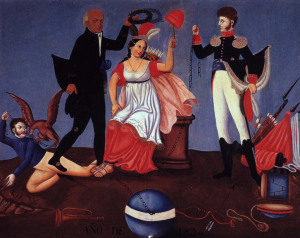
An allegorical history painting
In Mexico, historical narratives were often symbolically depicted, as in Allegory of Independence (above) by an unknown painter. The seated figure, an allegorical (symbolic) representation of Independence, is adorned with Mexican accessories such as an Aztec feathered headdress; however, she also holds a Phrygian cap, a symbol of freedom usually associated with the French Revolution. She is flanked by the figures of Hidalgo (on the left) and Iturbide (on the right)—portrayed here as the fathers of Mexican independence. Hidalgo crowns Independence’s head with laurels (a classical sign of victory), while Iturbide breaks the chains of enslavement. In terms of her ethnicity, Independence appears closer to the depiction of Iturbide than to Hidalgo, whose skin tone reflects Amerindian ancestry, even though he was a Creole (criollo). Hidalgo and Independence step on a figure who represents despotism, and who is being shooed away by the eagle, a symbolic reference to the Aztecs. Together, these symbols of Mexican independence articulate both a sense of pride in Aztec ancestry and an appreciation for European ideas of liberty. With their depictions of potently symbolic figures and themes, such paintings energized the struggles for Latin American independence and aided in the creation of national unity.
José María Velasco, The Valley of Mexico from the Santa Isabel Mountain Range
Video \(\PageIndex{40}\): José María Velasco, The Valley of Mexico from the Santa Isabel Mountain Range (Valle de México desde el cerro de Santa Isabel),1875, oil on canvas, 137.5 x 226 cm (Museo Nacional de Arte, INBA, Mexico City)

Academy of San Carlos
Did you know that the first art school in the Americas was established in Mexico City in the late eighteenth century? Creole artists (of European descent born in the Spanish Americas) in preceding decades had failed to convince the Spanish king to create a pedagogical artistic institution. Nevertheless, by the end of the eighteenth century, the Royal Academy of San Carlos (Real Academia de San Carlos) was established. It was modeled after the Art Academy of San Fernando in Madrid, and consequently, a new chapter of Mexican art history began.

Pure landscape
This important school fostered Romantic and Neoclassical aesthetics through previously unexplored genres of painting. For example, beginning in the nineteenth century, students emerging from the new school at the Academy began to illustrate local vistas of the Valley of Mexico. The development of these images offered the perfect opportunity for artists to explore the Romantic qualities of “pure landscape,” which in Mexico, through the teachings of the Italian professor Eugenio Landesio, emerged as a popular genre in the Academy. However, and as observed in Velasco’s The Valley of Mexico from the Hillside of Santa Isabel (above), the valley represented much more than a mere opportunity to practice this newly established genre of painting. This imagery offered an opportunity to highlight symbols of patriotism valuable to a newly independent society.

After the 1821 war of independence (from Spain), Mexico sought to establish its identity through artistic endeavors. The development of the practice of national landscape painting was part of the dictator López de Santa Anna’s efforts to re-establish the art academy after decades of neglect following the formation of Mexico as an independent nation. The Italian artist Eugenio Landesio (who was a well-regarded artist in Mexico) was appointed as the academy’s professor of perspective and landscape painting in 1855. His mentorship and his experience uniting ancient and contemporary Roman historical subjects in his canvasses forever changed the history of Mexican landscape painting.

Monumentality
While Eugenio Landesio and his contemporaries had created similar landscapes of the Valley, Velasco presented a monumentality and an open quality to his images that surpassed compositions such as El Valle de Mexico desde el Cerro del Tenayo (above) created by his Italian mentor only a few years earlier. Velasco’s compositions united pre-Hispanic symbols and contemporary national sentiments. For example, the white peaks that predominate his vistas are the Popocatepetl and Iztacchihuatl volcanoes. For centuries the land’s romantic topology has captured the imagination of Mexicans. Prior to the arrival of the Spanish to the Valley of Mexico in 1519, these two volcanoes were the main characters of a legendary ill-fated love between an Aztec princess (Iztacchihuatl, or “white woman”) and a courageous warrior (Popocatepetl, or “smoking mountain”).

Towards the composition’s background, the spectator can admire the receding waters of Lake Texcoco and the contours of Mexico City. The ancient Aztec capital of Tenochtitlan was founded in the middle of this lake in 1325. This was a familiar site for Velasco, given that the artist’s home was located at the foot of the small hill shown in the middle of the canvas. This unassuming hill was also an important sacred colonial site where the Virgin of Guadalupe first appeared to the indigenous man Juan Diego in 1531. The artist is known to have painted in this location many times. This version of The Valley of Mexico from the Hillside of Santa Isabel is perhaps the most celebrated of a dozen or so images with the same subject done by the artist between 1875 and 1892. At one point, the brushstrokes that form the peaks of the snow-covered volcanoes, the rock formations and other details were done from memory, making it possible for the artist to change and manipulate the details of the landscape as he saw fit.

German Romanticism
The Valley of Mexico from the Hillside of Santa Isabel can be viewed as a re-interpretation of the common late eighteenth-century German subject, “pastoral idylls,” where a sense of poetic harmony and daily life were united. In the tradition of artists such as Casper David Friedrich (above) and Joseph Anton Koch, Velasco introduces his figures (below) not as mere staffage, or accessories enhancing the rest of the artwork, but as key components behind the composition’s poetics. Similar to his German predecessors, Velasco explored the romantic relationship between human figures and the scenery they inhabit. Two indigenous individuals are presented in transit from the city to the country, reflecting a romantic, yet difficult socio-economic relationship between people and their ancestral land. The figures’ indigenous garments intrinsically relate to the national iconography displayed throughout the image. In the words of the German poet Johann Christoph Friedrich von Schiller, the figures in a landscape must represent “a humanity reconciled with itself…nature purified, raised to its highest moral dignity…the ideal beauty applied to real life.”¹ Velasco has produced an image where national pride, romantic poetry, and daily life blend to transform the Valley of Mexico into a Romantic masterpiece.

Overall, The Valley of Mexico from the Hillside of Santa Isabel represents an important period in the development of Mexico’s national identity and an important chapter in the history of Mexican art. Velasco’s landscapes became symbols of the nation as they represented Mexico in several World Fairs. The union of romantic European sensibilities and the historical allegories observed in his compositions won him important recognition in Chicago, Paris and Philadelphia in the late nineteenth century.
Essay by Emmanuel Ortega Rodríguez
1. Hilliard T Goldfarb, “Defining ‘Naive and Sentimental’ Landscape Schiller, Hackert, Koch, and the Romantic Experience,” The Bulletin of the Cleveland Museum of Art , vol. 69, No. 9 (Nov., 1982), pp. 291.
Additional resources:
Smarthistory images for teaching and learning:

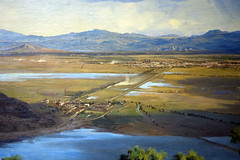
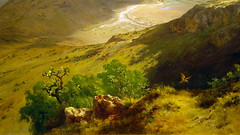
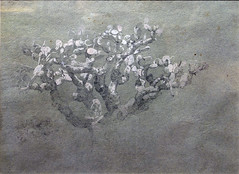
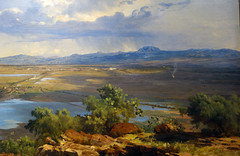


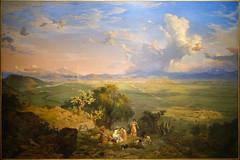
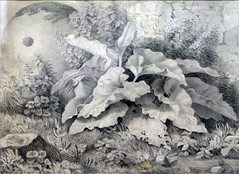
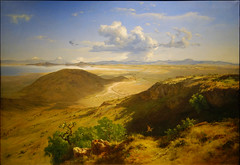
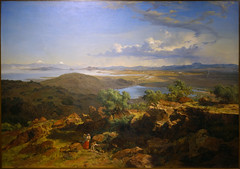
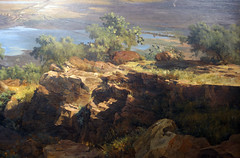

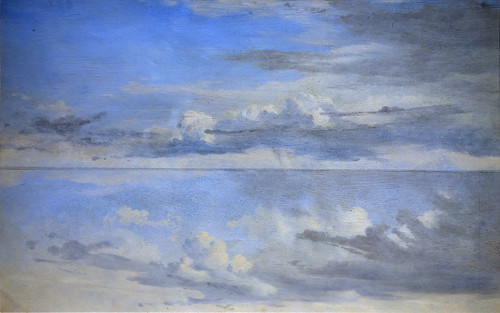
Picturing Racial and Social Identities in José Agustín Arrieta’s Costumbrista Painting, La Sorpreza
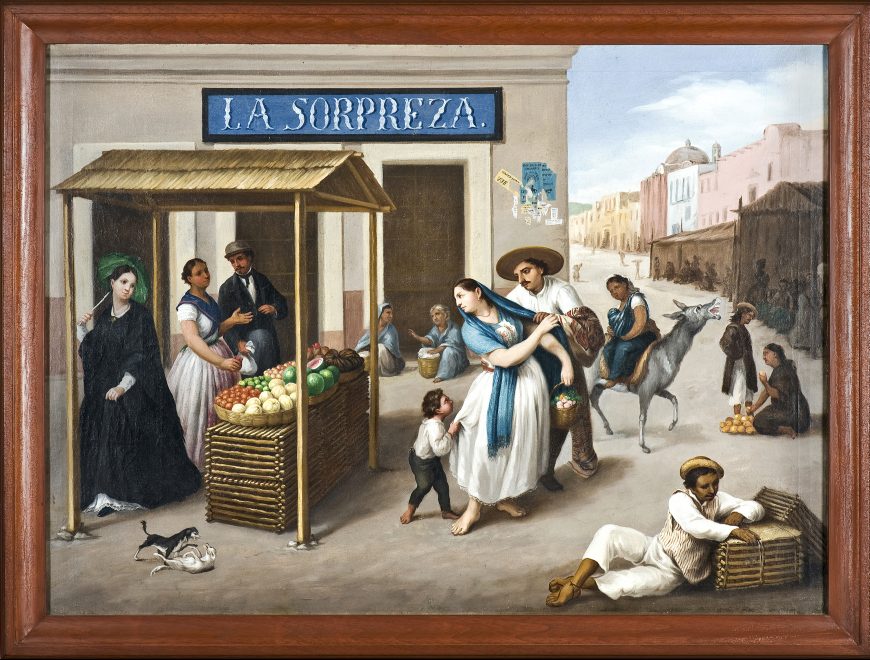
In José Agustín Arrieta’s costumbrista painting, La Sorpreza (The Surprise, 1850), viewers are invited to ponder the surprise(s) the painting holds. This fictional, theatrical composition, loosely based on reality, encourages multiple narratives. Nineteenth-century costumbrista paintings were concerned with representing customs, traditions, and costumes of everyday people and their lives.
In La Sorpreza, we see a lively commingling of different types of people of various racial and social classes and occupations. The figures are depicted in an outdoor, public marketplace outside of an establishment, a pulquería (a tavern that sells the alcoholic beverage pulque, made from fermented maguey sap) called La Sorpreza, which gives the painting its name.
Drawing on the casta painting tradition
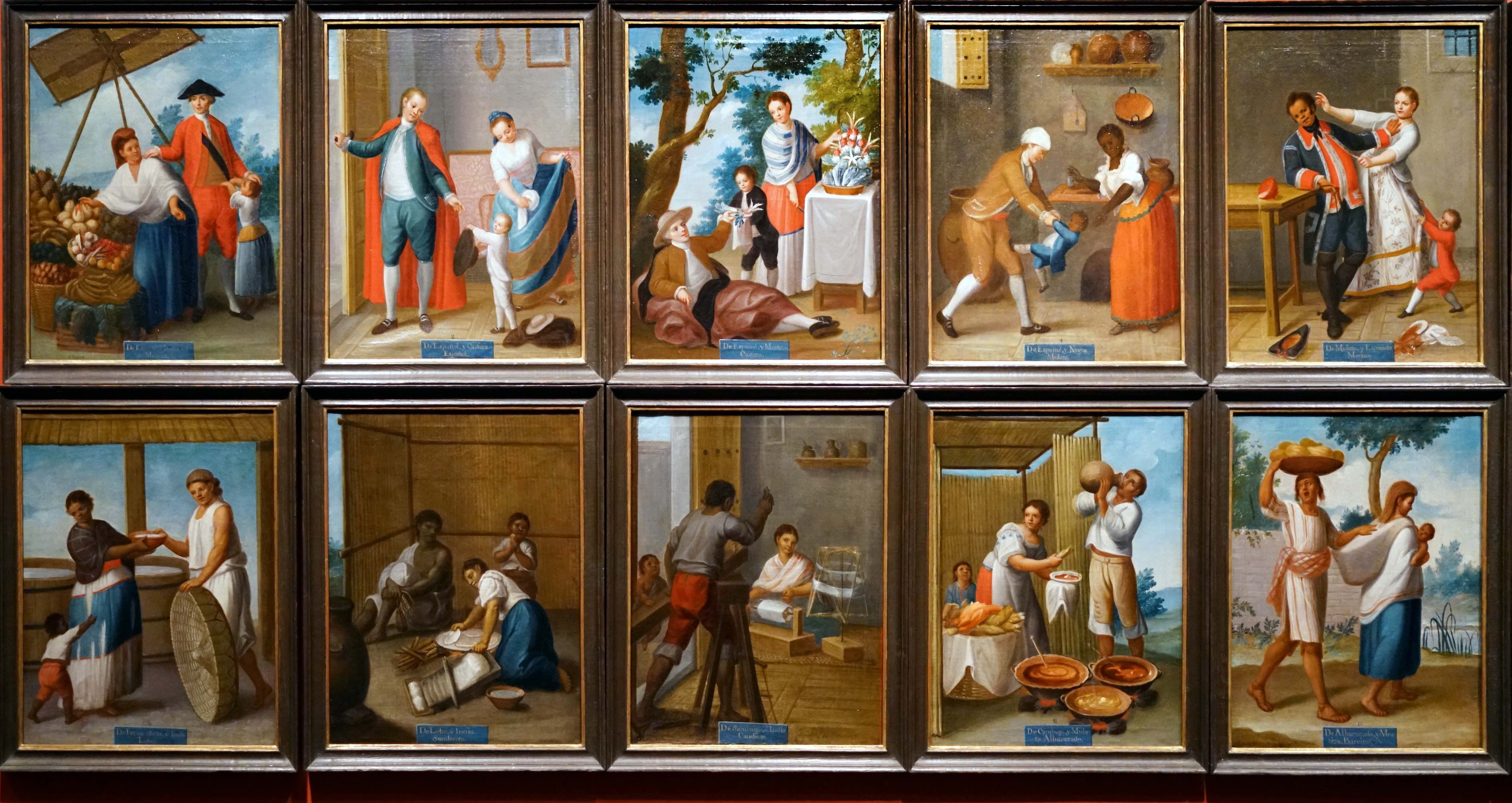
Nineteenth-century costumbrista painting borrows certain tropes from eighteenth-century casta painting. Casta paintings were a unique genre in colonial Mexico and Peru that represented racially mixed families in a set of 14 to 16 canvases. Each canvas depicted a father and mother of different races, and one to two of their children, and included a label that described the figures (for example, De Espanol, e India, nace Mestiza — From a Spaniard and Indian, a Mestiza is born — Mestiza refers to a child of Spanish and Amerindian parents).
As art historian Ilona Katzew demonstrates, casta paintings followed the Enlightenment trend of classifying and categorizing social and racial types, but also reaffirmed a social hierarchy in colonial Spanish America that privileged white Europeans.[1] In general, the more “white” a family was, the higher they were placed on the socio-racial hierarchical ladder. Oftentimes what distinguished racial types from one another was not solely skin color, but rather clothing, accessories, and setting, which alluded to one’s occupation, wealth, and status. Since visual markers alone were insufficient to ensure proper classification, textual inscriptions provided necessary clarification as to the racial types represented.
Costumbrista paintings, like casta paintings, often portray social and racial popular types identifiable by occupation and family units, but instead of being separated into distinct canvases they are now united into a single composition. Both casta and costumbrista paintings also depict racialized social spaces, that is, settings where racial, social, and gender relationships were imagined and visualized. [2] These spaces serve to further locate the represented types in a hierarchical order.
Although in post-Independence Mexico the complex casta nomenclature was no longer legally valid (casta designations were banned in legal records in 1822), its classifications still resonated for individuals of mixed races who continued to exist and intermingle on a daily basis. Arrieta captured these ubiquitous interactions among Mexico’s diverse populace within his costumbrista paintings.
Social and racial interactions
In La Sorpreza, racial mixes are no longer identifiable by inscriptions as in casta paintings, so costumbrista paintings like Arrieta’s provide other clues to indicate the various social and racial types in the scene. In fact, perhaps Arrieta’s “surprise” alludes to the unexpected racial mixtures present and the viewer’s invitation to identify them. He seems to purposefully play with and entice the viewer with his ambiguous title.
The focal point of Arrieta’s composition is the barefooted woman at the center who receives attention from both a small boy (her son?) who tugs at her dress and a man (a suitor? her husband?) who pulls her toward him. She is dressed simply in a white cotton dress; the blue rebozo (shawl) draped over her head draws attention to her face, which is shown in profile as she looks over her right shoulder. Her large, bare feet identify her as someone of the lower classes: perhaps a mestiza? Or cambuja? Or loba? [3]
It is possible that this painting displays a dispute between the man and the woman, as there appears to be a physical struggle between them. Another possibility is that of a social or racial dispute. The central grouping composed of a man, woman, and child, is akin to the family unit seen in casta painting.
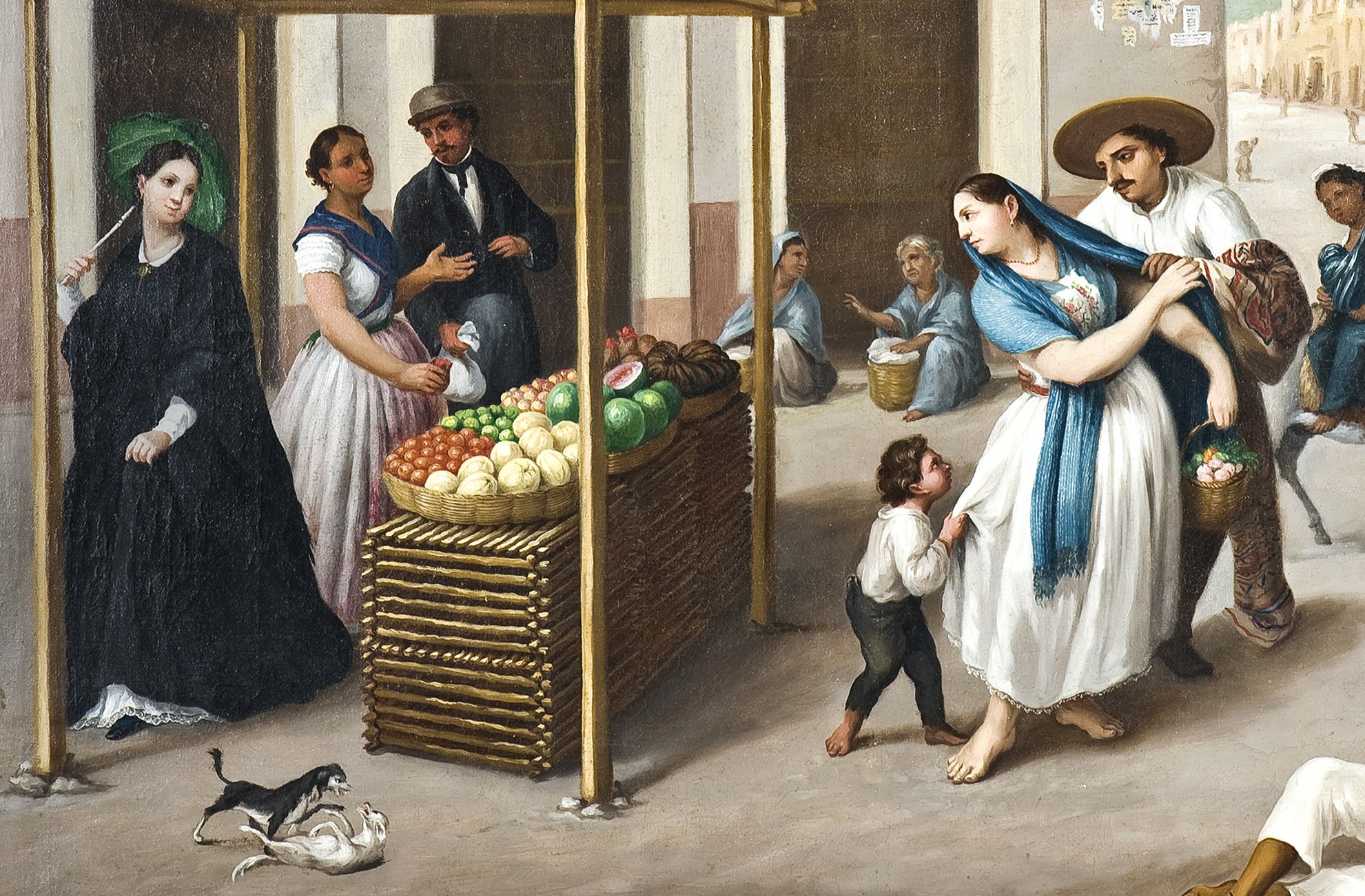
The central female figure in the blue rebozo may be arguing with the higher-class woman in an elegant black dress and parasol (presumably a criolla, a Spaniard born in the Americas), who glides along the left-hand side of the composition. Notice the way in which the women’s heads lean towards one another while their arms move in the opposite direction; even the curves of their bodies almost form parentheses around the action. As such, the mustached man is not the cause of the woman’s distress, instead he is attempting to assuage the altercation between the two women.
What about the dogs?
The two small dogs that play in the left foreground close to the criolla offer a subtle clue as to the possible outcome of the heated discussion between the women in the scene. Here, presumptions about racial differences are displaced from human beings to animals: the black dog tackles the weaker white dog, reminding the viewer of the stereotype that African and Indian races were thought to be subject to uncontrollable streaks of hostility and passion.
This bias was visualized during the colonial era when casta paintings occasionally featured African women acting out aggressively. This violent streak believed to be inherent in African behavior is shown in the fourth panel of Andrés de Islas’s 1774 casta series, De español y negra, nace mulata (From Spaniard and Black, a Mulatta is Born). Here the African mother is portrayed hitting her Spanish husband with a wooden cooking implement, while her mulata (progeny of a Spaniard and African) daughter (not unlike the small boy in Arrieta’s painting), tugs on her mother’s skirt begging her to stop.
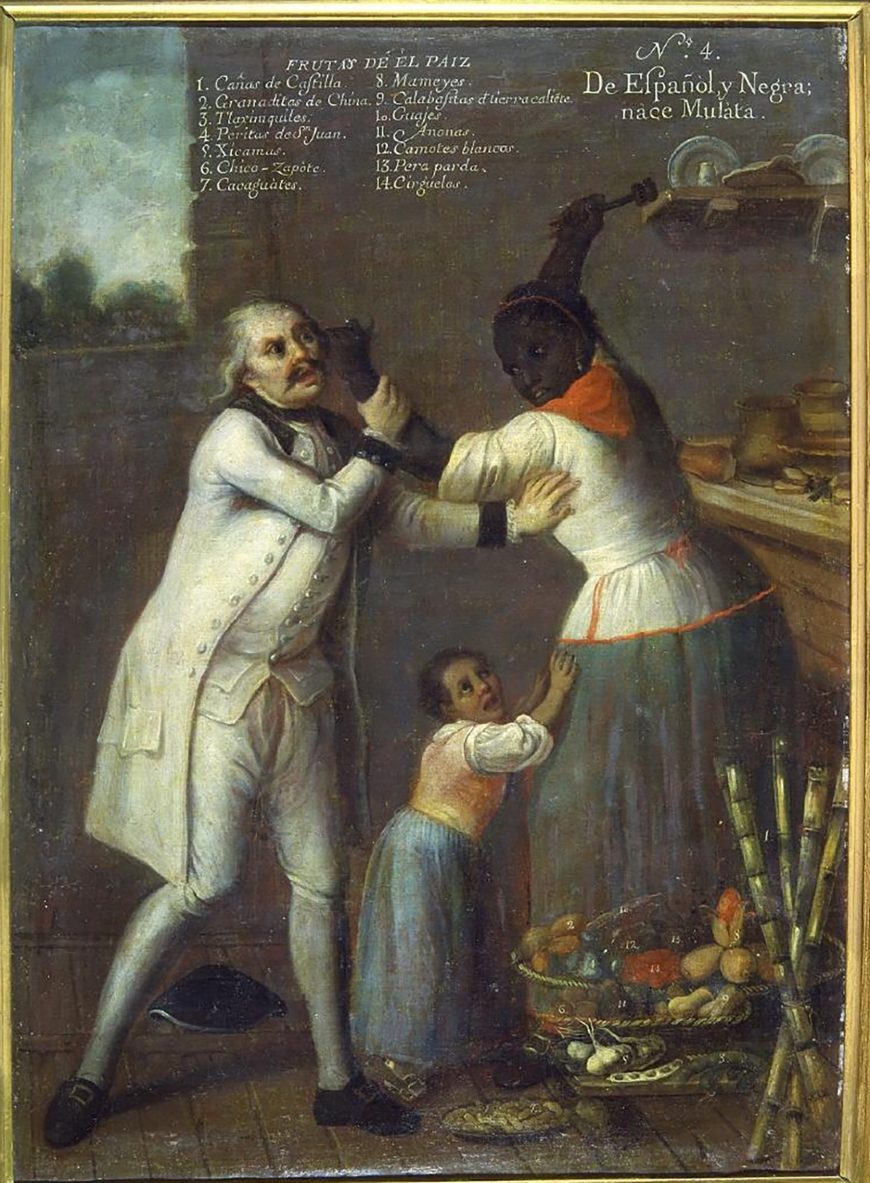
Another possible interpretation is that the owner of both the rather small, delicate dogs is the criolla, and that the black dog that tackles the white dog symbolizes the criolla and mestiza respectively, as reinforced by the color of their dresses. The placement of the black dog on top of the white dog perhaps suggests the criolla as victor. Regardless of the outcome, Arrieta’s imaginative composition invites multiple narratives, and in fact would have served as a conversation starter, displayed prominently in an elite family’s home.
Many patrons of costumbrista paintings were also avid art collectors who purchased a wide variety of luxurious objects, from Spanish Golden Age paintings and Dutch genre prints to rare porcelain from China. Interspersed among these highly prized artworks would have hung costumbrista paintings like Arrieta’s La Sorpreza. In addition to serving as entertainment, they would have highlighted the patron’s wealth and upper-class status, far removed from the lower racially-mixed types they depicted.
Notes:
- Ilona Katzew, Casta Painting: Images of Race in Eighteenth-Century Mexico (New Haven and London: Yale University Press, 2004).
- Mey-Yen Moriuchi, Mexican Costumbrismo: Race, Society, and Identity in Nineteenth-Century Art (University Park, PA: The Pennsylvania State University Press, 2018).
- Casta nomenclature varied and was often derogatory. Mestiza refers to a child of Spanish and Amerindian parents. Cambuja and loba both refer to dark animals, a horse and wolf respectively, and would have referenced progeny of Amerindians and Africans.
Additional resources:
Ilona Katzew, Casta Painting: Images of Race in Eighteenth-Century Mexico (New Haven and London: Yale University Press, 2004).
Reckoning with Mestizaje (from VISTAS, Visual Culture in Spanish America)
Casta painting (from VISTAS, Visual Culture in Spanish America)
Coming of Age in Gutiérrez’s Costumbrista painting, La despedida del joven indio (The Young Indian’s Farewell)
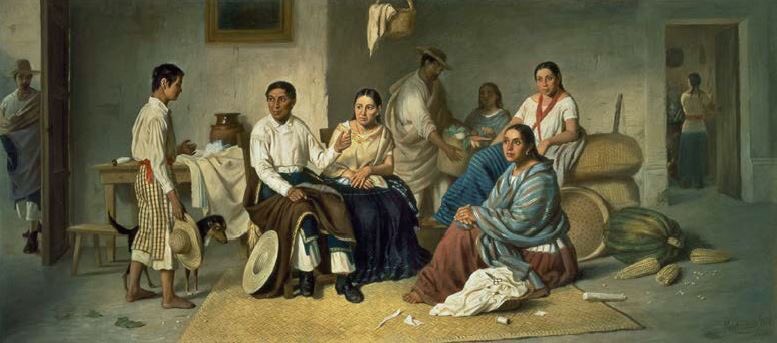
Saying goodbye
Who are the figures gathered in this simple abode? What are they discussing so intently? Where do the doorways on either side of the central scene lead to?
These are just a few of the questions that this composition of everyday Mexican life invites. In La despedida del joven indio (The Young Indian’s Farewell), Felipe Santiago Gutiérrez, one of Mexico’s most versatile and notable nineteenth-century painters, represents a coming of age scene — one with a political and national message. As implied by the title of the painting, a young Amerindian boy who approaches from the left has come to say goodbye to his family, presumably leaving his country life in search of education and a career in the city.
Depictions of Everyday Life
Felipe Santiago Gutiérrez’s La despedida is an example of a costumbrista painting. Costumbrismo, a genre of art and literature in Spain and Latin America, sought to portray local customs and traditions from everyday life, and was popular in the nineteenth century. Gutiérrez was a well-traveled, academically trained artist, who wrote about art exhibitions in prominent journals and even wrote his own artistic treatise, one of the first of its kind by a Mexican artist. He actively produced history paintings and portraits in the prevailing neoclassical style of the academy (El juramento de Bruto, 1857), also producing the first female nude in Mexican art (La cazadora de los Andes, c. 1874). However, it was Costumbrismo that he championed, painting everyday subjects, and advocating for this genre in his many writings.
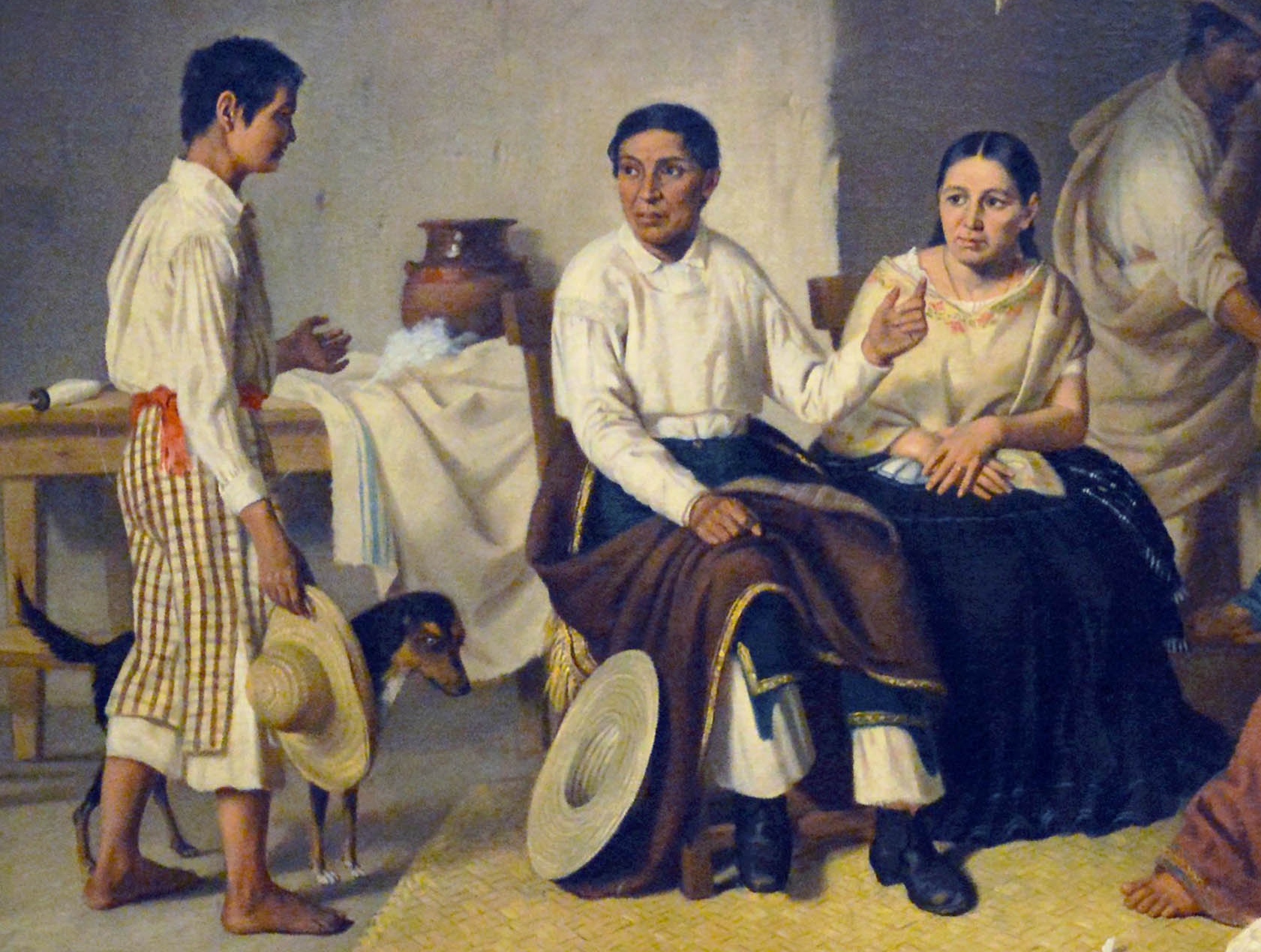
In La despedida del joven indio, Gutiérrez presents the interior of a simple, peasant home. Centrally placed in the composition is a family, perhaps the mother, father and sister of the young Amerindian boy who comes to bid farewell. The boy is barefoot and holds his hat in his right hand while he speaks. His left hand gestures forward as he respectfully addresses his family.
The clean-cut figures are dressed in traditional clothing: rebozos (shawls) and long skirts for the women and a white shirt, wide-legged pants, and a manto (cloak) for the man. Strategically placed objects serve at once to decorate the living space, as well as reference the family’s cultural roots. On the right-hand side, there is a large calabaza (pumpkin) and ears of corn; on the left side, along the wall, there is a table strewn with pottery and textiles. A basket hangs centrally, holding a tablecloth.
Doorways on either side of the family create perspective and add complexity to the interior space. Other family members or friends enter and exit. The doorways that suggest spaces beyond the main room recall seventeenth-century Dutch genre paintings, which use similar compositional strategies to expand interior spaces as well create a bit of intrigue. Having been trained in the academy and exposed to Flemish and Dutch prints, Gutiérrez demonstrates his familiarity with European artistic traditions.
Art and National Identity
La despedida was commissioned by Felipe Sánchez Solís, an Amerindian of humble roots who became a prominent intellectual and political figure in the nineteenth century. Like the figure in the painting, Sánchez Solís left his small village for Mexico City in order to study literature and law, eventually becoming director of the Scientific and Literary Institute of Toluca. Gutiérrez’s painting is therefore both personal and political. The painting refers to Sánchez Solís’s own story as a young boy leaving his family in order to pursue his education and secure his place among Mexico’s intellectual literary elite. This places value on Mexico’s indigenous past while also suggesting an idealized path toward integrating the indigenous in service of the nation. Like Gutiérrez, Sánchez Solís was a patron of the arts and of the academy, and he believed in the importance of the arts in establishing a national identity.
Gutiérrez sought to create art that would change the perception and status of the artist in Mexico, and he wrote about the alliance between artistic culture and nationalistic discourse. Gutiérrez wanted the world—specifically Europe—to know Mexico’s customs, cities, and natural beauty. He believed this would alter Europe’s perception of Mexico as a barbarous, uncivilized nation.
In his treatise, Tratado del Dibujo y la Pintura (Treatise of Drawing and Painting, 1895), Gutiérrez praised the artist of genre paintings,
The genre painter’s scenes are temples, public plazas, the streets and the countryside. His paintings of a fruit vendor, a florist, a group of proud boys that ridicule a drunkard or a blind man who goes door to door, covered in rags, asking for sustenance are lively and poetic. When translated to canvas with the magic of his brush, they cause admiration among his contemporaries and he is glorified for posterity. Felipe Santiago Gutiérrez, Tratado del Dibujo y la Pintura, con un apéndice de los diversos carácteres de las escuelas antigua y moderna (Mexico City: Fondo regional para la cultura y las artes. Zona centro, 1895)
Costumbrista paintings depicted genre scenes particular to Mexican life, aiding in the construction of a Mexican national identity. In Costumbrista paintings like El mendigo (The Beggar) and Mujer indígena con cempasúchil (Indigenous Woman with Marigold), Gutiérrez visualizes his written words. In El mendigo, Gutiérrez depicts a beggar with a majestic presence.
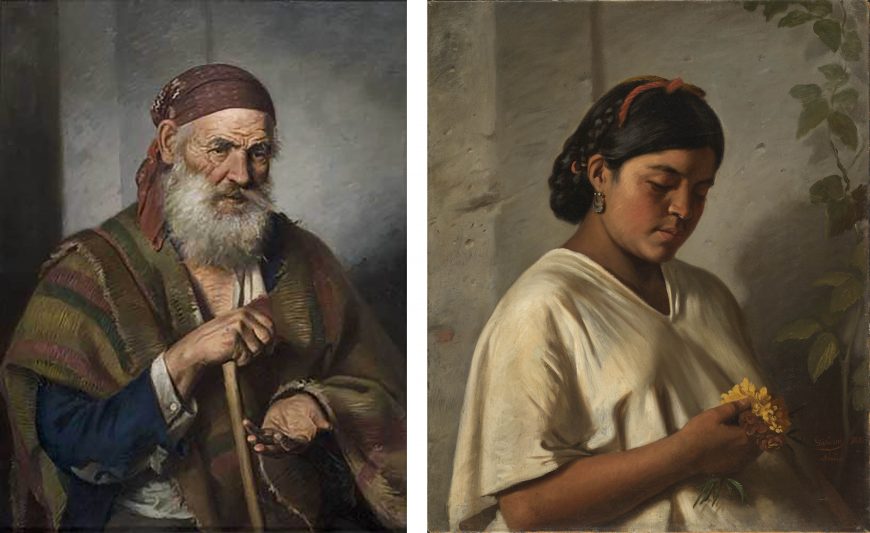
Every wrinkle in the beggar’s kind face is visible. His worn, striped sarape draped over his white cuffed shirt and blue blazer seem to refer to a more affluent past. In Mujer indígena con cempasúchil, Gutiérrez portrays an indigenous, pregnant mother wearing a huipil (a traditional, loose-fitting blouse) contemplating a marigold. The marigold, a flower the Aztecs associated with mortality, was believed to guide the spirits of the dead to the living, and is the traditional flower laid on graves and altars during el Día de los Muertos (Day of the Dead) celebrations. The expecting mother reflects on the fragility of life.
As an academic artist concerned with promoting classical aesthetics and elevating the status of the Mexican artist, Gutiérrez vocalized his conviction that the cultivation of the arts in Mexico and the recognition of the talent of Mexican artists would enable Mexico to achieve the status it deserved. Through his embrace of contemporary subjects and Costumbrismo, Gutiérrez revealed his desire for change and his interest in modernizing his nation, looking to Europe as a model. Gutiérrez’s costumbrista works would find resonance in the art of twentieth-century Mexican modernists like Saturnino Herrán, Diego Rivera, Alfredo Ramos Martínez, Frida Kahlo, and many others, who sought to represent local customs and traditions as symbols of Mexicanidad in the wake of the Mexican Revolution.



